Uniden America UB322 scanning receiver User Manual users manual
Uniden America Corporation scanning receiver users manual
users manual
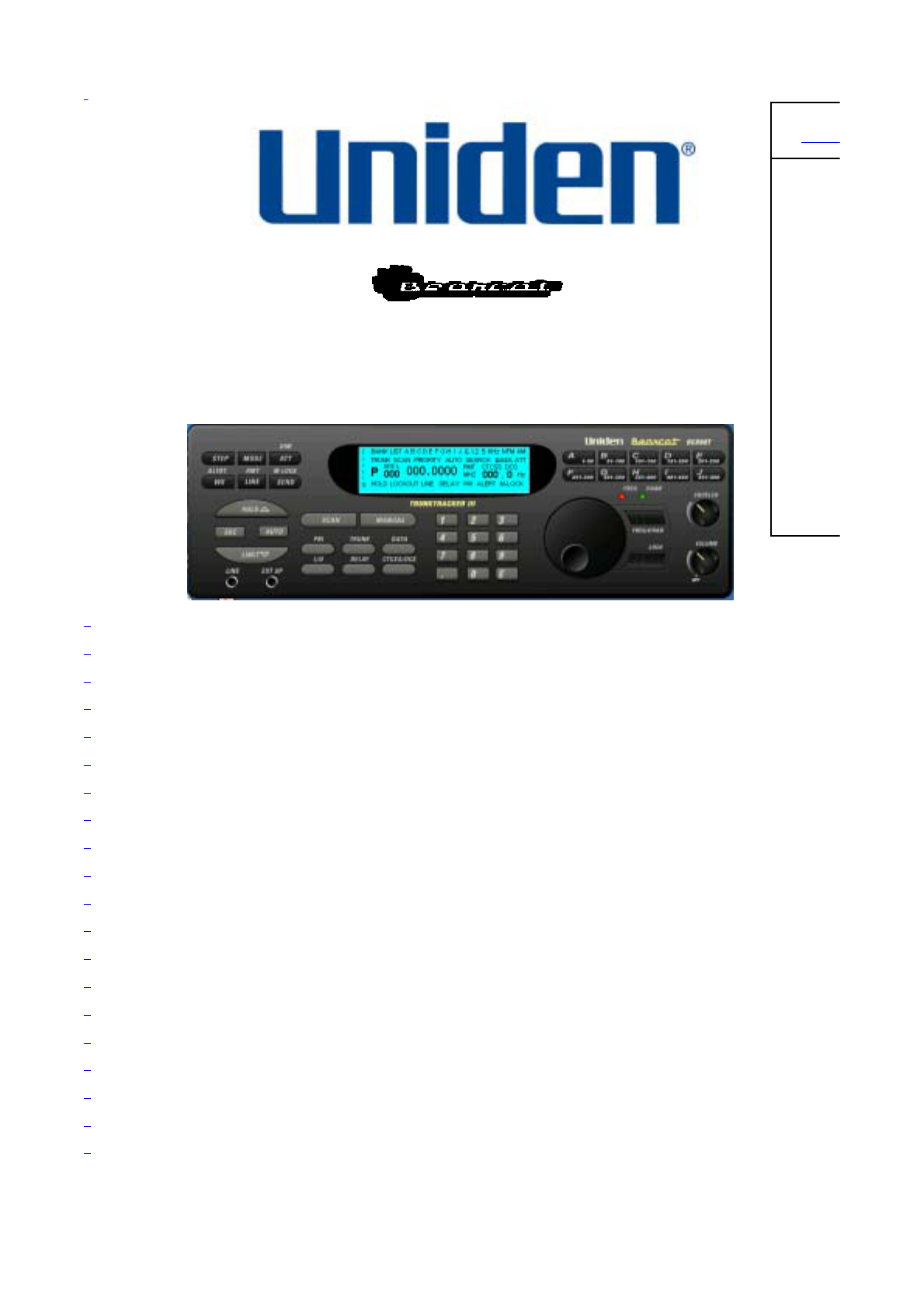
Using
H
BC898T Scanner
1/305 ページCONTENTS
2004/04/01file://¥¥Fileserv0¥OM¥UB322Z_BC898¥Software%20Help.htm

Software Help
Using Help
Viewing Information
You can select information about how to use each category of help
available.
When you click on Using Help, you see the following underlined links:
zViewing Information This link returns you to this introduction.
zUsing the Table of Contents This link displays the table of
contents.
zUsing the Help Map This link displays all subjects available in
Help.
To display a help subject, simply click its link. For example, to display
the help information
available for “base frequency,” click “base frequency” in the index.
Using the Table of Contents
You can select links to all chapter titles in Help by using the Table of
Contents.
To find a subject using the Table of Contents, click Table of Contents
at the top of the right side of the Help window.
Chapter title links appear on the left side of the Help window.
Click a title on the left side of the Help window. That subject appears
on the right side of the Help window.
To see a list of all help topics, use the Help Map.
Using the Help Map
You can select links to all subjects in Help and all entries in the Index.
To find a subject using the Help Map, click Help Map at the top of the
right side of the Help window.
The Help Map appears on the left side of the help window. Scroll up
and down the Help Map until you
find the information you are looking for. To display help for that
information, click on it.
2/305 ページCONTENTS
2004/04/01file://¥¥Fileserv0¥OM¥UB322Z_BC898¥Software%20Help.htm

Table of Contents
Software Help
Using Help
Viewing Information
Using the Table of Contents
Using the Help Map
Help Files
Introduction
System Requirements
How The Software Works
Using The Software
Configuring The Software Using SETUP
Using SCAN Control
Basic Mode
Extended Mode
Using Scanning
Using ID Logging
Using the Database
Using the Bank Editor
Using the Frequency Window
Using the Trunking Window
Using the Trunking Record Window
Using the Reference Database
Opening and Working With Database Files
Copying Records From the Reference Database to the Bank Editor
Owners Manual
The FCC Wants You to Know
Scanning Legally
Important Notice
Precautions
Introduction
Feature Highlights
About This Manual
Understanding Scanning
Understanding Banks and Channels
What is Scanning?
What is Searching?
What is CTCSS/DCS?
Conventional Scanning
Simplex Operation
Repeater Operation
What is Trunk Tracking?
Trunked Scanning
Types of Trunking Systems
Motorola Trunking
EDACS Trunking
LTR Trunking
Using Weather Alert (SAME)
Where to Obtain More Information
Information On The Internet
Using a Computer to Control Your BC898T
A Quick Look at Your Scanner
4/305 ページCONTENTS
2004/04/01file://¥¥Fileserv0¥OM¥UB322Z_BC898¥Software%20Help.htm

Included With Your Scanner
Installing Your Scanner
For Home Use (Desktop Installation)
Adapter Safety Feature
Using An Optional External Speaker/Earphone/Headphone
Listening Safely
Using An Optional Tape Recorder
Using the Supplied Demo Software
Installing The Software
Installing The Scanner In a Vehicle
Mounting the Scanner
Connecting the Antenna Plug
Connecting the DC Power Cord
Installing a Temporary Power Cord:
Installing a Permanent Power Cord
Basic Operation
Turning On the Scanner
Setting the Squelch
Using the Rotary Tuner
Using the Frequency/Channel Mode Selector
Using the Lock Key/LED
Manually Selecting a Channel
Scanning Programmed Channels
Locking/Unlocking Banks
Locking/Unlocking Channels
Restoring All Locked Out Channels
Priority Scanning
Changing the Priority Channel
Using the Dimmer
Trunk Scanning Options
Searching for Active Talk Groups (ID Search)
Searching Only Stored Talk Groups (ID Scan)
Monitoring Talk Group IDs
Holding On a Single Talk Group
Locking Out Talk Groups
Reviewing Locked Out Talk Group IDs
Restoring All Locked Out Talk Group IDs
EDACS Blockout
Setting the Attenuator
Searching
Setting a Single Search Range
Setting a Chain Search Range
Holding On An Active Frequency.
Setting Chain Search
Setting Data Skip
Skipping Frequencies
Storing Found Frequencies
Automatically Storing Frequencies
Setting Subaudible Tones for Searching
Attenuating All Search Ranges
Setting Delay For All Search Ranges
Searching a Trunked Bank
Trunk ID Hold Mode
Using Weather Search and Weather Alert (SAME)
Weather Alert
Searching for a Weather Broadcast
Programming a FIPS Code
Search Hold
Searching for CTCSS/DCS Tones
5/305 ページCONTENTS
2004/04/01file://¥¥Fileserv0¥OM¥UB322Z_BC898¥Software%20Help.htm
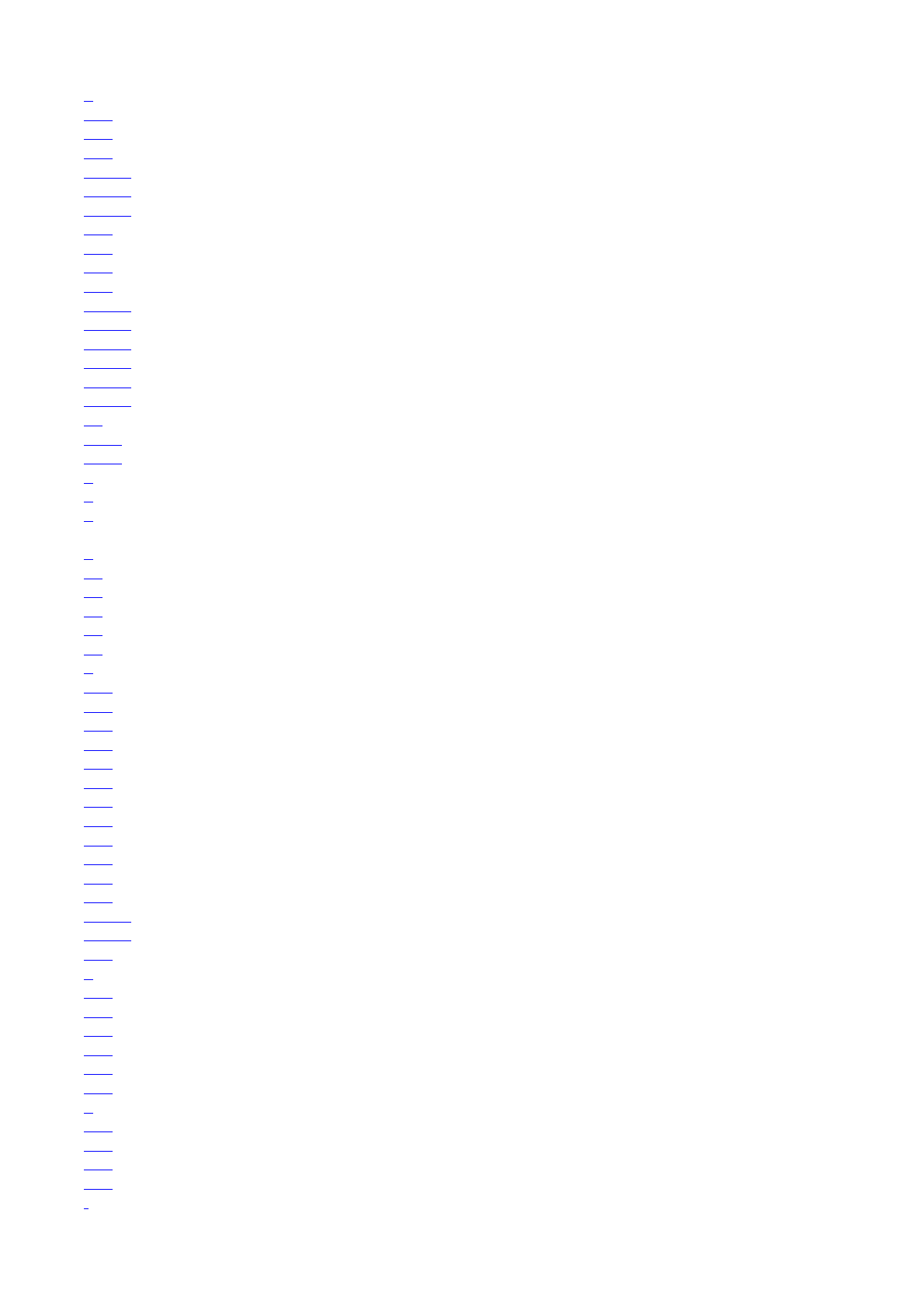
Programming
Programming Using Manual Entry
Programming Using the Rotary Tuner
Programming Using AutoStore
Transferring a Programmed Frequency
Transferring a Frequency to the First Available Channel In Another Bank
Transferring a Frequency to a Specific Channel
Duplicate Frequency Alert
Deleting a Stored Frequency
Programming a Channel With a CTCSS/DCS Tone
Fleet Map Programming
Selecting a Trunking Programming Mode
Selecting a Preset Fleet Map
Programming a Fleet Map
Restoring Default Tracking
Programming a Hybrid System
Programming Tips
Setting the Delay Mode
Setting Delay in Scan or Search Mode
Setting Delay in Manual Mode
Recording Transmissions
Data Skip
Channel Skip
Storing Search Frequencies
Programming Conventional Channels
1. Select a Channel to Program
2. Enter the Frequency
Changing the Frequency Step
Setting the Modulation Mode
Setting Priority Channels
Programming Trunked Systems
Channel Activity Indicators
Programming Motorola Systems
Programming EDACS Systems
Programming LTR Systems
ID Lockout
Restoring a Single ID
Restoring All IDs
Searching Tips
ID Hold Mode
Hold Mode
ID Monitor Mode
Scan Lists
Programming Scan Lists Manually
Programming Scan Lists During Search
Deleting a Stored ID
Care and Maintenance
General Use
Location
Cleaning
Repairs
Birdies
Troubleshooting
Appendix
Preset Fleet Maps
User Defined Fleet Maps
Type I Programming Information
Size Code Restrictions
6/305 ページCONTENTS
2004/04/01file://¥¥Fileserv0¥OM¥UB322Z_BC898¥Software%20Help.htm

Quick Start to Programming Your Scanner
Getting Started
Conventional Scanning Worksheet Instructions
Conventional Scanning Worksheet
Filling Out The Conventional Scanning Worksheet
Using The Conventional Scanning Worksheet to Program Your Scanner
Motorola Trunking Worksheet Instructions
Motorola Trunking Worksheet
Filling Out The Motorola Worksheet
Using The Motorola Worksheet to Program Your Scanner
LTR Trunking Worksheet Instructions
LTR Trunking Worksheet
Filling Out The LTR Worksheet
Using The LTR Worksheet to Program Your Scanner
EDACS Trunking Worksheet Instructions
EDACS Trunking Worksheet
Filling Out The EDACS Worksheet
Using The EDACS Worksheet to Program Your Scanner
7/305 ページCONTENTS
2004/04/01file://¥¥Fileserv0¥OM¥UB322Z_BC898¥Software%20Help.htm

Introduction
This help information describes the software supplied with your new Uniden
BC898T scanner. You can use the software to configure your computer and
scanner so you can use them together more easily and efficiently.
10/305 ページCONTENTS
2004/04/01file://¥¥Fileserv0¥OM¥UB322Z_BC898¥Software%20Help.htm

System Requirements
In order for the software to work with your scanner and computer, you must
have the following minimum software and hardware installed on your
computer.
zOperating Environment: IBM-compatible PC
zOperating System: Microsoft Windows 98, Windows Millennium
Edition, Windows 2000, Windows XP
zRecommended RAM: 128MB
zRecommended CPU: Pentium III 650 MHz
11/305 ページCONTENTS
2004/04/01file://¥¥Fileserv0¥OM¥UB322Z_BC898¥Software%20Help.htm

How The Software Works
You can select the following options on the opening screen.
SETUP – To use the scanner with your computer, you must use Setup to
set the communications settings so
the computer recognizes your scanner, the communications port you want
to use, and other settings applicable
to the software’s operation.
Database – This option lets you program the scanner’s memory channels
and talk group IDs.
Database consists of:
Bank Editor – Use the Bank Editor to edit and work with data that already
exists in the scanner or which you
imported or gathered using the scanner or the software. You can work
with data such as frequency records,
talk group ID records, text descriptions, settings, and talk group numbers
for each bank.
Reference Database – The Reference Database is a “holding” area you
can use to import data you can
work with by using other software options. You can import data from
several different sources into the Reference
Database then paste that data to the Bank Editor.
SCAN Control – This option lets you operate and control your computer
and scanner together.
Scan Control consists of:
Basic – This mode displays a “virtual scanner” on your computer’s screen
that you can use your computer to operate.
Extended – In addition to the functions of the Basic mode, the Extended
mode lets you find and save active
frequencies and talk groups while you are scanning. You can then
transfer this information into a file and
use it to program your scanner.
Using the Software
12/305 ページCONTENTS
2004/04/01file://¥¥Fileserv0¥OM¥UB322Z_BC898¥Software%20Help.htm
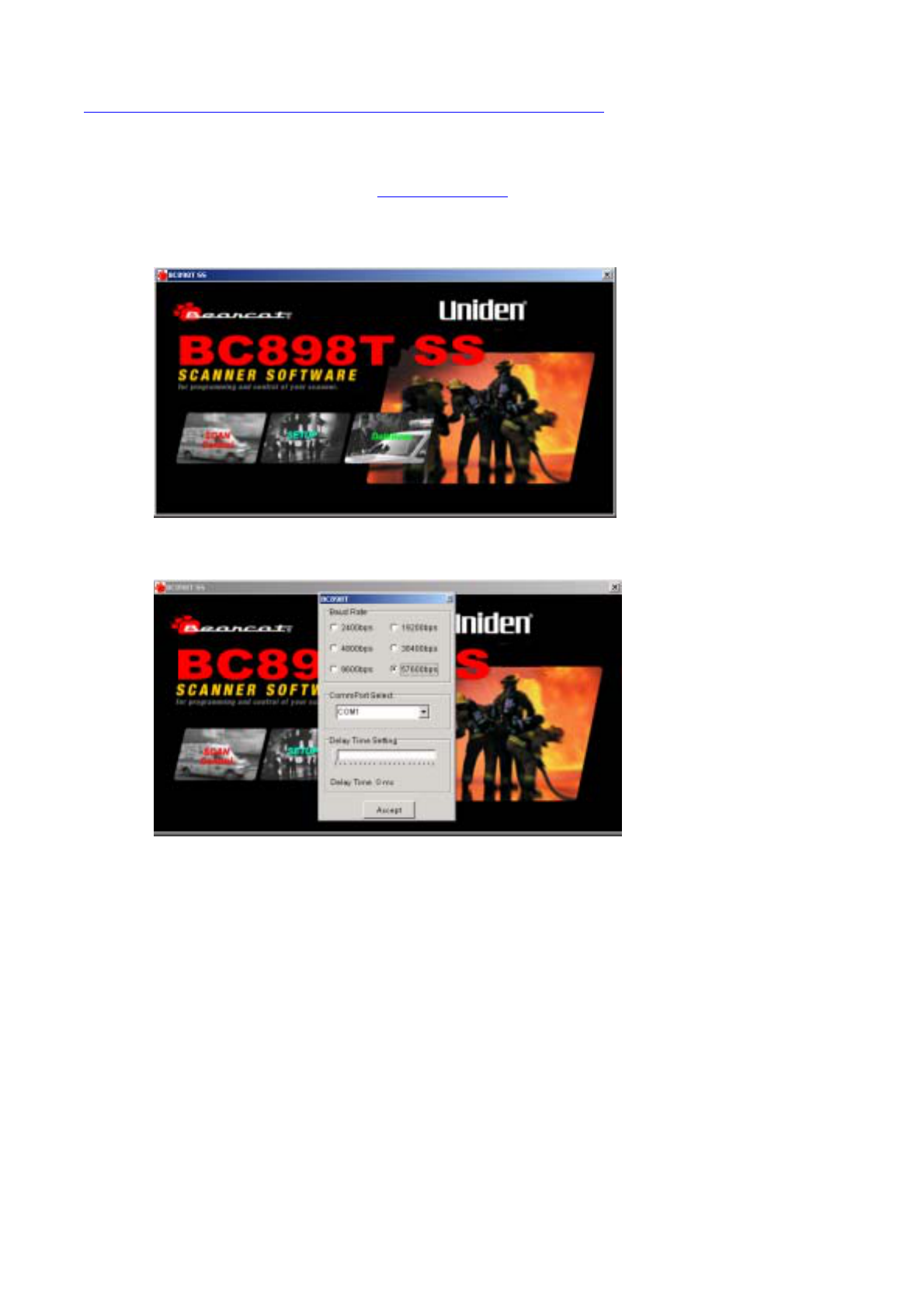
Configuring the Software Using SETUP
Important: Make sure the included interface cable is connected to your
computer and the scanner before
configuring the software. See your Owners Manual for more information.
1. Start the software by double clicking on its icon. The opening screen
appears.
2. Click on SETUP. The setup screen appears.
3. Click on the baud rate under Baud Rate that matches the baud rate
for the serial port you used to connect
the included interface cable. For example, if the serial port is set to
57,600 bps (bits per second), click
on 57600bps.
13/305 ページCONTENTS
2004/04/01file://¥¥Fileserv0¥OM¥UB322Z_BC898¥Software%20Help.htm
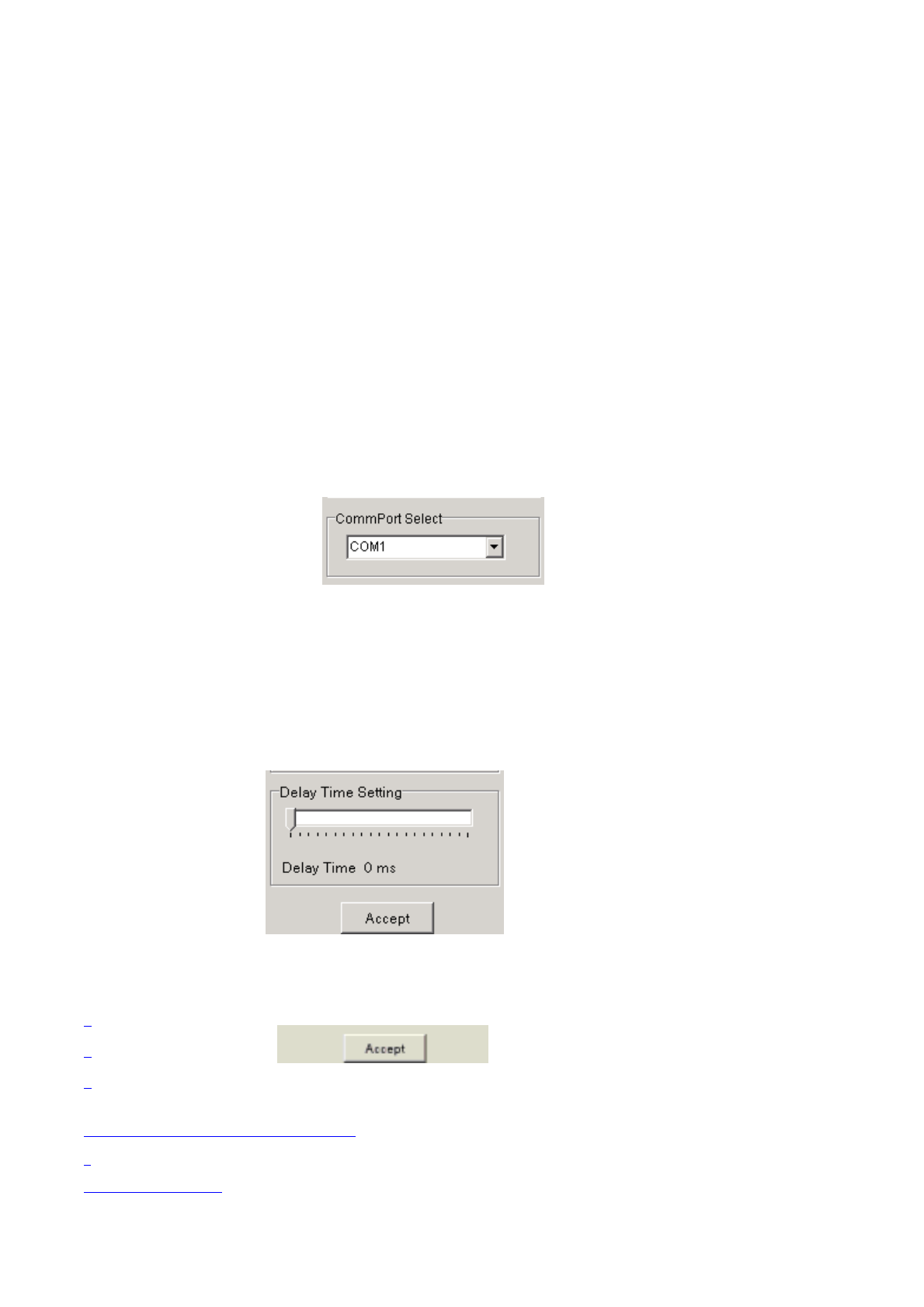
Notes:
• Most COM ports are set to a baud rate of 19,200 or 57,600 bps. If
the software does not work with your
computer, make sure the baud rate you select matches the setting
for the COM port you are using.
If these settings match, set your computer’s COM port to a lower
baud rate and select a matching baud
rate in Step 3.
• You can find the baud rate for your computer’s COM ports using
Windows Device Manager. For more
information about using Device Manager, consult your computer’s
documentation.
4. Select the COM port under CommPort Select where you connected
the included interface cable.
For example, if your computer’s serial port is configured as COM1,
select COM1.
5. Timing errors can cause data to be sent too fast and cause errors in
loading and reading the scanner’s
memory. If you encounter erratic communication problems between
the scanner and your computer,
slide Delay Time Setting if necessary to change the delay time to a
longer one.
6. When you have finished making all changes, click on Accept.
Using SCAN Control
Basic Mode
21/305 ページCONTENTS
2004/04/01file://¥¥Fileserv0¥OM¥UB322Z_BC898¥Software%20Help.htm
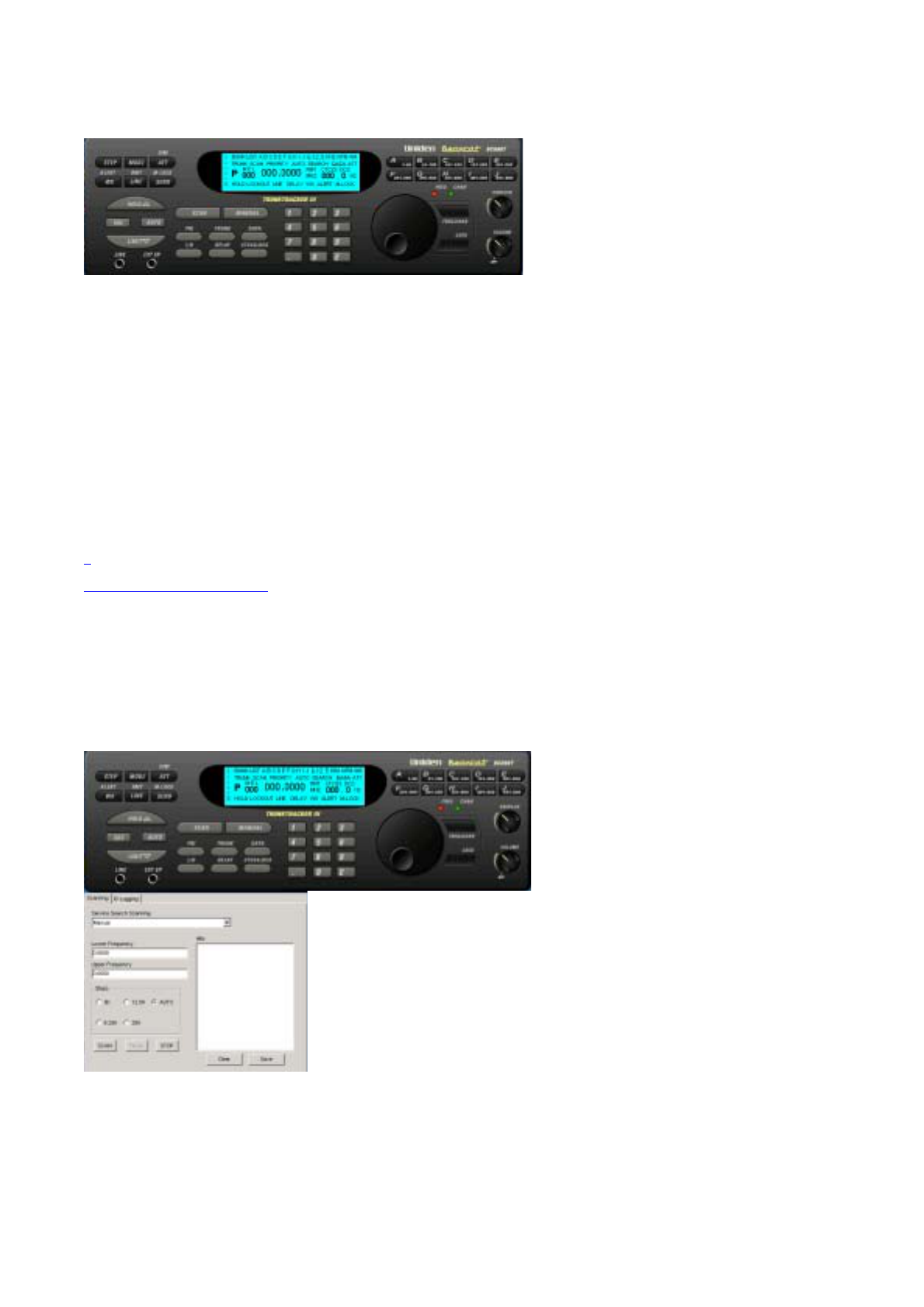
To select Basic mode, click on SCAN Control on the opening screen.
The virtual scanner appears.
In Basic mode, you can use your mouse to click on the virtual scanner’s
keys to operate it,
j
ust like your real scanner. When you click on a key, it presses down on the
screen just like
it would if you pressed it on your scanner. All of the keys on the virtual
scanner do the same
thing as the same keys on your scanner.
Note: You cannot use the mouse to control the virtual scanner’s rotary tuner,
SQUELCH,
or VOLUME controls.
Extended Mode
To select Extended mode, move the mouse pointer anywhere on the virtual
scanner then
click the right mouse button. A selection popup appears. Click on
Extended. A window
with the options available in Extended mode appears below the virtual
scanner.
Extended scanning lets you import new scan lists without having to program
them into the
scanner. You can also log new frequencies and talk group IDs and save
them into a list,
which you can program into the scanner.
22/305 ページCONTENTS
2004/04/01file://¥¥Fileserv0¥OM¥UB322Z_BC898¥Software%20Help.htm
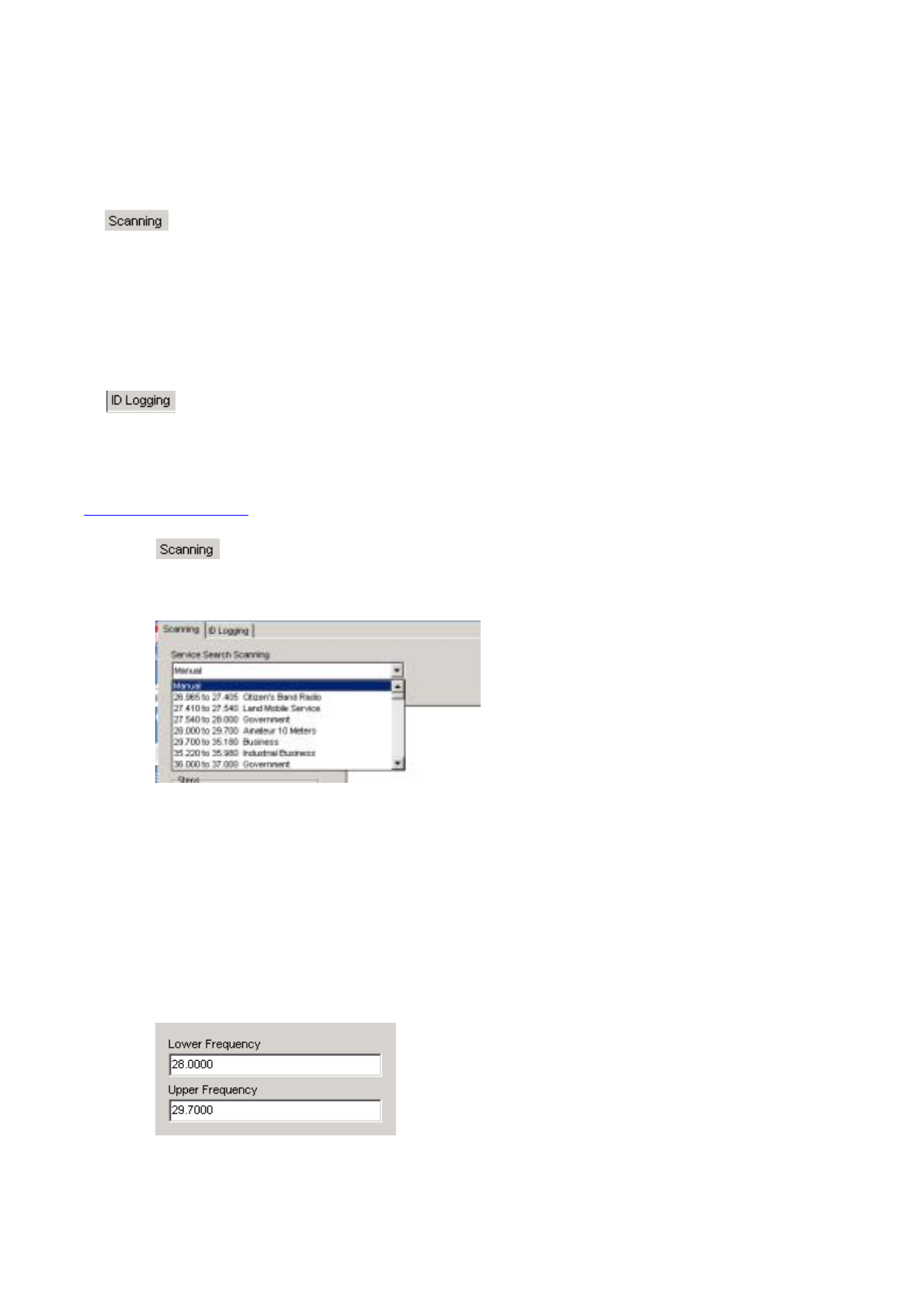
Note: All the controls for Resume and Step are still controlled by the top
section of the
virtual scanner’s display when you select Extended mode.
Extended scanning has the following options.
This option lets you select from a list of the most popular search
ranges for
your scanner and search them. You can also change any of the preset
search ranges,
select and change the search range’s frequency step and other
information, and gather
and work with a list of active frequencies within the search range.
This option lets you log talk group IDs you find on a trunked
radio system and
save them to a file.
Using Scanning
Click on to work with the following options.
zService Search Scanning
Click on the Service Search Scanning pull-down list to select the
range of frequencies
you want to search. A list of ranges appears. Then click on the range
you want to search.
The lower and upper limit frequencies for the range you selected
appear in Lower Frequency
and Upper Frequency respectively.
zLower Frequency/Upper Frequency
While you can select the most common search ranges using the pull-
down list, you can change
23/305 ページCONTENTS
2004/04/01file://¥¥Fileserv0¥OM¥UB322Z_BC898¥Software%20Help.htm
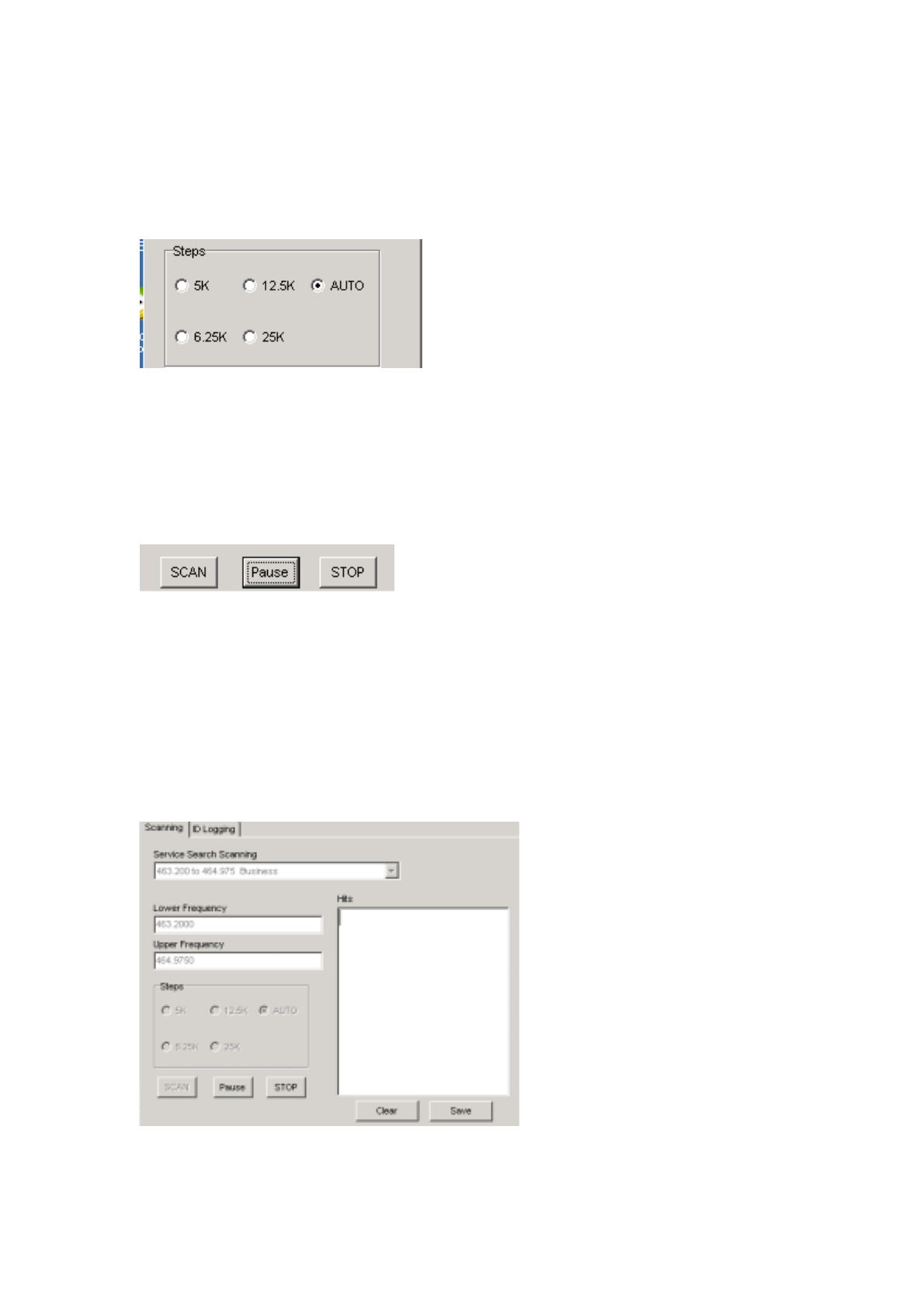
the displayed frequencies by typing any frequency the scanner can
receive into Lower
Frequency and Upper Frequency. The preset frequencies are
replaced by the frequencies
you type.
zSteps
You can change the displayed step size by selecting a step. The step
size changes to the one
you selected. The default step size is set to Auto unless you click on
a different step size.
zSCAN/Pause/STOP
Click on SCAN to start scanning. If you hear an interesting
frequency, click on Pause to hold
the frequency until you are ready to resume scanning. Click on STOP
to stop scanning and
select a new search range using the pull-down list or by entering the
lower and upper
frequency ranges.
zHits
The Hits box displays a list of frequencies (called hits), where the
scanner detected activity
during a search. You can save the hits for later scanning or erase
them and start a new
463.3535
463.8000
464.0500
24/305 ページCONTENTS
2004/04/01file://¥¥Fileserv0¥OM¥UB322Z_BC898¥Software%20Help.htm
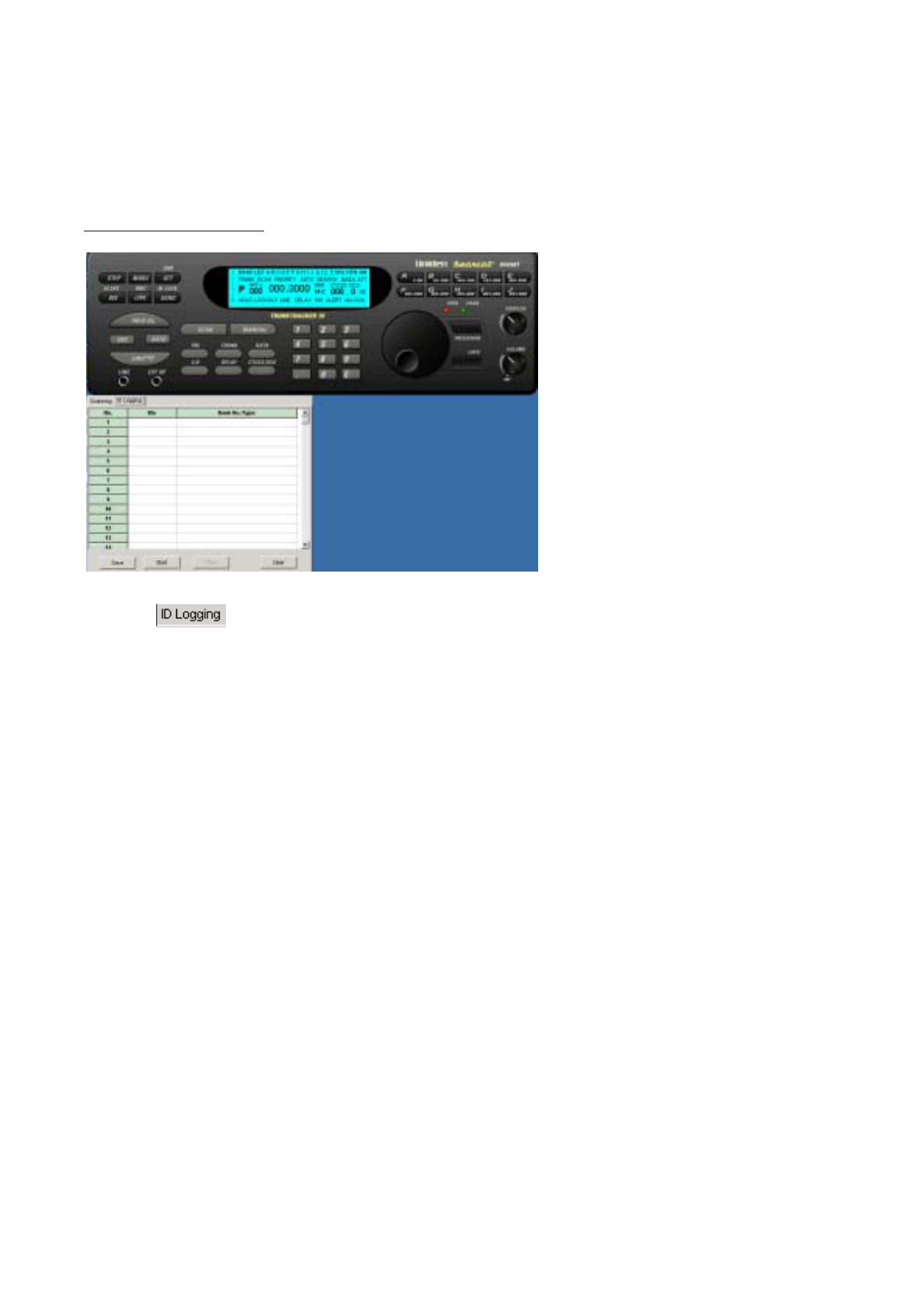
search.
Click on Save to save the hits. The software saves the hits in a file
called FreqLog.txt.
Click on Clear to erase the hits and continue searching.
Using ID Logging
Click on to work with the ID logging option. ID Logging lets you log
talk group IDs you find
on a trunked radio system and save them to a file.
To log talk group IDs, start scanning, select the bank or banks you want to
log, and then click Start.
When the scanner detects activity on a talk group, it logs the talk group’s ID
number, the bank
number, and the trunk type.
Click on Save to save the talk group IDs. The software saves the talk group
IDs in a file called
IdLog.txt. Click on Stop to stop logging talk group IDs. Click on Clear to
erase logged talk group
IDs and continue logging.
25/305 ページCONTENTS
2004/04/01file://¥¥Fileserv0¥OM¥UB322Z_BC898¥Software%20Help.htm
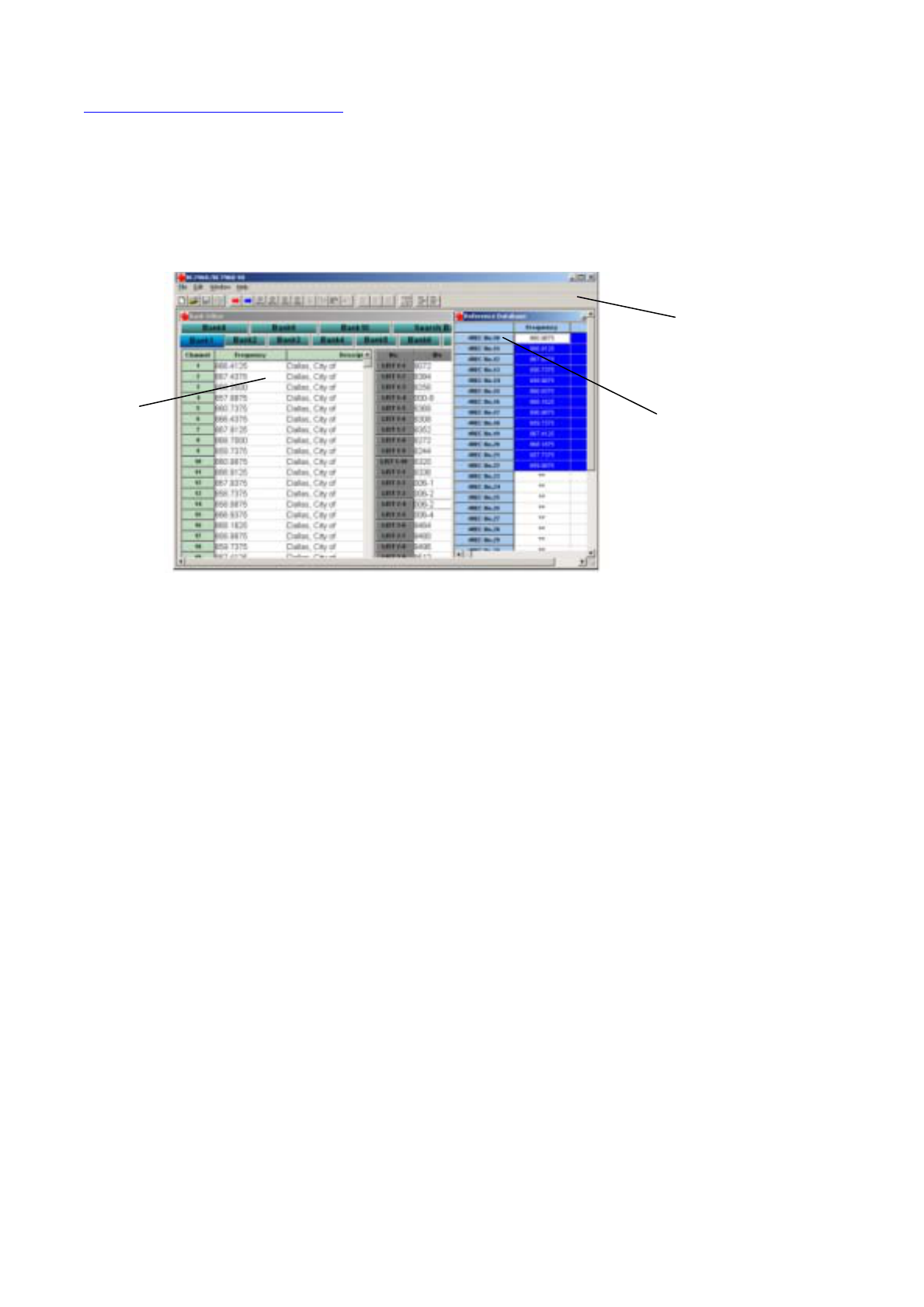
Using the Database
To select the database, click on Database on the opening screen. The
Database screen
appears. The Bank Editor and Reference Database appear in separate
windows within
the Database screen.
Note: Depending on how these windows were last viewed, the screens you
see might not look exactly
like the one shown here.
You can change the layout of the Bank Editor and Reference
Database windows by:
zDragging either window to any position.
zUsing the horizontal slider on the bottom of the screen to adjust the
view for the screen
you are working with.
zMinimizing one window while working with the other.
zClicking on Window on the top of the Database screen, then selecting
Tile or Cascade.
Database
Screen
Reference
Database
Bank
Editor
26/305 ページCONTENTS
2004/04/01file://¥¥Fileserv0¥OM¥UB322Z_BC898¥Software%20Help.htm
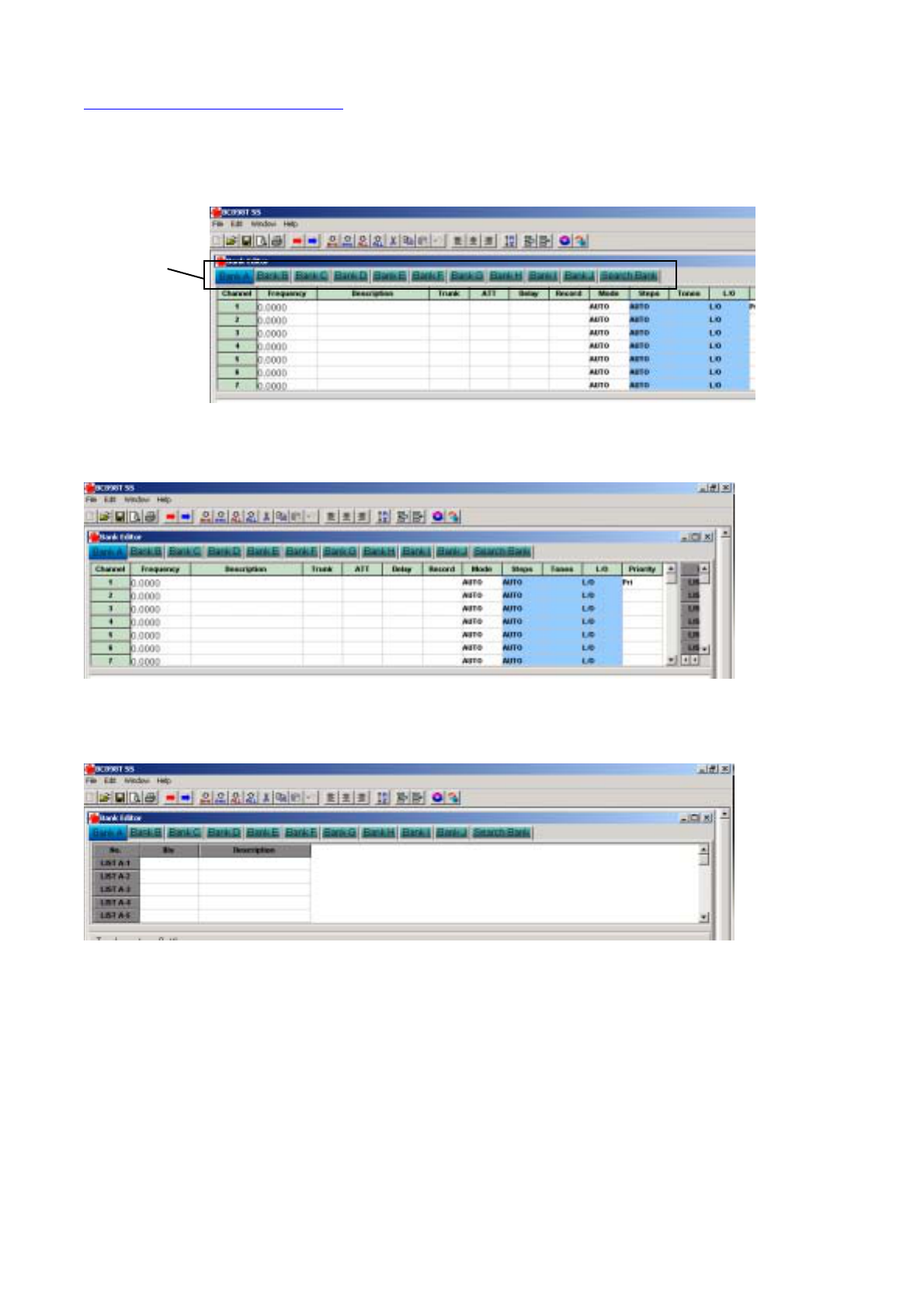
Using the Bank Editor
You can click on each bank button (Bank A, Bank B, and so on) to work with
the information in
that bank.
The Bank Editor contains these windows.
FREQUENCY WINDOW - contains frequencies, description tags, and associated
settings.
TRUNKING WINDOW - contains talk group numbers and descriptions and settings.
(This screen is normally on the right but is shown on the left here for clarity).
Bank
Buttons
27/305 ページCONTENTS
2004/04/01file://¥¥Fileserv0¥OM¥UB322Z_BC898¥Software%20Help.htm
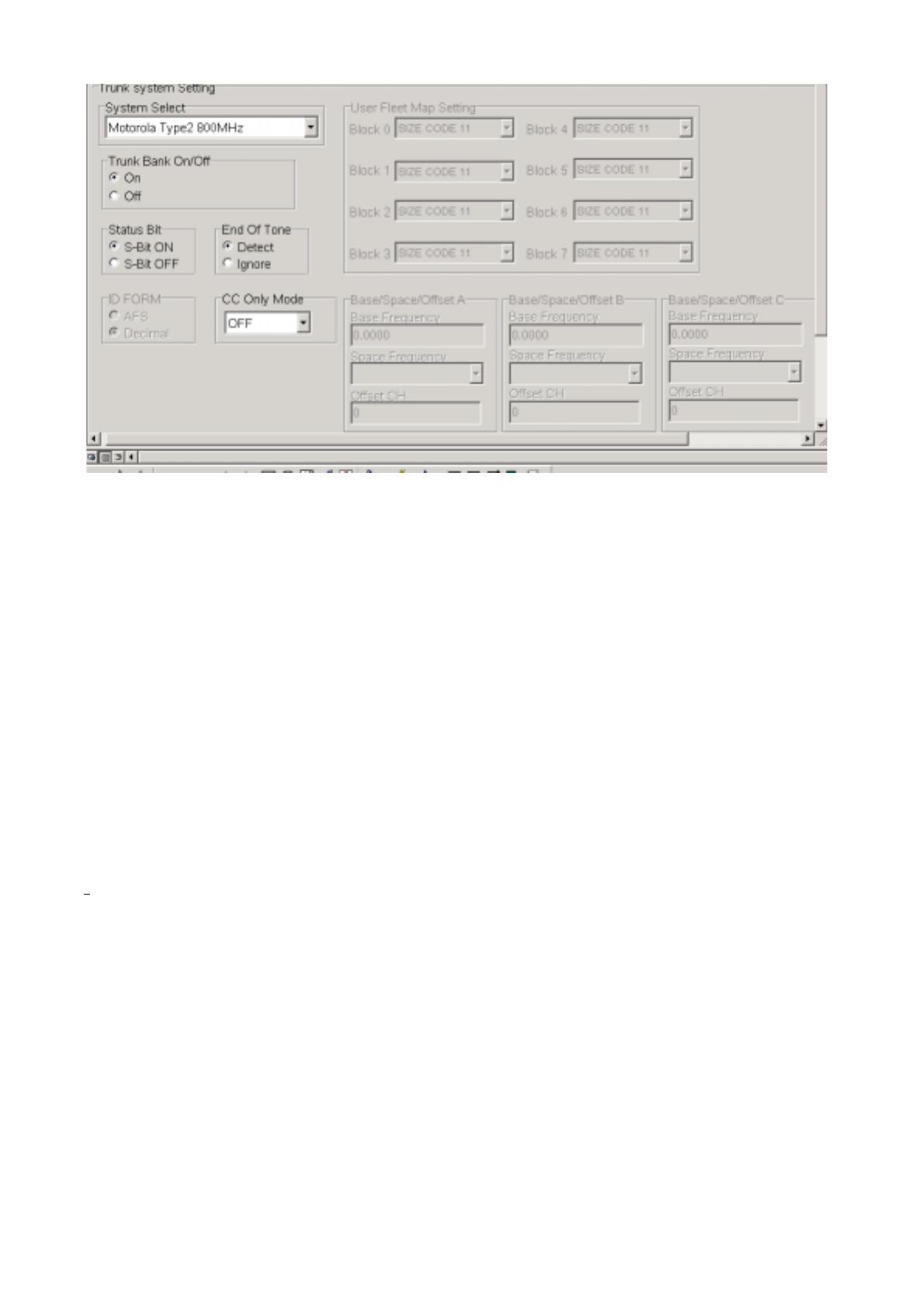
TRUNKING RECORD WINDOW - lets you enter and work with records for trunked
systems.
Each window has scroll bars that help you move through the records.
To select a bank, click on the bank’s button. If the bank you select is a
trunking bank, you can
enter the talk group’s numbers and description tags. If the bank you select
is a standard
(non-trunking) bank, you can type in frequencies and description tags for the
frequencies.
Note: There are several individual settings for each channel. However, if
you do not change the
settings in the database, the scanner defaults to any settings in the
database column or its
built-in settings if the column is blank.
28/305 ページCONTENTS
2004/04/01file://¥¥Fileserv0¥OM¥UB322Z_BC898¥Software%20Help.htm
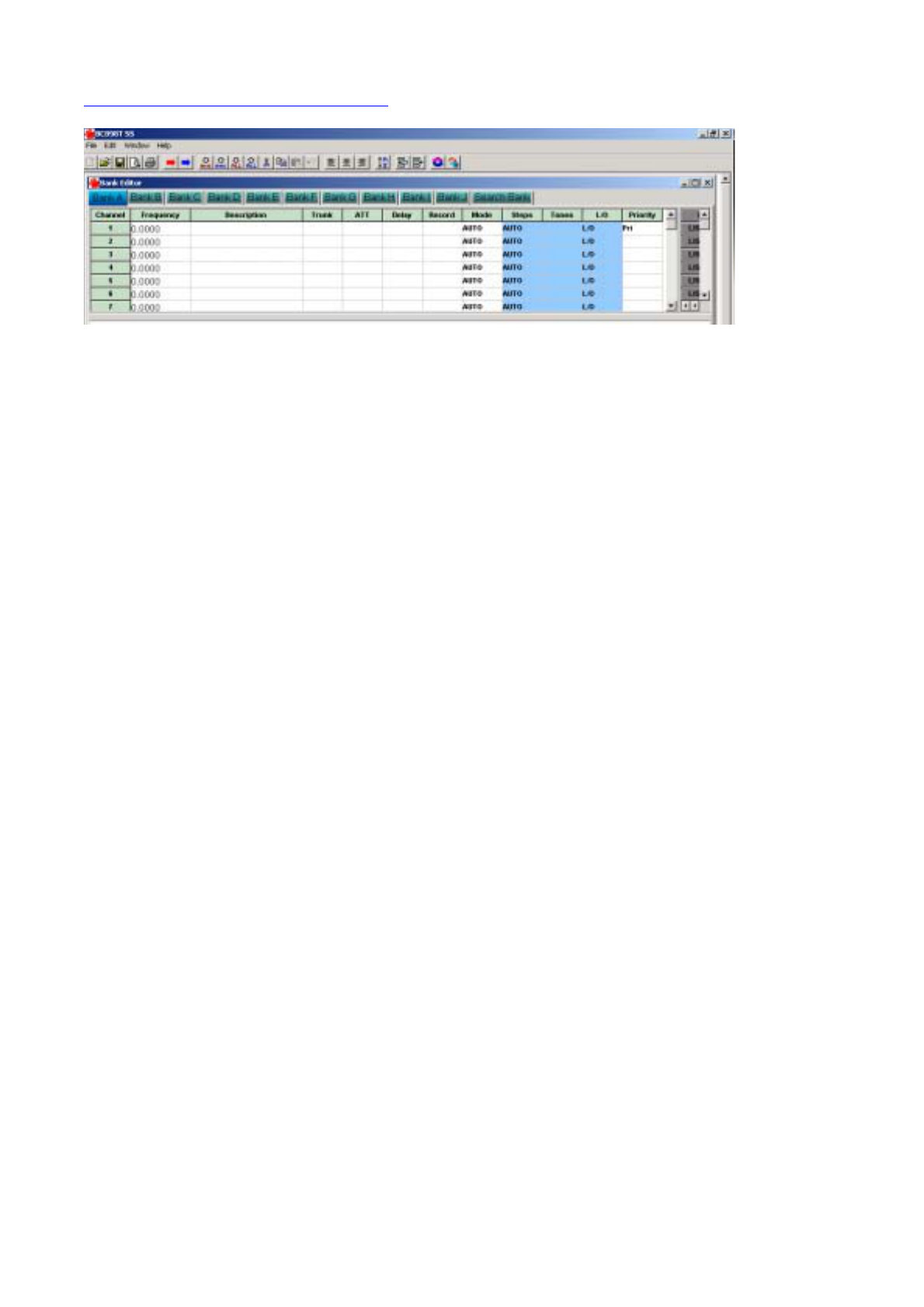
Using the Frequency Window
In the Frequency Window, you can enter information about a specific
channel including the
frequency, a description of the frequency, whether the frequency is a
trunked frequency
or not, and other information.
To enter a frequency, click on the Frequency field to the right of the channel
you want, then type
in a frequency.
To enter a description, click on the Description field for the channel you
want, then type in the
description.
To enter a trunked channel, double click on the Trunk field for the channel
you want. On appears.
To remove the trunk designation, double click on the field again. On
disappears.
To turn on attenuation for a channel, double click on the ATT field for the
channel you want.
On appears. To remove attenuation, double click on the field again. On
disappears.
To turn on delay for a channel, double click on the Delay field for the
channel you want.
On appears. To remove delay, double click on the field again. On
disappears.
To turn on record for a channel, double click on the Record field for the
channel you want.
On appears. To remove record, double click on the field again. On
disappears.
To select the mode for a channel, click on the Mode field for the channel you
want.
A pulldown menu appears with 5K, 6.25K, 12.5K, and 25K. Then select the
option you want.
To select the step for a channel, click on the Steps field for the channel you
want.
A pulldown menu appears with AM, FM, NFM, and AUTO. Then select the
29/305 ページCONTENTS
2004/04/01file://¥¥Fileserv0¥OM¥UB322Z_BC898¥Software%20Help.htm
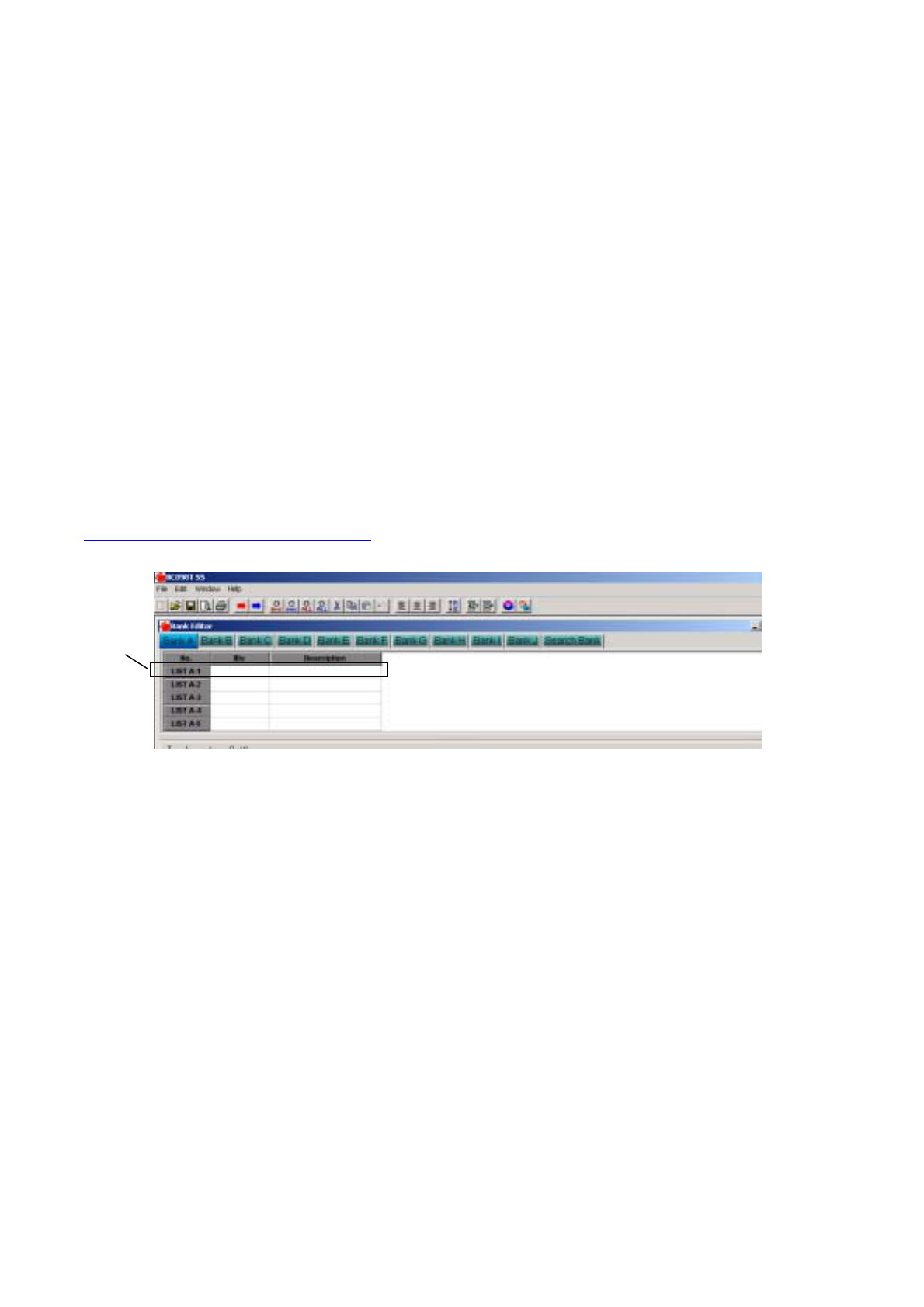
option you want.
To select whether a channel has tone, click on the Tone field for the channel
you want.
A pulldown menu appears with a blank space, CTCSS, and DCS. Then
select CTCSS
(if the channel has CTCSS tone), DCS (if the channel has DCS tone), or the
blank space
(if the channel has no tone).
To turn on lockout for a channel, double click on the L/O field for the channel
you want.
L/O appears. To remove lockout, double click on the field again. L/O
disappears.
To set a channel as the priority channel in the bank, double click on the
Priority field for
the channel you want. Pri appears. To remove priority, double click on the
field again.
Pri disappears.
Using the Trunking Window
In the Trunking Window, you can enter up to 10 individual talk group ID
numbers into each list entry.
By grouping talk group ID numbers in separate lists, you can easily enable
or disable each list so
you hear only certain types of communications while scanning. For
example, put as many as 10
police talk group ID numbers into one list entry, as many as 10 public
service talk group ID
numbers into another list entry, as many as 10 tactical talk group ID
numbers into another list
entry, and so on.
To enter a talk group ID number, click on the IDs field to the right of the talk
group ID you want,
then type in each talk group ID number you want in the list entry. You can
enter up to 10 talk
group ID numbers in each list entry. Otherwise, if the trunking system is an
EDACS or Motorola
Type I or Type 2 system, enter a dash (-).
To enter a description of the talk group ID numbers in the list entry, click on
List
Entr
y
30/305 ページCONTENTS
2004/04/01file://¥¥Fileserv0¥OM¥UB322Z_BC898¥Software%20Help.htm

the Description field
for the list entry you want, then type in the description. The description you
enter appears instead
of the description of the active frequency when you scan in ID Scan mode.
31/305 ページCONTENTS
2004/04/01file://¥¥Fileserv0¥OM¥UB322Z_BC898¥Software%20Help.htm
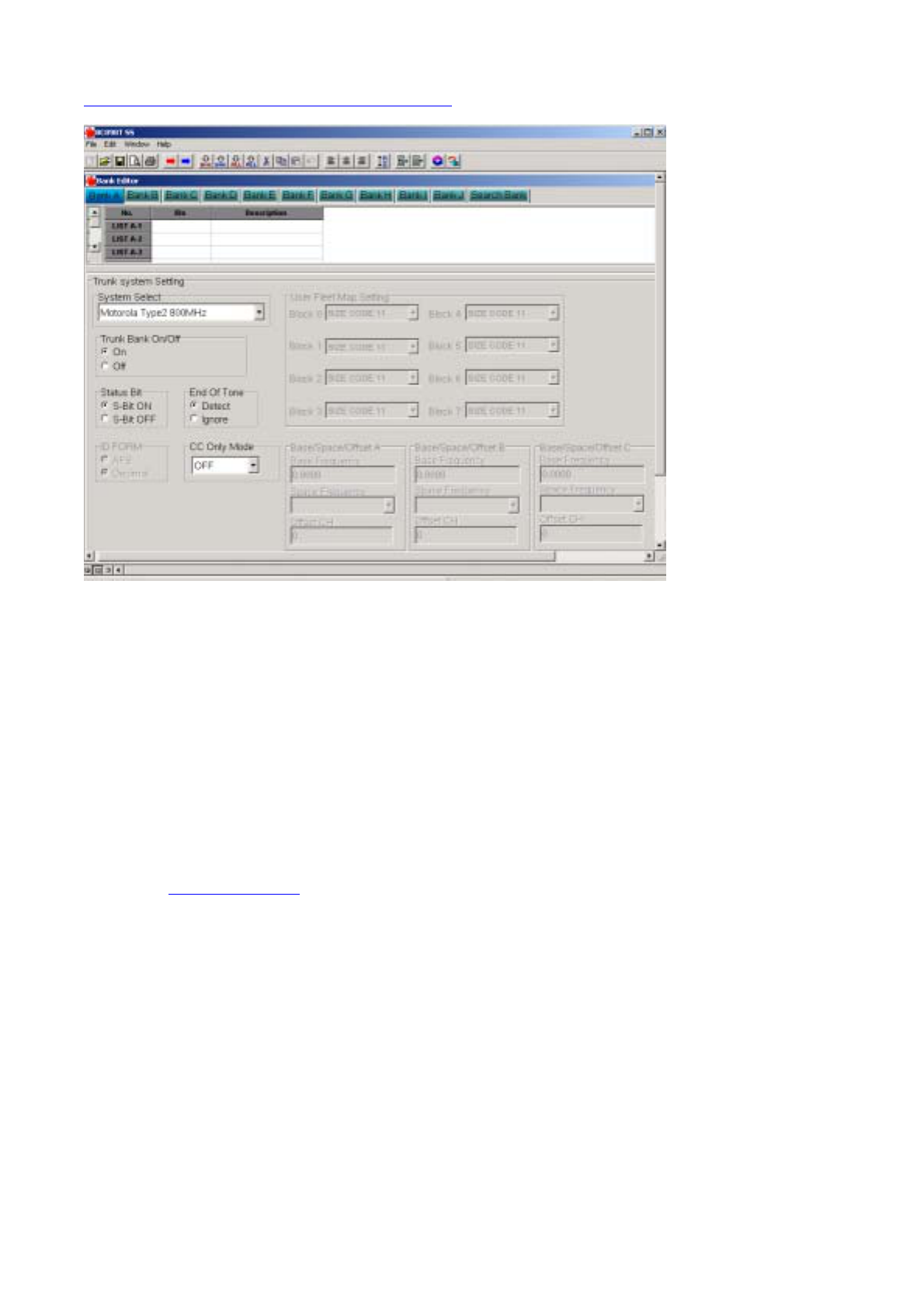
Using the Trunking Record Window
In the Trunking Record Window, you can enter information about a specific
channel including the
type of trunked system, whether the trunk bank is on or off, whether the
status bit is on or off,
and other information.
Note: Depending on the type of trunking system you select, some of the
options described
below might not apply to that system. For example, if you select Motorola
Type 1 (or Hybrid)
in the System Select field, you can enter information in the User Fleet Map
Setting fields but
cannot enter information in the Base/Space/Offset fields. Consult your
scanner’s Owners Manual
for more information about how to determine optimum settings for each type
of trunking system.
To select the type of trunking system, click on System Select. A pulldown
menu appears with
system type options. Then click on the system type to select it.
Notes:
zWhen you select a trunking system type, the software automatically
fills in some options for you.
Always select the type of trunking system first before selecting any
other options in this window.
Otherwise, the software might unexpectedly change selections you
have already made.
32/305 ページCONTENTS
2004/04/01file://¥¥Fileserv0¥OM¥UB322Z_BC898¥Software%20Help.htm

zYou can select only one type of trunking system per bank. Select the
type of trunking system
applicable to the frequencies in that bank.
To select whether the scanner will scan frequencies entered in the bank as
trunked frequencies, click
on Trunk Bank On. Otherwise, click on Trunk Bank Off.
Note: If you click on Trunk Bank Off, the scanner scans all frequencies
entered in the bank as
conventional frequencies.
To turn on the status bit, click on S-Bit ON. Otherwise, click on S-Bit OFF.
To turn on end of tone detection, click on End of Tone Detect. Otherwise,
click on End of Tone Ignore.
To set the ID FORM to AFS, click on AFS. Otherwise, click on Decimal.
If you selected Motorola Type 1 (or Hybrid) in the System Select field, you
can change the displayed
size code for each user fleet map if necessary. Click on the size code for
each block you want to change
under User Fleet Map Setting. A pulldown menu appears with size code
options. Then click on the size
code to select it.
If you selected Motorola Type2 UHF or Motorola Type2 in the System Select
field, you can change the
displayed base frequency, space frequency, and offset channel if
necessary.
To change the displayed base frequency, click on the frequency you want to
change under Base
Frequency, then enter the frequency you want to use.
To change the displayed space frequency, click on Space Frequency. A
pulldown menu appears
with space frequency options. Then click on the space frequency you want
to use to select it.
To change the displayed offset channel, click on the offset channel you want
to change under Offset CH,
then enter the offset channel you want to use.
33/305 ページCONTENTS
2004/04/01file://¥¥Fileserv0¥OM¥UB322Z_BC898¥Software%20Help.htm
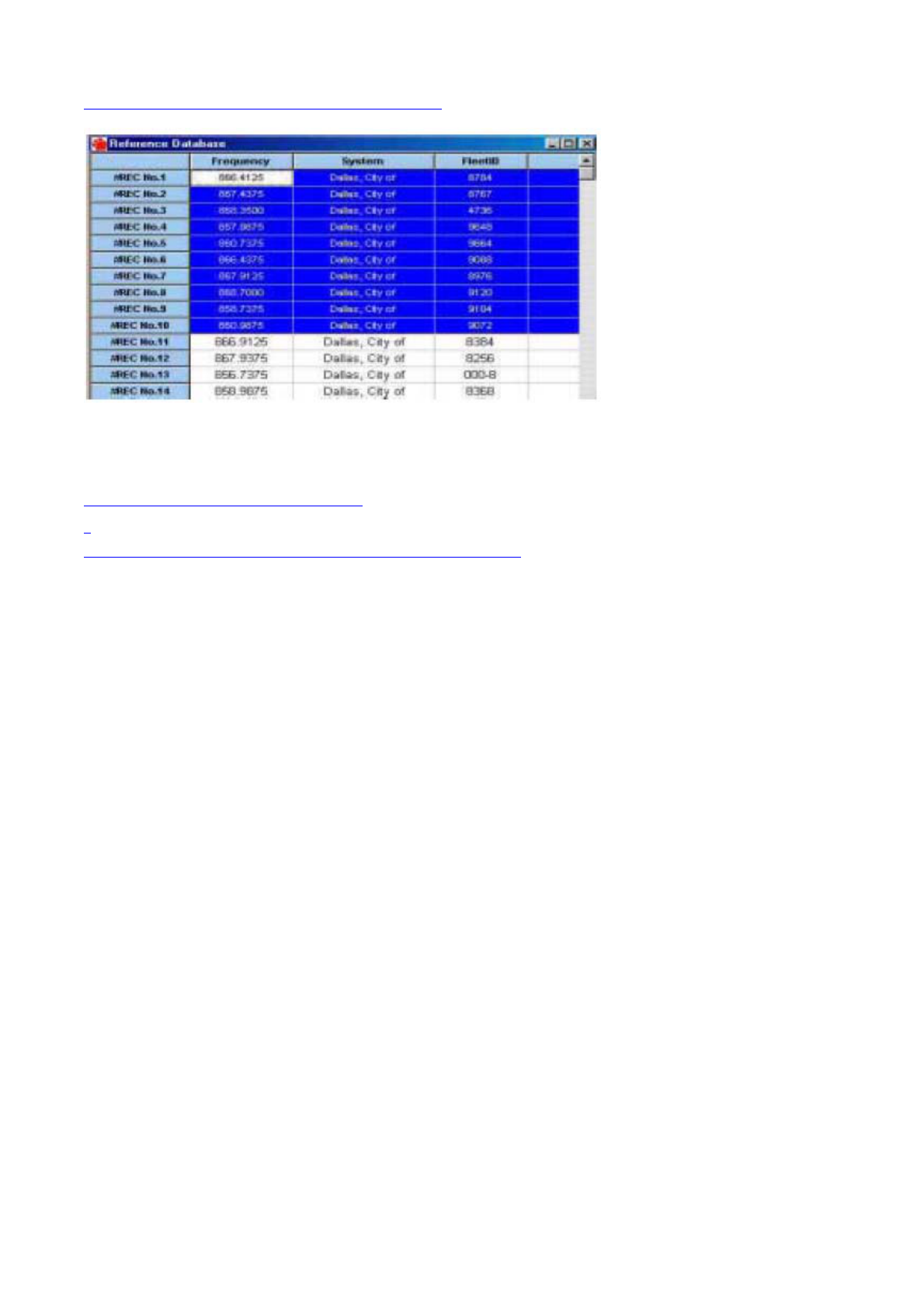
Using the Reference Database
The Reference Database is normally blank unless you have previously used
it to work with data.
Note: You can download database files in .txt format at
http://www.bearcat1.com/free.htm
Opening and Working With Database Files
Follow these steps to work with a database.
1. Make sure the Reference Database is blank and delete any
old data if it is not. To delete old data and load new data,
click on File on the top of the Database screen, then select
New.
2. Otherwise, to open an existing database, click on File then select
Open.
3. Select the database file you want to work with. You can select any of
the following file types:
zText (.txt)
zCSV (.csv)
zDBF (.dbf)
Note: You cannot use the Reference Database to work with Bank
Data (.ssd) files.
They work only with the Bank Editor.
34/305 ページCONTENTS
2004/04/01file://¥¥Fileserv0¥OM¥UB322Z_BC898¥Software%20Help.htm

4. Database files you select must be in the following format.
• "Frequency"
• "System"
• "FleetID"
• "User"
• "City"
• "State"
• "Sys Type"
• "Notes"
• "Additional Notes”
For example:
"856.7125","Alabama, State
of","**","**","Birmingham","AL","GE","**","**"
If the database file you are trying to open is not in this order, No File
Loaded appears.
If this happens, you can use a text editor to correct the database and
try again.
When you open a database file, it will contain several columns of
frequencies, talk groups, and
descriptions for both.
Copying Records From the Reference Database to the
Bank Editor
1. Use your mouse to highlight the first row of the records you want to
select in the Reference
Database. The framed cell is the first one that will be filled. For
example, to start at the 10th
record to copy, click the cell in the 10th row and that is where the copy
will start.
2. Hold down the left mouse button and drag down the cursor to select
multiple records.
3. Open the Bank Editor then select the position in the Bank Editor where
you want the
imported data to go.
4. Click on Edit on the top of the Database screen, and then select Copy
Frequency List
(to copy the selected frequency information) or Copy Trunking Ids
(to copy the
selected talk group ID information).
35/305 ページCONTENTS
2004/04/01file://¥¥Fileserv0¥OM¥UB322Z_BC898¥Software%20Help.htm

Owners Manual
TRUNKTRACKER
BC 898T
Operating Guide
Trunk Tracker 500 Channel Base Scanner
The FCC Wants You to Know
This scanner has been tested and found to comply with the limits for a scanning receiver,
pursuant to Part 15 of the FCC Rules. These limits are designed to provide reasonable
protection
against harmful interference in a residential installation. This scanner generates, uses, and
can
radiate radio frequency energy and, if not installed and used in accordance with the
instructions,
may cause harmful interference to radio communications.
However, there is no guarantee that interference will not
occur in a particular installation.
If this scanner does cause harmful interference to radio
or television reception, which can be
determined by turning the scanner on and off, you are
encouraged to try to correct the interference by one or
more of the following measures:
zReorient or relocate the receiving antenna
zIncrease the separation between the scanner and the receiver
This device complies with Part 15 of the FCC Rules. Operation is
subject to the following two conditions: 1) This device may not
cause harmful interference, and 2: this device must accept any
interference received, including interference that may cause
undesired operation.
Scanning Legally
Your scanner covers frequencies used by many different groups,
including police and fire departments, ambulance services,
government agencies, private companies, amateur radio services,
military operations, pager services, and wireline (telephone and
telegraph) service providers. It is legal to listen to almost every
transmission your scanner can receive. However, there are some
transmissions that you should never intentionally listen to. These
include:
zTelephone conversations (cellular, cordless, or other private
means of telephone signal transmission)
zPager transmissions
37/305 ページCONTENTS
2004/04/01file://¥¥Fileserv0¥OM¥UB322Z_BC898¥Software%20Help.htm

zAny scrambled or encrypted transmissions
According to the Electronic Communications Privacy Act (ECPA),
you are subject to fines and possible imprisonment for intentionally
listening to, using, or divulging the contents of such a conversation
unless you have the consent of a party to the conversation (unless
such activity is otherwise illegal). This scanner has been designed
to prevent the reception of cellular telephone transmissions and the
decoding of scrambled transmissions. This is done to comply with
the legal requirement that scanners be manufactured so they are
not easy to modify to pick up these transmissions. Do not open your
scanner’s case to make any modifications that could allow it to pick
up transmissions that are illegal to monitor. Modifying or tampering
with your scanner’s internal components or using it in a way other
than as described in this manual could invalidate your warranty and
void your FCC authorization to operate it.
In some areas, mobile use of this scanner is unlawful or requires a
permit. Check the laws in your area. It is also illegal in many areas
(and a bad idea everywhere) to interfere with the duties of public
safety officials by traveling to the scene of an incident without
authorization.
Uniden® and Bearcat® are registered trademarks of Uniden
America Corporation.
TrunkTracker is a proprietary trademark of Uniden America
Corporation.
Other trademarks used throughout this manual are the property of
their respective holders.
Important Notice
This scanning radio has been manufactured so that it will not tune
to the radio frequencies assigned by the FCC for cellular telephone
usage. The Electronic Communications Privacy Act of 1986, as
amended, makes it a federal crime to intentionally intercept cellular
or cordless telephone transmissions or to market this radio when
altered to receive them. The installation, possession, or use of this
scanning radio in a motor vehicle may be prohibited, regulated, or
require a permit in certain states, cities, and/or local jurisdictions.
Your local law enforcement officials should be able to provide you
with information regarding the laws in your community.
Changes or modifications to this product not expressly approved by
Uniden, or operation of this product in any way other than as
detailed by this Operating Guide, could void your authority to
operate this product.
38/305 ページCONTENTS
2004/04/01file://¥¥Fileserv0¥OM¥UB322Z_BC898¥Software%20Help.htm

Precautions
Before you use this scanner, please read and observe the
following:
IMPORTANT!
The installation, possession, or use of this scanning radio in a
motor vehicle might be prohibited, regulated, or require a permit in
certain states, cities, and/or local jurisdiction. Check with your local
law enforcement officials for information regarding the laws in your
community.
EARPHONE WARNING!
Be sure to use only the included monaural earphone. You can also
use an optional 32W stereo headset. Use of an incorrect earphone
or stereo headset might be potentially hazardous to your hearing.
The output of the phone jack is monaural, but you will hear it in both
headphones of a stereo headset.
Set the volume to a comfortable audio level coming from the
speaker before plugging in the monaural earphone or a stereo
headset of the proper impedance (32W). Otherwise, you might
experience some discomfort or possible hearing damage if the
volume suddenly becomes too loud because of the volume control
or squelch control setting. This might be particularly true of the type
of earphone that is placed in the ear canal.
WARNING!
Uniden does not represent this unit to be waterproof. To reduce the
risk of fire or electrical shock, do not expose this unit to rain or
moisture.
Uniden® and Bearcat® are registered trademarks of Uniden
America Corporation.
Introduction
Your new BC898T scanner is a brand new state-of-the-art scanner
radio with TrunkTracking™ and automatic scanning capabilities.
You can store frequencies such as police, fire/emergency, marine,
air, amateur, and other communications into 10 banks of 50
channels each. Use it at home as a base unit, or install it in your
vehicle as a mobile unit.
You can use the scanner’s rotary tuner to quickly select channels
and frequencies, and you can automatically program channels in an
available bank using the AutoStore feature. Your scanner also has
AutoSort, an automatic frequency-sorting feature that provides
faster scanning within each bank.
Use your scanner to monitor:
39/305 ページCONTENTS
2004/04/01file://¥¥Fileserv0¥OM¥UB322Z_BC898¥Software%20Help.htm

z800 MHz trunked public safety systems
zPolice and fire departments (including rescue and
paramedics)
zNOAA weather transmissions
zBusiness/Industrial Radio
zUtilities
zMarine and amateur (ham radio) bands
zAir band
This table lists the frequency ranges, default frequency step, default
mode (AM, FM, or Narrowband FM), and type of transmissions you
can hear for each range.
Feature Highlights
Trunk Tracking – Follow 800 MHz trunked public safety and public
service systems just as if conventional two-way communications
Frequency
Range Steps Mode Transmission
25.0-27.995
MHz 5 kHz AM Citizens Band/Business
Band
28.0-29.995
MHz 5 kHz FM 10 Meter Amateur Band
30.0-49.995
MHz 5 kHz FM VHF Low Band
50.0-54 MHz 5 kHz FM 6 Meter Amateur Band
108-136.9875
MHz 12.5
kHz AM Aircraft Band
137.0-143.995
MHz 5 kHz FM Military Band
144-147.995
MHz 5 kHz FM 2 Meter Amateur Band
148-174 MHz 5 kHz FM VHF High Band
216-224.9875
MHz 12.5
kHz FM VHF High Band
225-399.9875
MHz 12.5
kHz AM 10 Meter Amateur Band
400-419.9875
MHz 12.5
kHz NFM Federal Land Mobile
420-449.9875
MHz 12.5
kHz NFM 70cm Amateur Band
450-469.9875
MHz 12.5
kHz NFM UHF Standard Band
470-512 MHz 12.5
kHz NFM UHF “T” Band
806-823.9875
MHz 12.5
kHz NFM Public Service “800”
Band
850-868.9875
MHz 12.5
kHz NFM Public Service “800”
Band
895-956 MHz 12.5
kHz NFM Public Service “800”
Band
40/305 ページCONTENTS
2004/04/01file://¥¥Fileserv0¥OM¥UB322Z_BC898¥Software%20Help.htm
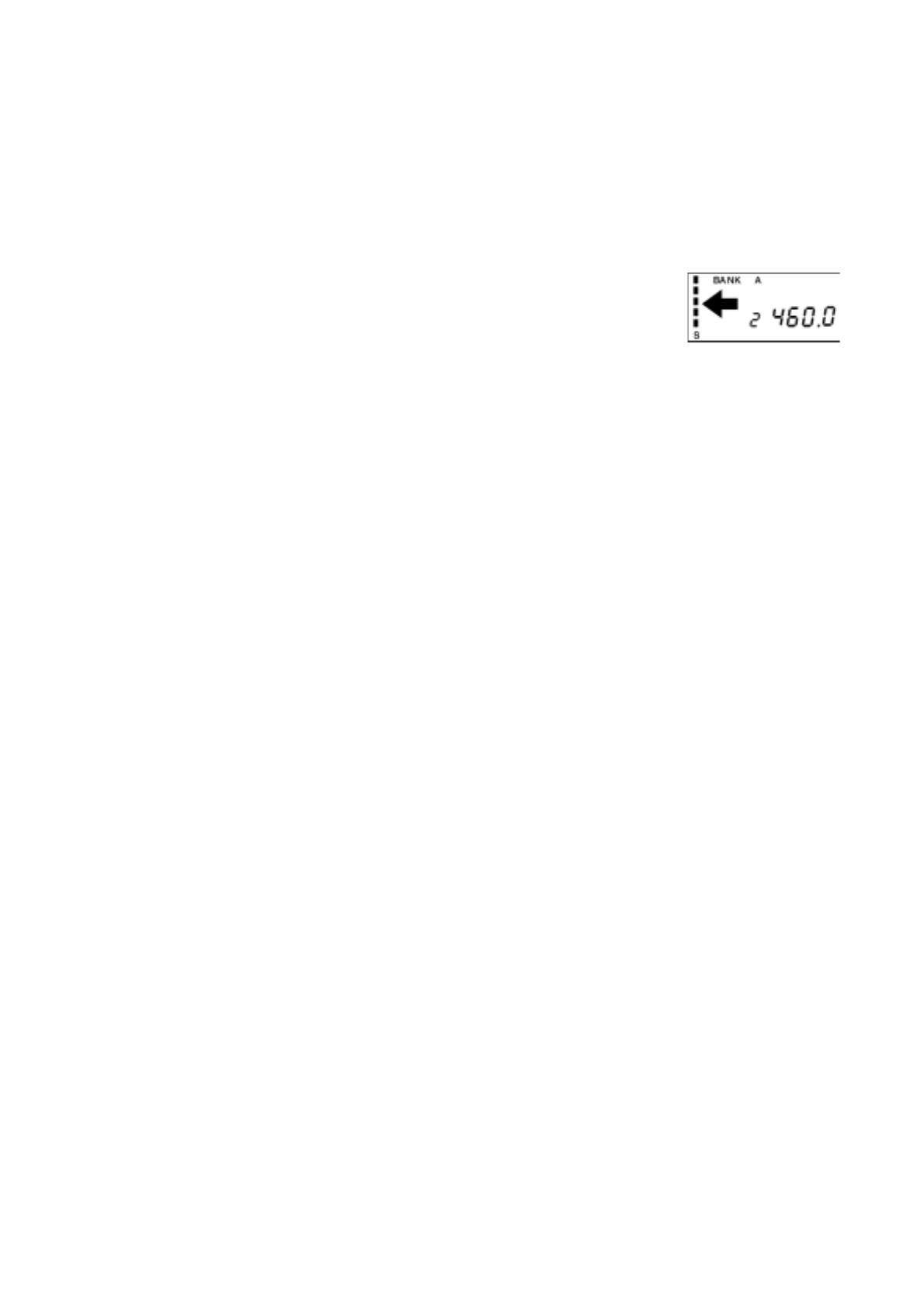
were used.
500 Channels – Program one frequency into each channel. You
must have at least one channel programmed to use the scan mode.
10 Banks – Each bank contains 50 channels, large enough for even
the largest trunked systems or useful for storing similar frequencies
to maintain faster scanning cycles.
Signal Strength Meter – Your scanner’s signal strength meter
displays
the relative strength of an active transmission, using up to five
separate
indicators.
CTCSS and DCS Squelch Modes – prevent interference from
stations not using the mode you select. The scanner’s search mode
shows you if the station you are scanning is using CTCSS or DCS
tones.
CTCSS (Continuous Tone Coded Squelch System) – When
CTCSS is activated, your scanner tunes to a frequency only if the
associated CTCSS tone you programmed is included with the
transmission. You can also use this feature to search for a CTCSS
tone when monitoring a transmission.
Subaudible Tone Search – Lets the scanner search for and identify
agencies transmitting CTCSS or DCS tones. You can identify up to
50 CTCSS tones. This helps you find stations using these tones.
17 Bands – Includes 17 bands, with Aircraft and 800 MHz.
25 MHz-956 MHz – Your scanner covers an extensive frequency
range so you can monitor most of the transmissions in your area.
Note: The scanner’s frequency coverage is not continuous and
does not include the cellular telephone band.
10 Priority Channels – You can assign one priority channel in each
bank. Assigning a priority channel lets you keep track of activity on
your most important channel(s) while monitoring other channels for
transmissions.
VFO (Variable Frequency Oscillator) Control – Turn the large rotary
tuner to select a desired frequency or channel.
AutoStore – Automatically stores all active frequencies within the
specified bank(s).
Weather Alert – Lets your scanner alert you when a SAME weather
alert is transmitted on a NOAA weather channel. The scanner also
displays the transmitted SAME code. This helps you quickly find
out about severe weather in your area and lets you avoid false
alarms.
41/305 ページCONTENTS
2004/04/01file://¥¥Fileserv0¥OM¥UB322Z_BC898¥Software%20Help.htm

Weather Search– Lets your scanner receive your local NOAA
weather transmission.
Chain Search – Lets your scanner search up to 10 ranges by
selecting specific banks into which you have programmed search
ranges.
Frequency Step – Lets you select a frequency step (5, 6.25, 12.5,
or 25 kHz) for manual mode and chain search mode.
Auto Sort– Programmed frequencies are automatically sorted within
each bank for faster scanning.
Unique Data Skip – Allows your scanner to skip unwanted data
transmissions and reduces birdies.
Memory Backup – If power is lost or disconnected, the scanner
retains the frequencies you programmed in its memory.
LCD Back Light – Makes the display easy to see in dim light. You
can adjust the back light and even turn it off.
Auto Recording — Automatically record transmissions onto an
optional tape recorder (not included).
Scan/Search Delay – You can set the scanner so it remains on a
frequency two seconds after the last transmission to wait for a
possible reply.
About This Manual
The screen displays used in this manual are representations of
what might appear when you use your scanner. Since what you see
depends on the frequencies and user IDs for your area and the
settings you select, you might notice some differences between
what is in this manual and what appears on your scanner.
To get the most from this manual, review the contents to become
familiar with the basic functions available. If you are new to
scanning or trunk tracking, be sure to read Understanding Scanning
for a quick background on the technology behind the hobby. The
first thing you’ll need to do is plug the AC adapter into the scanner.
Then you need to connect the included antenna to the scanner.
See Installing Your Scanner if you need any help doing this. Then,
to get a taste of what your scanner can do while you are reading
the Owners Manual, press MANUAL then press SRC. The scanner
stops on every active trunking talk group, regardless of whether you
have programmed them into the scanner.
Understanding Scanning
This section provides you with the background on how scanning
42/305 ページCONTENTS
2004/04/01file://¥¥Fileserv0¥OM¥UB322Z_BC898¥Software%20Help.htm

works. You don’t really need to know all of this to use your scanner,
but some background knowledge will help you get the most from
your BC898T.
Understanding Banks and Channels
The memory in your scanner is organized into 10 banks of 50
channels each. Each bank can contain conventional channels as
well as 1 trunking system. For each trunking system, each bank can
also store 10 groups of 10 talk group ID’s (100 per bank).
What is Scanning?
Unlike standard AM or FM radio stations, most two-way
communications do not transmit continuously. Your BC898T scans
programmed channels until it finds an active frequency, then stops
on that frequency and remains on that channel as long as the
transmission continues. When the transmission ends, the scanning
cycle resumes until the scanner receives another transmission.
What is Searching?
The BC898T can search each of its 17 bands and up to ten bands
together to find active frequencies. This is different from scanning
because you are searching for frequencies that have not been
programmed into the scanner. When you select frequency bands to
search, the scanner searches for any active frequency within the
lower and upper limits you specify. When the scanner finds an
active frequency, it stops on that frequency as long as the
transmission lasts. If you think the frequency is interesting, you can
program it into one of the banks. If not, you can continue to search.
What is CTCSS/DCS?
Your scanner can monitor systems using a Continuous Tone
Control Squelch (CTCSS) and Digital Coded Squelch (DCS)
system, which allow squelch to open only when the tone you have
programmed with a specific frequency is received along with a
transmission.
CTCSS and DCS are subaudible tone signaling systems
sometimes referred to as PL (Motorola’s trademarked term for
Private Line). CTCSS and DCS are used only for FM signals and
are usually associated with both amateur and commercial two-way
repeaters. These systems make use of a special subaudible tone
that accompanies a transmitted signal. The Electronics Industry
Association (EIA) established a set of 38 standard CTCSS tones.
CTCSS and DCS are used for many purposes. In many cases,
CTCSS and DCS are used to restrict access to a commercial
repeater, so that only those units, which transmit the correct tone
along with their signal can “talk to the repeater.” You might also
need to have your scanner coded correctly to “hear” the repeater.
43/305 ページCONTENTS
2004/04/01file://¥¥Fileserv0¥OM¥UB322Z_BC898¥Software%20Help.htm

CTCSS and DCS are also used in areas that receive interference
where there are several stations with output frequencies close to
each other. When this occurs, you might hear multiple
communications at the same time. The stations might even interfere
with each other to the point where it is impossible to clearly receive
any of the stations. A scanner equipped with CTCSS and DCS (like
your scanner) can code each received frequency with a specific
CTCSS or DCS frequency. Then, when you receive multiple
signals, you only hear the transmission with the CTCSS or DCS
tone you programmed. If you do not receive the correct tone with a
signal, the scanner’s squelch remains closed and you hear nothing.
Local frequency allocation groups set cooperative standards to
establish the CTCSS and DCS tone for each transmitter (or
repeater).
You can search for the following CTCSS frequencies and DCS
codes.
CTCSS Frequencies (Hz)
DCS Codes (Octal)
Conventional Scanning
Conventional scanning is a relatively simple concept. Each group of
users in a conventional system is assigned a single frequency (for
simplex systems) or two frequencies (for repeater systems) to use.
Any time one of them transmits, their transmission always goes out
on the same frequency. Up until the late 1980’s this was the
primary way that radio systems operated. Even today, there are
many 2-way radio users who operate using a conventional system:
67.0 69.3 71.9 74.4 77.0 79.7 82.5 85.4 88.5 91.5
94.8 97.4 100.0 103.5 107.2 110.9 114.8 118.8 123.0 127.3
131.8 136.5 141.3 146.2 151.4 156.7 159.8 162.2 165.5 167.9
171.3 173.8 177.3 179.9 183.5 186.2 189.9 192.8 196.6 199.5
203.5 206.5 210.7 218.1 225.7 229.1 233.6 241.8 250.3 254.1
023 025 026 031 032 036 043 047 051 053
054 065 071 072 073 074 114 115 116 122
125 131 132 134 143 145 152 155 156 162
165 172 174 205 212 223 225 226 243 244
245 246 251 252 255 261 263 265 266 271
274 306 311 315 325 331 332 343 346 351
356 364 365 371 411 412 413 423 431 432
445 446 452 454 455 462 464 465 466 503
506 516 523 526 532 546 565 606 612 624
627 631 632 654 662 664 703 712 723 731
732 734 743 754
44/305 ページCONTENTS
2004/04/01file://¥¥Fileserv0¥OM¥UB322Z_BC898¥Software%20Help.htm

• Aircraft
• Amateur Radio
• FRS/GMRS Users
• Broadcast AM/FM/TV Stations
• Many Business Radio users
When you want to store a conventional system, all you need to
know is the frequency they operate on. When you are scanning a
conventional system, the scanner stops very briefly on each
channel to see if there is activity. If there isn’t, the scanner quickly
moves to the next channel. If there is, then the scanner pauses on
the transmission until it is over.
Simplex Operation
Simplex systems use a single frequency for both transmit and
receive. Most radios using this type of operation are limited to line-
of-sight operation. This type of radio is frequently used at
construction job sites, and with inexpensive consumer radios such
as GMRS/FRS radios. The range is typically 1-5 miles, depending
upon the terrain and many other factors.
Repeater Operation
Repeater systems use two frequencies: one transmits from the
radio to a central repeater; the other transmits from the repeater to
other radios in the system. With a repeater-based system, the
repeater is located on top of a tall building or on a radio tower that
provides great visibility to the area of operation. When a user
transmits (on an input frequency), the signal is picked up by the
repeater and retransmitted (on an output frequency). The user’s
radios always listen for activity on the output frequency and transmit
on the input frequency. Since the repeater is located very high,
there is a very large line of sight. Typical repeater systems provide
coverage out to about a 25-mile radius from the repeater location.
What is Trunk Tracking?
Your BC898T is designed to track the following types of trunking
systems.
zMotorola Type I, Type II, Type IIi, Hybrid, SMARTNET™, and
PRIVACYPLUS™ analog trunking systems*, which are
extensively used in 800 MHz communication systems.
zLTR trunking systems
zEDACS trunking systems
When tracking these types of systems, you might want to
remember these important points:
Your scanner defaults to monitor Type II systems; however, you
can change this if the system in your area is different. (The types of
45/305 ページCONTENTS
2004/04/01file://¥¥Fileserv0¥OM¥UB322Z_BC898¥Software%20Help.htm

systems are discussed below.)
Your scanner can track more than one trunking system at a time
and scan conventional and trunked systems at the same time.
The frequencies for many of the 800 MHz public safety systems are
listed in the
TrunkTracker™: National Public Safety Trunked System Frequency
Guide included with your BC898T scanner.
* Motorola, SMARTNET, and PRIVACYPLUS are trademarks of
Motorola Inc.
Conventional scanning is a simple concept. You enter a frequency
used by someone you want to monitor into your scanner’s memory.
For example, the police in your area might transmit on 460.500
MHz, the fire department on 154.445 MHz, the highway department
on 37.900 MHz, etc. So when your scanner stops on a frequency,
you usually know who it is, and more importantly, you can stop on a
channel and listen to an entire conversation. This type of scanning
is easy and fun.
However, as the demand for public communications has increased,
many public radio users do not have enough frequencies to meet
their needs, creating a serious problem. Trunking radio systems
help solve this problem.
In a trunked radio system containing up to 29 different frequencies,
radio users are divided into groups often called talk groups. These
talk groups are assigned specific IDs. When someone in a talk
group transmits, their radio transmits a brief burst of data before
each transmission. The trunking system’s computer uses this data
to temporarily assign each radio in a talk group to an available
frequency. If a group using a frequency stops transmitting or
pauses between replies for a few seconds, the trunking system
might remove them from that frequency so another talk group can
use it.
This sharing of the available public service frequencies is called
trunking. Trunking allows cities, counties, and other agencies to
accommodate hundreds of users with relatively few frequencies.
However, following a conversation on a trunked system can be
difficult if not impossible, because when there is a short break
during the conversation you are monitoring, the talk group might be
assigned to a completely different frequency in the trunked system.
This type of scanning can be difficult and frustrating.
TrunkTracker™ changes this! Not only does your new BC898T
scan channels like a conventional scanner, it actually follows the
users of a trunked radio system. Once you know a talk group’s ID,
you won’t miss any of the action.
If you are a new scanner enthusiast, you might want to read the first
part of this manual and use your scanner in conventional mode
46/305 ページCONTENTS
2004/04/01file://¥¥Fileserv0¥OM¥UB322Z_BC898¥Software%20Help.htm

before you begin trunk tracking. Understanding scanning
fundamentals and terminology will make trunk tracking much
easier. If you are already an experienced scanner operator, you
might want to go to Trunk Tracking on page 38 now.
Trunked Scanning
While conventional scanning worked great while there were only a
few groups wanting to use the frequencies, with the advent of
smaller, lower-cost radios more and more agencies and businesses
wanted to take advantage of the utility of 2way radio. As a result,
the bands that were used most became full, so new users were not
able to take advantage of the technology as quickly as they wanted.
Trunking solved this frequency shortage by allowing multiple groups
to use the same set of frequencies in a very efficient way. While
each type of trunking system operates a little differently (see the
next few sections), they all work on the same basic premise: even
in a system with a lot of users, only a few users are ever
transmitting at any one time.
Instead of being assigned a frequency, as with conventional
systems, each group is assigned a talk group ID. A central
computer controls the frequency each group operates on...and this
frequency selection is made each time a user transmits. So, while
on a conventional system queries, replies, and follow-ups are all on
a single frequency, they could each be on completely different
frequencies on a trunked system. This semi-random frequency
assignment made monitoring such a system impossible prior to
Uniden’s invention of the Trunktracking scanner.
Types of Trunking Systems
Trunking systems divide a few frequencies among many different
users, but the way that each system does this is slightly different.
There are really two basic types that are important when using your
TrunkTracker™ scanner. These are usually referred to as Type I
and Type II systems.
One important distinction between these two systems is the amount
of data transmitted by each radio when its push-to-talk button (PTT)
is pressed. Every radio in a trunked system is assigned a unique ID
so the central site computer can identify it when it’s used. Both
Type I and Type II systems place radios (or radio users) into
groups, called talk groups, and these talk groups are also assigned
unique IDs. Some radios have access to only one talk group, while
others have access to many talk groups. Which talk group(s) each
radio can access is called the radio’s affiliation(s).
In a Type II system, when someone uses their radio, only the radio
ID is transmitted when PTT is pressed, whereas in a Type I system
the radio ID and its current affiliation are both transmitted when PTT
is pressed.
47/305 ページCONTENTS
2004/04/01file://¥¥Fileserv0¥OM¥UB322Z_BC898¥Software%20Help.htm

Why the difference? Type II systems are slightly more advanced
because the central computer maintains a database used to
determine each radio’s affiliation(s). Changes to a Type II system
are easier than Type I because the system manager only need
update the database instead of reprogramming individual radios.
Another difference between the systems is that Type I systems are
arranged in a Fleet-Subfleet hierarchy. For example, it is possible
for a city using a Type I system to designate 4 fleets, each with 8
subfleets. Their fleets might be the Police Department, the Fire
Department, Utilities, and Administration. The Police might decide
to further divide their fleet into subfleets such as Dispatch, Tactical
Operations, Detectives, North, South, East and West Side Patrols,
and Supervisors. All the available police radios would then be
assigned to one of the police subfleets. Determining the exact fleet-
subfleet hierarchy for a particular area is referred to as fleet map
Programming.
The disadvantage of a Type I system is that when PTT is pressed,
the brief burst of data must contain the radio’s ID and its Fleet and
Subfleet. This is three times the amount of data a Type II system
radio sends, and as a result Type I systems usually accommodate
fewer users than Type II systems.
Even though there are many Type II systems, Type I systems are
still in use. There are also Hybrid systems, which are a combination
of both Type I and Type II. Your scanner defaults to monitor Type II
systems, but it’s possible to select a Preprogrammed Fleet map or
create a Custom Fleet map for your area.
Motorola Trunking
While there are 4 different types of Motorola trunking systems, they
all use the same basic trunking method. The system consists of one
control channel plus one or more voice channels (typically 10, 20,
or 30 total channels). When a user presses Push To Talk (PTT) to
transmit, their radio first sends their talk group information to the
control channel. The computer then assigns that talk group to a
specific voice channel and transmits that data over the control
channel. All radios in that talk group switch over to the assigned
voice channel and the user can begin speaking. This all typically
takes place in about a second...the person transmitting hears a
beep from their radio when the channel is assigned and it is OK to
start talking.
The systems in use are:
zMotorola Type I – the radios send the radio ID, the fleet and
subfleet talk group ID to the control channel each time they
transmit. To program a Type I system, you need to know the
system’s fleet map. The most common fleet maps are
included at the back of this manual. You can also find fleet
map resources on the web.
48/305 ページCONTENTS
2004/04/01file://¥¥Fileserv0¥OM¥UB322Z_BC898¥Software%20Help.htm

zMotorola Type II – the radios only send the radio ID and radio
channel code to the control channel. The central computer
keeps a database of radio ID’s and which talk group is
assigned to which channel code for each radio, so with this
system the user’s radio sends only about 1/3 the data as a
Type I system with each transmission. Type II systems do not
use Fleet-subfleet talk groups; instead they use a 5-digit ID for
each talk group.
zType IIi Hybrid — these systems support a mix of both Type I
and Type II users. Like Type I systems, you must know the
system’s fleet map to ensure proper tracking.
One big difference you will notice with digital versus analog
transmissions, is that with analog systems, you might be able to
hear weak signals interspersed with hissing. As you move further
away from the system, the interference gradually increases until
you are unable to make out the transmission. With digital systems,
the cutoff point is much more abrupt. You might have a small area
where partial decoding occurs...in which case you will hear partial
and garbled audio. However, once the scanner is unable to receive
the data well enough to decode it, the audio stops entirely. For the
best range, antenna selection and placement is critical. See For
Home Use (Desktop Installation) for more information.
EDACS Trunking
EDACS trunking works in much the same way as Motorola trunking
with a couple of major differences. In an EDACS system, each
frequency used by the system is assigned a Logical Channel
Number (LCN) so that less data needs to be transmitted by the
control channel. Also, talk groups are assigned in an Agency-Fleet-
Subfleet (AFS) hierarchy. Also, there is one variation of EDACS
called SCAT that your BC898T can monitor.
zLogical Channel Numbers – each frequency used by the
system is assigned an LCN. This information is programmed
into each user radio. When a user presses PTT, their radio
sends their AFS information to the control channel. The
computer then assigns that talk group to a channel and sends
the LCN so that all other radios in that talk group will switch to
the correct channel. To program an EDACS system in your
scanner, you will need to know both the frequencies used by
the system and the LCN for each frequency so that you can
program the frequencies in LCN order.
zAgency-Fleet-Subfleet – talk group ID’s for EDACS systems
are assigned in a way that makes it easy to see at a glance
the affiliation of the user. Each radio is assigned a 2-digit
agency identifier from 00 – 15. For example, 01 might be used
by the police, 02 by ambulance service, 03 by the fire
department, and so on. Each agency is then subdivided up to
16 times to provide fleet identification, and then 8 more times
to identify subfleets.
49/305 ページCONTENTS
2004/04/01file://¥¥Fileserv0¥OM¥UB322Z_BC898¥Software%20Help.htm

For example, the complete AFS for the Police Department
West District’s dispatch channel might be 01-062. 01
identifies the agency as the police department, 06 identifies
the fleet as the West district, and 02 identifies the subfleet as
the dispatch channel. While these assignments are
somewhat arbitrary and vary from system to system, there
are many resources on the web for finding the assignments
for most systems. Because of the logical hierarchy of the
AFS system, your BC898T lets you assign wildcard ID’s that
let you, for example, use only one ID memory to identify all
units in either an agency or a fleet.
zEDACS SCAT – EDACS SCAT (Single Channel Autonomous
Trunking) systems operate on a single channel and alternate
control data with analog voice traffic. While your BC898T
cannot track ID’s in this system, it can eliminate the control
data so that all you hear is the voice transmissions when you
monitor this type of system.
LTR Trunking
LTR® (Logic Trunked Radio) systems are trunking systems used
primarily by business or private communications service providers,
such as taxicabs, delivery trucks, and repair services. These
systems encode all control information as digital subaudible data
that accompanies each transmission, so there is no separate
control channel. Users on an LTR system are assigned to specific
talk groups, which are identified by the radio as six digit numbers.
These numbers are in the form AHHUUU, where:
A= Area code (0 or 1)
H= Home repeater (01 through 20)
U= User ID (000 through 254)
When the scanner receives a transmission on a channel set to the
LTR mode, it first decodes the LTR data included with the
transmission. In the ID Search mode, the scanner stops on the
transmission and displays the talk group ID on the display. In the ID
Scan mode, the scanner only stops on the transmission if the LTR
data matches a talk group ID that you have stored in the bank’s talk
group ID list and have not locked out.
LTR systems are frequently programmed so that each radio has a
unique User ID.
LTR systems also need to be programmed into your scanner in
channel-order.
Since many LTR systems use only odd-numbered channel slots,
you would program these systems using only the corresponding
odd-numbered channels in a bank (for example, you would program
a system with channels at 1, 3, 5, and 9 into Trunk 2 channels 101,
103, 105, and 109).
50/305 ページCONTENTS
2004/04/01file://¥¥Fileserv0¥OM¥UB322Z_BC898¥Software%20Help.htm

Using Weather Alert (SAME)
Important: Your scanner has been primarily designed to be a radio
scanner. While it incorporates weather alert as one feature, we
strongly recommend that you not use the scanner as your sole
means for receiving emergency alerts. Your local electronics
retailer carries several weather radios specifically designed for this
function.
SAME (Specific Area Message Encoding) was adopted late in the
last century to replace the wide-area alerts previously used.
Weather alerts today are preceded by a digital packet that identifies
not only the type of alert, but also the geographic location for the
alert. Thus, it is possible for a weather broadcast that can be
received across many counties to be targeted to a single county. To
specify a county, SAME uses a standard established by the US
Census bureau, called FIPS. The format of a FIPS
code is:
DSSCCC
Where
D = area subdivision (0=entire area)
SS = State code (00=all states)
CCC = County code (000=all counties)
For example, the FIPS code for Tarrant County, Texas is: 048439
(48=Texas; 439=Tarrant County).
Some counties are further subdivided, in which cases, the first digit
will be 0 for all subdivisions in the county and each subdivision will
be labeled 1-9.
To program your scanner to alert you when the weather service
issues an alert, you must set the scanner to the alert mode, and
then leave the scanner monitoring the weather service. You cannot
scan and monitor for weather alerts at the same time.
To limit alerts to a specific area, you must also program in the FIPS
code(s) for the area(s) you want to receive alerts for. The scanner
can be set to either alert for all areas, or only the areas you have
programmed. You can get FIPS codes for your area by calling the
National Weather Service at 1-888-NWR-SAME or visit their web
site at http://www.nws.noaa.gov/nwr/indexnw.htm.
51/305 ページCONTENTS
2004/04/01file://¥¥Fileserv0¥OM¥UB322Z_BC898¥Software%20Help.htm

Where to Obtain More Information
By itself, this manual really only provides part of what you need to
know to have fun scanning – how to program and use the scanner.
The two supplied conventional and trunking frequency guides will
give you a good head start on the other part of what you need to
know – what frequencies have interesting content. You can also
find a wealth of information on the Internet...check out
scanners.uniden.com for the latest frequency information in your
area.
In addition, you can contact the following source of frequency
information:
zScanner Master
(800) 722-6701 (Hours are from 10:00 a.m. to 5:00
p.m.Eastern Time Monday through Friday.)
To purchase another copy of the conventional or trunking frequency
guide, contact one of the following:
zUniden Parts Department
(800) 554-3988 (Hours are from 8:00 a.m. to 5:00
p.m.Central Time Monday through Friday.)
zYour local dealer
Information On The Internet
Many web sites have lists of frequencies for your area. You can
use a search engine to find and use them.
For more information about Uniden and our other products, visit
http://www.uniden.com/.
Using a Computer to Control Your
BC898T
You can operate your scanner using the supplied demo software
and a personal computer and connection cable (not included).
52/305 ページCONTENTS
2004/04/01file://¥¥Fileserv0¥OM¥UB322Z_BC898¥Software%20Help.htm
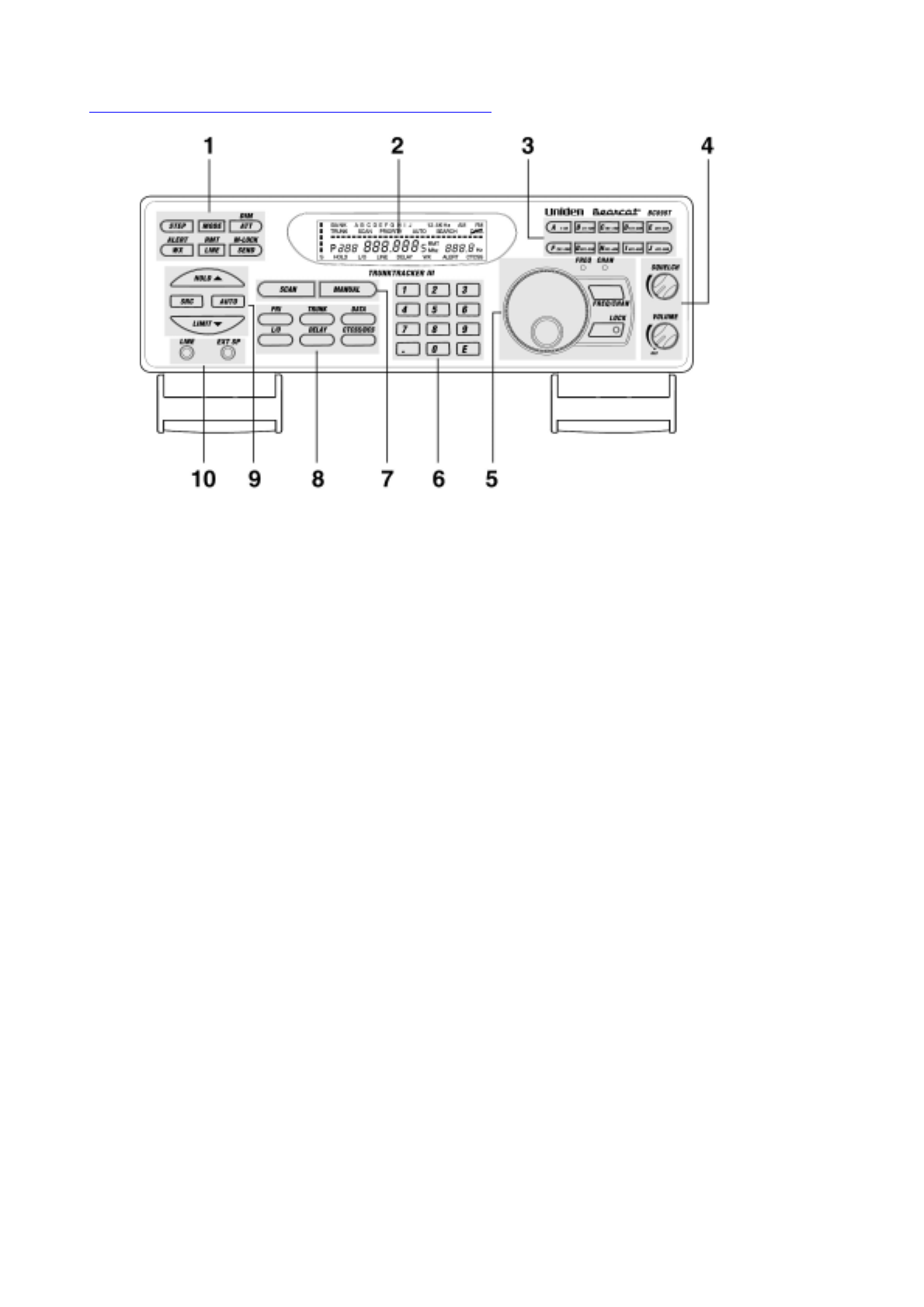
A Quick Look at Your Scanner
1. Programming and Status Keys
2. Display
3. Bank Keys
4. Squelch/Volume Controls
5. Rotary Tuner
6. Numeric Keypad
7. Scan/Manual Keys
8. Mode Keys
9. Search Keys
10. External Speaker/Line Jacks
53/305 ページCONTENTS
2004/04/01file://¥¥Fileserv0¥OM¥UB322Z_BC898¥Software%20Help.htm
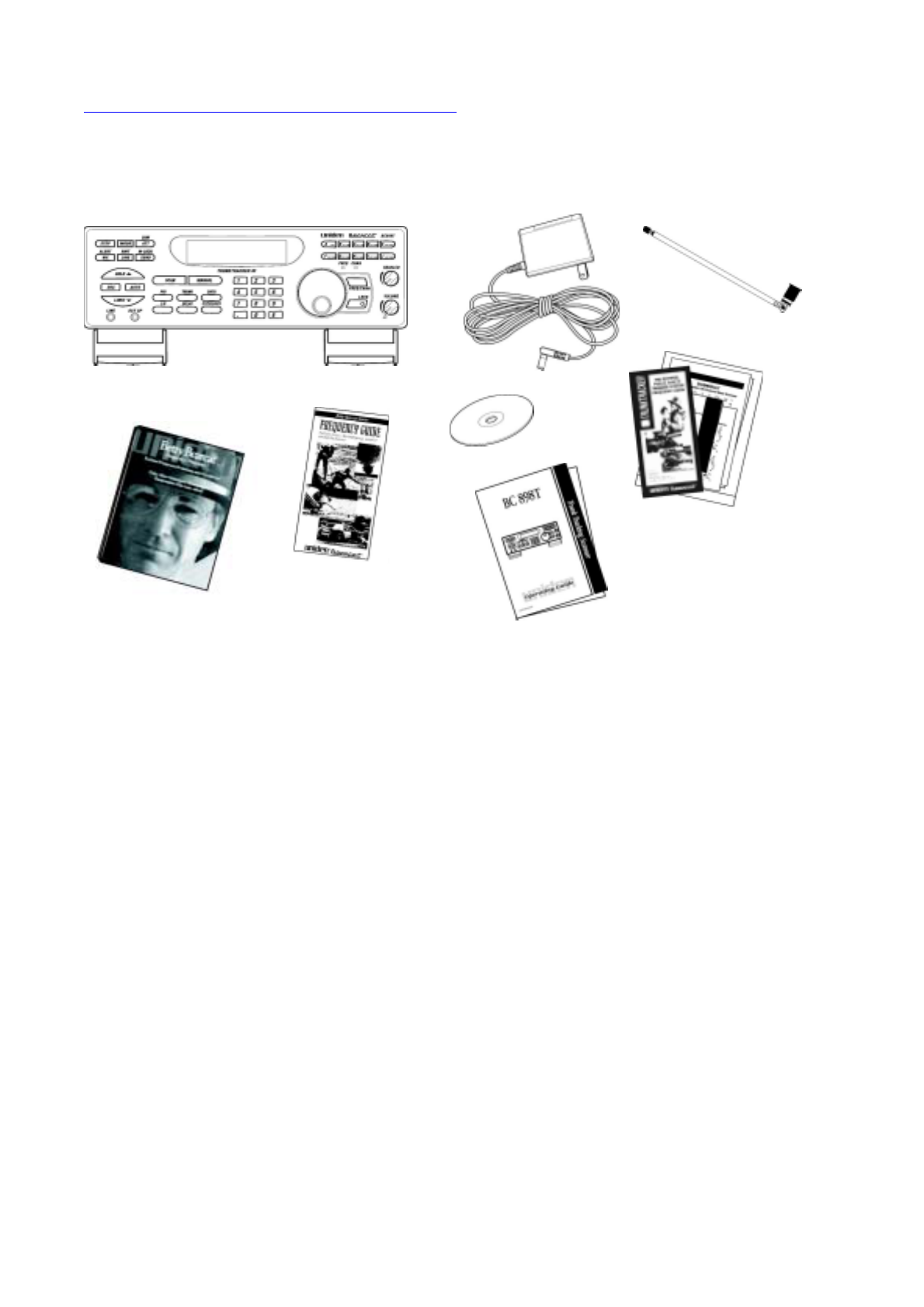
Included With Your Scanner
If any of these items are missing or damaged, immediately contact
your place of purchase or Uniden Customer Service at: (800) 297-
1023, 8:00 a.m. to 5:00 p.m., Central, Monday through Friday.
54/305 ページCONTENTS
2004/04/01file://¥¥Fileserv0¥OM¥UB322Z_BC898¥Software%20Help.htm
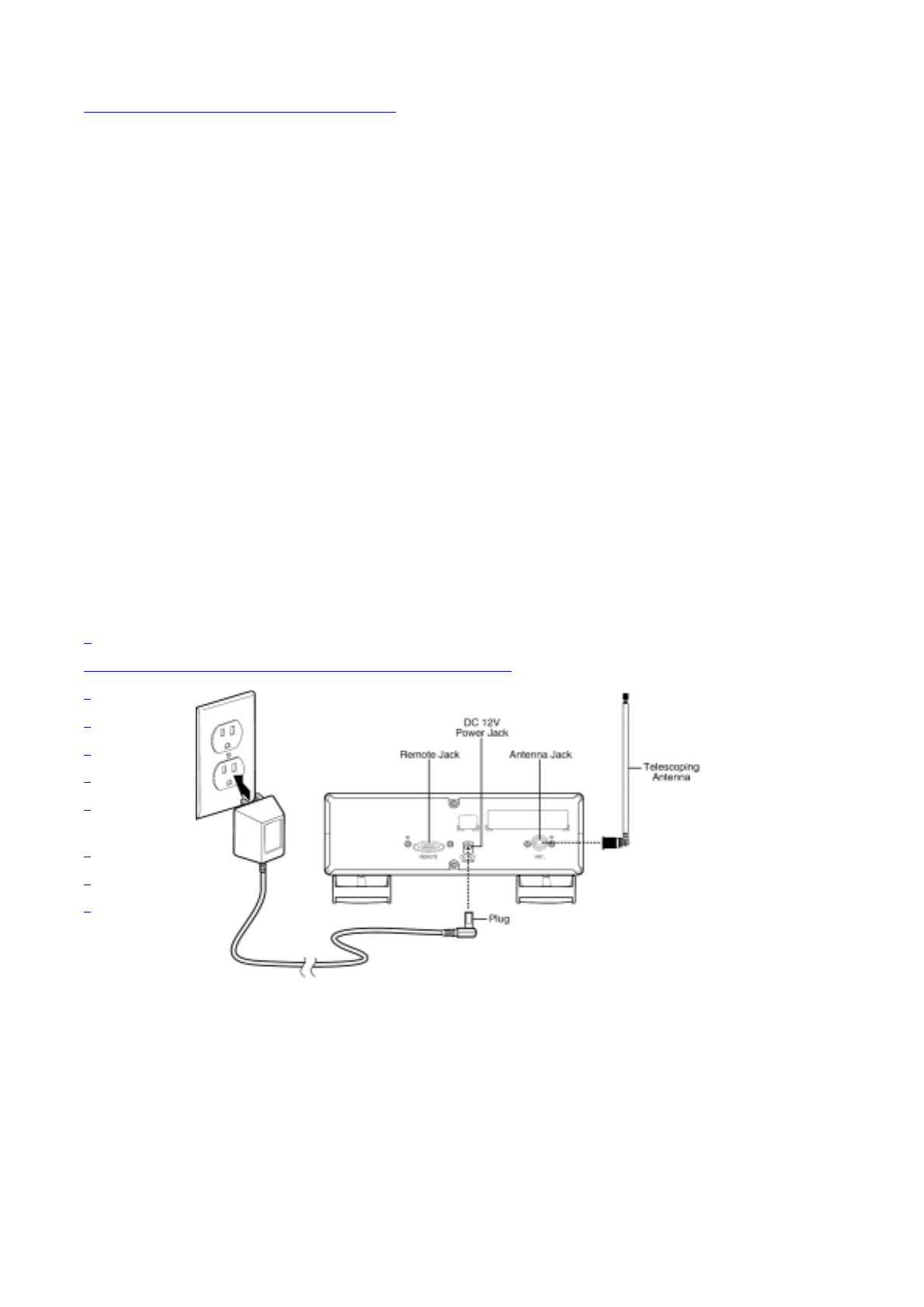
Installing Your Scanner
These guidelines will help you install and use your new scanner:
zIf your scanner receives interference or electrical noise, move
the scanner or its antenna away from the source. You might
also try changing the height or angle of the telescoping
antenna.
zTo improve the scanner’s reception, use an optional external
antenna designed for multi-band coverage. (You can
purchase this type of antenna at a local electronics store). If
the optional antenna has no cable, use 50-70 ohm coaxial
cable for lead-in. A mating plug might be necessary for the
optional antennas.
zUse the included earphone or an optional stereo headset with
proper impedance for private listening. Read the precautions
on the inside front cover of this Guide.
zDo not use the scanner in high-moisture environments such
as the kitchen or bathroom.
zAvoid placing the scanner in direct sunlight or near heating
elements or vents.
For Home Use (Desktop Installation)
1. Insert the DC plug end of the included AC adapter into the DC
13.8V jack on the back of the scanner.
2. Plug the other end of the AC adapter into a standard 120V AC
wall outlet.
3. Plug the included telescoping antenna into the ANT connector
on the back of the scanner. Then extend the antenna to its full
height.
55/305 ページCONTENTS
2004/04/01file://¥¥Fileserv0¥OM¥UB322Z_BC898¥Software%20Help.htm
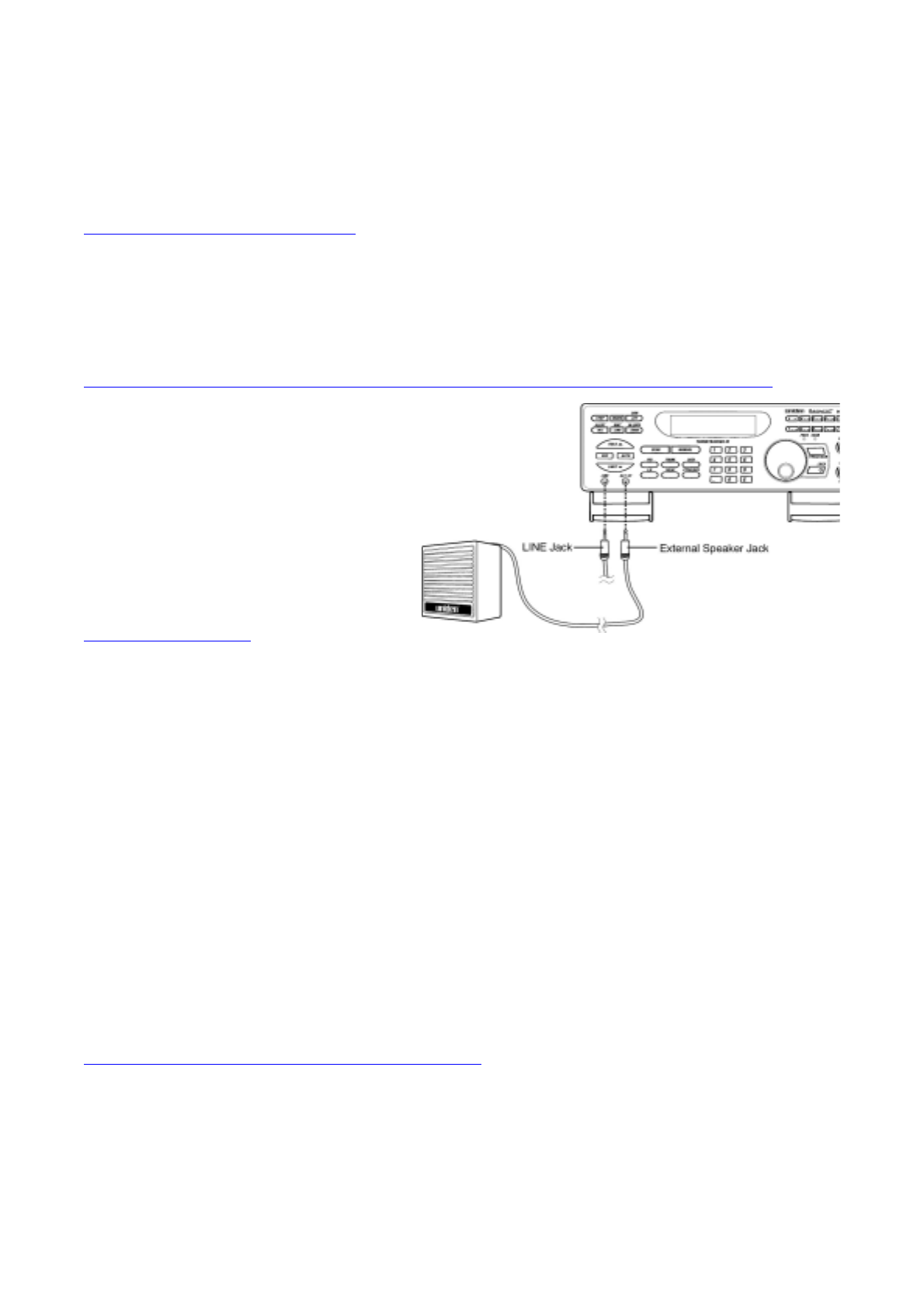
Note: For frequencies higher than 406 MHz, shortening the
antenna might improve the reception.
4. Use the scanner’s desktop stand for a better viewing and
operating angle.
Adapter Safety Feature
The AC adapter included with the scanner might be equipped with a
polarized line plug — a plug with one blade wider than the other.
This plug fits into a power outlet only one way. If you are unable to
insert the adapter’s plug into an AC outlet, try reversing the plug.
Using An Optional External Speaker/Earphone/Headphone
For private listening or for listening
in a noisy area, you can plug a
1/8-inch (3.5mm) mini-plug
earphone’s or headphone’s or
monitor speaker’s (not supplied)
cable into the EXT SP jack on the
front of the scanner.
This automatically disconnects
the scanner’s internal speaker.
Listening Safely
To protect your hearing, follow these guidelines when you use an
earphone or headphones.
zDo not use an earphone to listen to the WX alert siren test or
when in SAME alert mode. The alert tone’s volume is not
adjustable and damage to your hearing could occur.
zDo not listen at extremely high volume levels. Extended high-
volume listening can lead to permanent hearing loss.
zSet VOLUME to the lowest setting before you begin listening.
After you begin listening, adjust VOLUME to a comfortable
level.
zOnce you set VOLUME, do not increase it. Over time, your
ears adapt to the volume level, so a volume level that does
not cause discomfort might still damage your hearing.
Using An Optional Tape Recorder
Your tape recorder must have both microphone and remote input
j
acks to work with the scanner. Follow these steps to connect the
recorder to the scanner:
1. Connect a cable from the LINE jack on the front of the
scanner to the tape recorder’s microphone jack.
56/305 ページCONTENTS
2004/04/01file://¥¥Fileserv0¥OM¥UB322Z_BC898¥Software%20Help.htm
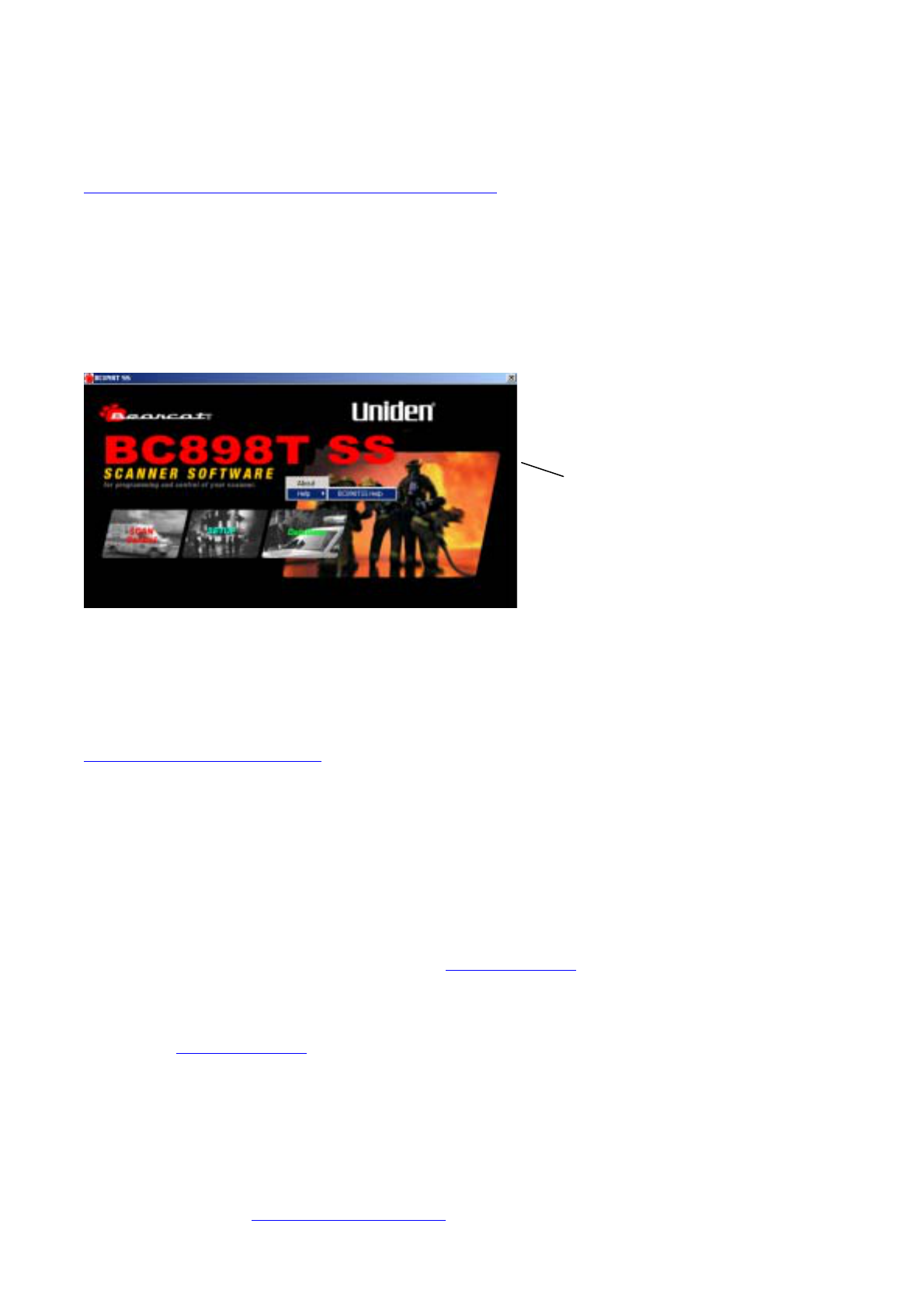
2. Connect a cable from the RCA-type AUX jack on the back of
the scanner to the tape recorder’s remote jack.
Using the Supplied Demo Software
You can operate your scanner using a personal computer and the
supplied demo software.
If you have installed the software and it is running, select Help by
right clicking anywhere on the opening screen. A selection popup
appears. Move the cursor to Help. BC898TSS Help appears. Then
click on BC898TSS Help.
Main Selection Screen
To use the computer controlled feature, hold down RMT on the front
of the scanner until you hear two short beeps, then refer to the
information in the supplied help file.
Press RMT again to cancel the computer controlled feature.
Installing The Software
The demo software’s installation program starts automatically when
you insert the included CD into your computer’s CD-ROM drive.
The following programs are included on the CD.
zBC898T SS Install – Installs the software. You must install the
software to use the scanner with your computer.
zAcrobat Reader Install – Installs Adobe Acrobat Reader onto
your computer. To read the electronic Owners Manual
included with the scanner, you must install Adobe Acrobat
Reader if it is not already installed.
zView Owners Manual – Lets you view the electronic Owners
Manual.
After you install the BC898T SS Install program (and Adobe
Acrobat Reader if necessary), start it by double clicking on the
desktop icon or by selecting it in the Start Programs list.
You can upgrade the included software to a full version by obtaining
a registration key at http://www.uniden.com/.
Opening
Screen
57/305 ページCONTENTS
2004/04/01file://¥¥Fileserv0¥OM¥UB322Z_BC898¥Software%20Help.htm
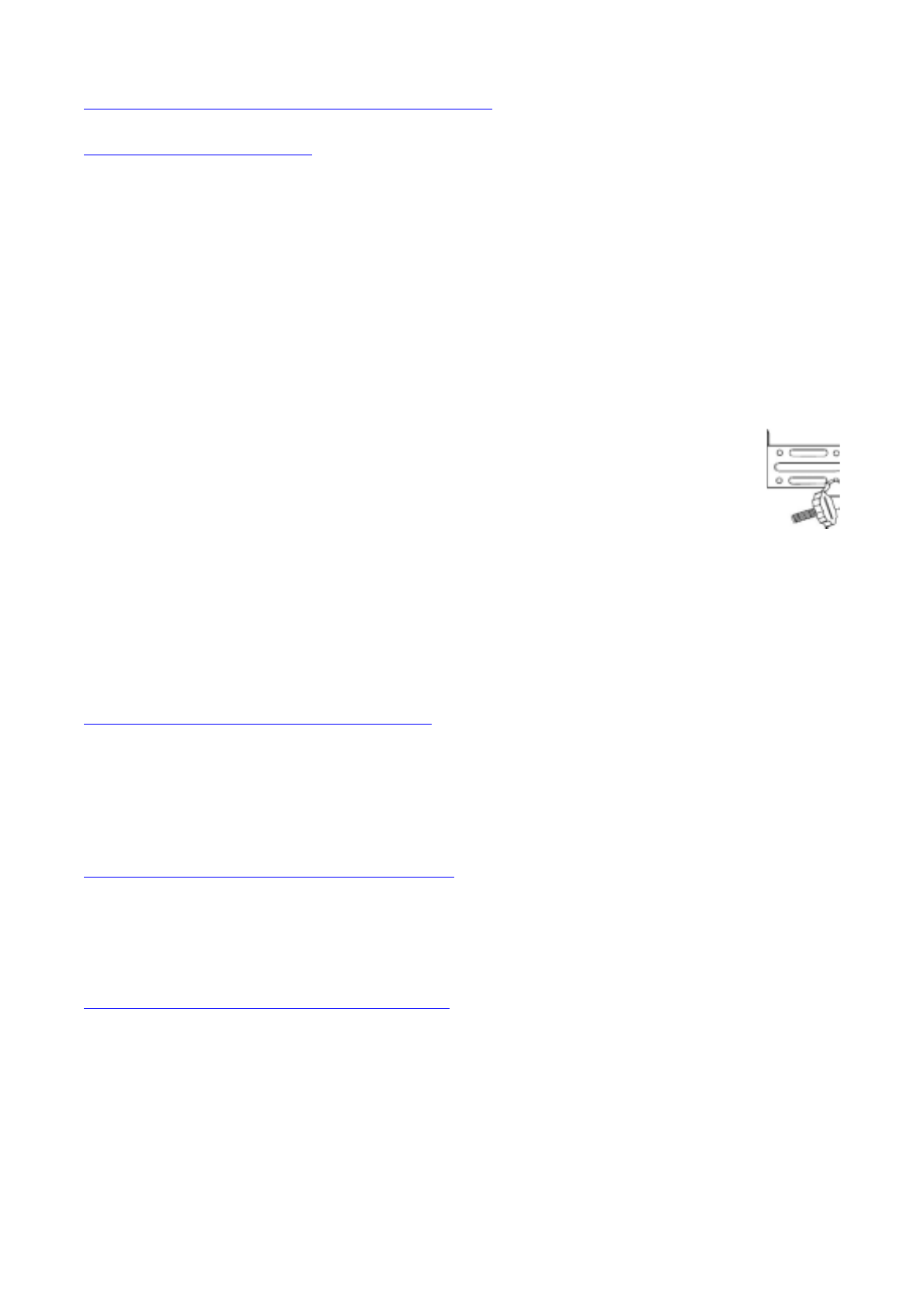
Installing The Scanner In a Vehicle
Mounting the Scanner
1. Select a location in your vehicle to mount the scanner. Avoid
a location that could interfere with your driving. In a passenger
car, the ideal location is underneath the dashboard on the
passenger side.
Warning: Make sure there are no obstructions such as wires
or an air bag behind the mounting location you select. Use
the shortest mounting screws that will securely hold the
mounting bracket on the mounting location you select. If you
are not sure if the mounting location is safe and free of
obstructions, check with your vehicle’s dealer.
2. Use an optional mounting bracket as a template
for marking the location for the mounting screws.
Note: If there are screws already holding the
dashboard, you can use the same screw holes
to mount the bracket.
3. Drill the necessary holes and secure the mounting bracket in
place using the screws provided with the bracket.
4. Mount the scanner to the bracket only after the wiring has
been connected to the scanner’s rear panel.
Connecting the Antenna Plug
Connect an optional mobile antenna plug into the ANT connector
on the back of the scanner. (For more information on antenna
installation, please refer to the instruction guide that came with your
antenna.)
Connecting the DC Power Cord
If you are not experienced in connecting accessories to your
vehicle’s fuse box, please consult your vehicle’s dealer for advice
on proper installation before completing the steps below.
Installing a Temporary Power Cord:
Warning: Do not use the cigarette lighter power cord in a positive
ground vehicle.
Use an optional cigarette lighter power cord for an easy, temporary
installation.
Plug one end of the cigarette lighter power cord into your vehicle’s
cigarette lighter jack, then plug the other end into the DC 13.8V jack
on the back of the scanner.
59/305 ページCONTENTS
2004/04/01file://¥¥Fileserv0¥OM¥UB322Z_BC898¥Software%20Help.htm
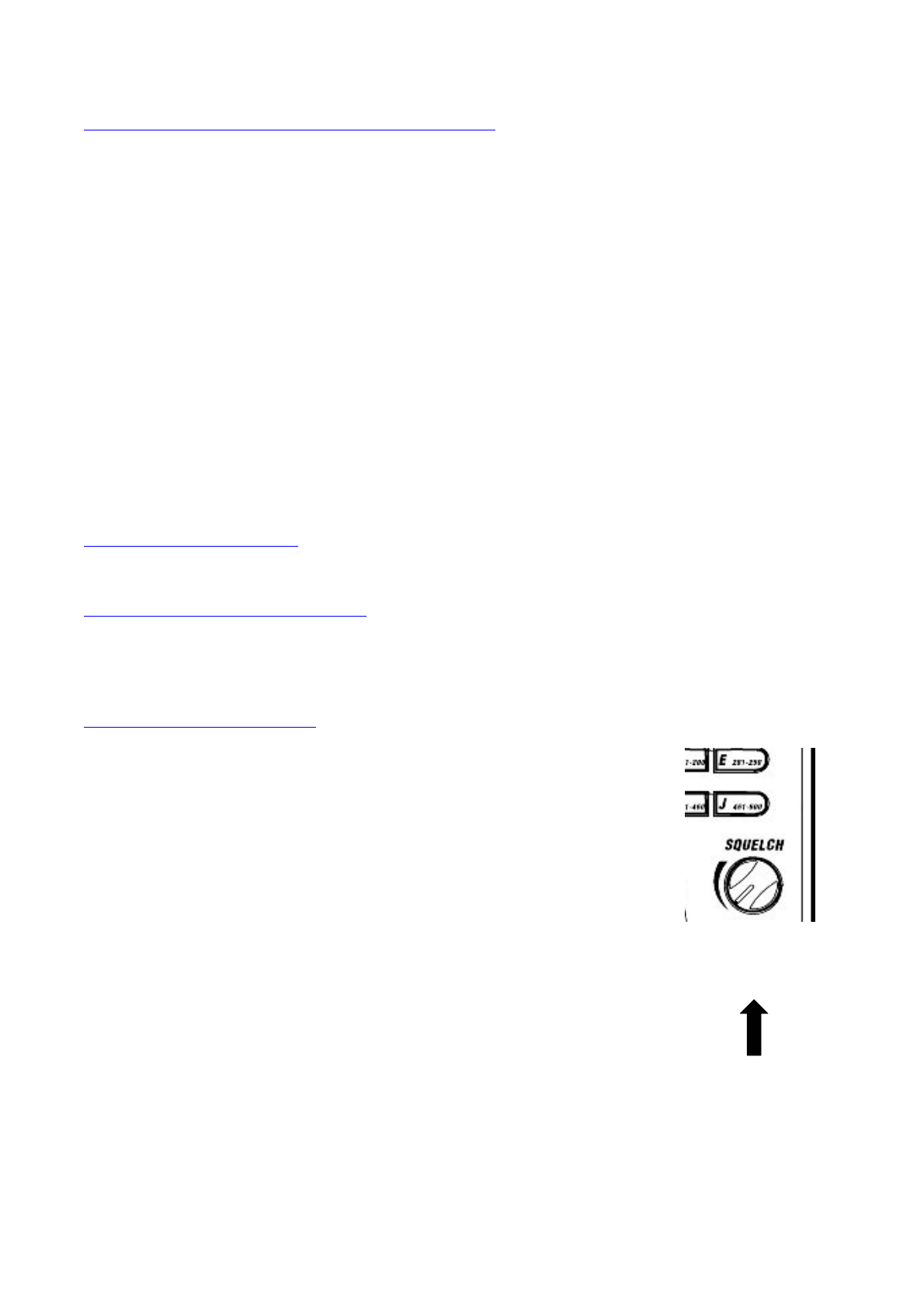
Installing a Permanent Power Cord
1. Check the vehicle’s battery connections to determine which
battery terminal (positive or negative) is grounded to the
engine block or chassis. Most of today’s vehicles use a
negative ground. If your vehicle has a negative ground, follow
the steps below. Otherwise, consult your vehicle’s dealer for
advice on installing negative ground accessories in your
vehicle.
2. Connect an optional DC power cord’s RED wire to the
accessory contact in your vehicle’s +13.8 VDC fuse box.
3. Connect the DC power cord’s BLACK wire to the negative
side of the vehicle (usually the chassis).
4. Insert the DC plug into the DC 13.8V jack on the back of the
scanner.
Basic Operation
Turning On the Scanner
Turn VOLUME clockwise to turn on the scanner, or
counterclockwise until it clicks to turn it off.
Setting the Squelch
Your scanner’s squelch control acts like a gate to reduce or
eliminate
noise from received signals. Turning SQUELCH counterclockwise
raises the gate so high that only very strong signals can get
through,
while turning SQUELCH clockwise lowers the gate so that
everything
can get through — noise, weak signals, and strong signals.
To set the squelch, you must first set the scanner to its manual
mode
and the scanner must not be receiving a signal.
Follow these steps to set the scanner’s squelch.
1. Adjust VOLUME to a comfortable listening level.
2. Hold down MANUAL until you do not hear a signal.
3. Turn SQUELCH fully clockwise.
4. Turn SQUELCH counterclockwise until you hear a hiss.
60/305 ページCONTENTS
2004/04/01file://¥¥Fileserv0¥OM¥UB322Z_BC898¥Software%20Help.htm

5. Turn SQUELCH back clockwise just until the hiss stops. This
sets the squelch so that only clearer signals can get through.
In trunking mode, it usually isn’t necessary to manually adjust the
squelch since it is automatically adjusted. However, the squelch
setting you select before you begin trunk tracking can affect how
fast your scanner acquires the data channel, and, in some
instances, the squelch setting can prevent your scanner from
acquiring the data channel at all.
You can change the squelch setting, if necessary, to provide better
performance in your area.
61/305 ページCONTENTS
2004/04/01file://¥¥Fileserv0¥OM¥UB322Z_BC898¥Software%20Help.htm
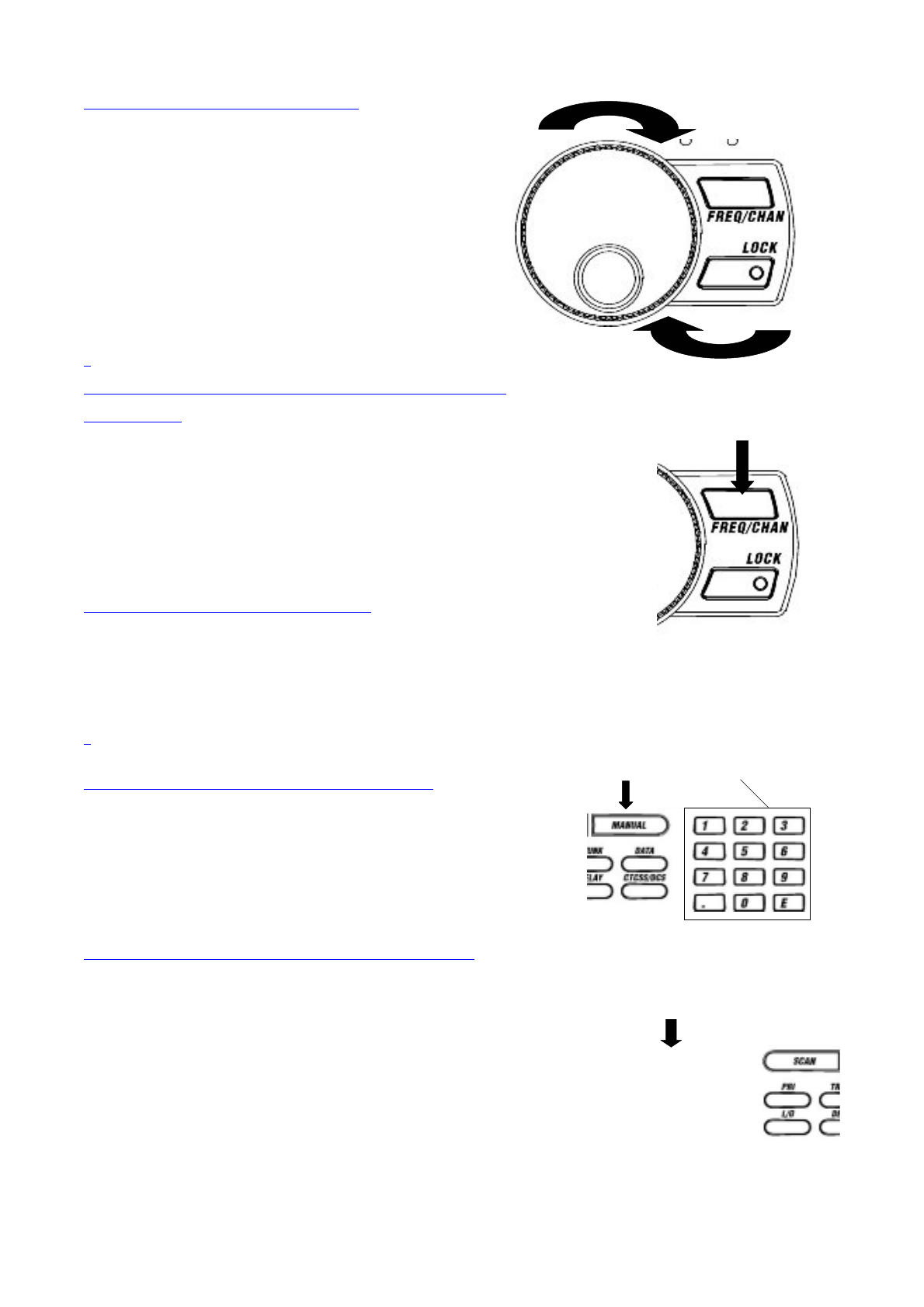
Using the Rotary Tuner
Use the rotary tuner to:
zRapidly and precisely select frequencies
or channels
zSelect a CTCSS tone during CTCSS
programming
zScroll through scan and lockout lists in
the trunking mode.
Using the Frequency/Channel Mode
Selector
Repeatedly press FREQ/CHAN to switch between channel and
frequency mode. When the CHAN LED is on, you can use the
rotary tuner to step rapidly through channels. When the FREQ
LED is on, you can use the rotary tuner to tune frequencies
quickly and accurately.
Using the Lock Key/LED
Press LOCK to enable or disable the rotary tuner. When the LOCK
LED is on, the rotary tuner is locked. This prevents accidentally
changing the displayed channel and frequency while monitoring a
transmission.
Manually Selecting a Channel
To manually select a channel, press MANUAL, enter the
channel’s number using the keypad, then press MANUAL
again. The channel’s number and any frequency stored
in the channel appears.
Scanning Programmed Channels
Before you can scan, you must first program channels. See the appropriate
programming section for complete instructions.
To begin scanning, simply turn on your scanner or, if the scanner
is not currently scanning, press SCAN.
The scanner checks each system you have programmed that is
not locked out and stops if there is activity. SCAN scrolls across
the display, right to left.
Keypad
62/305 ページCONTENTS
2004/04/01file://¥¥Fileserv0¥OM¥UB322Z_BC898¥Software%20Help.htm

When the scanner receives a signal on a programmed channel, it
stops on that channel and displays the channel information.
The bank indicators A – J selected for scanning appear, and the
bank you are currently monitoring flashes. You can deselect banks
from active scanning by pressing that bank’s number on the
keypad. The indicator for each deselected bank turns off, and the
scanner does not scan that bank’s channels.
Note: One bank must always be active. You cannot deselect all ten
banks at the same time. If you try to turn off all the banks, the
scanner automatically selects the first bank.
To restore a bank to active scanning, press the bank’s number on
your keypad. The bank’s indicator appears.
Press MANUAL to stop on a channel while scanning. Press SCAN to
resume scanning.
Locking/Unlocking Banks
When you are scanning conventional banks, the scanner displays
the digit corresponding to all unlocked banks. To lock out a bank so
that the scanner does not scan its channels, press the number that
corresponds to the bank. The scanner replaces that bank’s number
with a dash.
To unlock locked-out banks, simply press that bank’s number
again. The scanner displays that bank’s number and includes it
when scanning.
Note: You cannot lock out all banks. One bank must be unlocked at
all times.
Locking/Unlocking Channels
To lock out a channel so that the scanner does not stop on it while
scanning, press
L/O when the scanner is stopped on that channel, or manually
select the channel
and press L/O.
To unlock the channel, manually select it and press L/O again.
Note: You cannot lock out all channels in a bank. At least one
channel must remain unlocked. If you want to lock out an entire
bank, see the previous section.
Restoring All Locked Out Channels
To simultaneously unlock all channels, press MANUAL then hold
down L/O for about 2 seconds. The scanner beeps twice and
unlocks all channels.
63/305 ページCONTENTS
2004/04/01file://¥¥Fileserv0¥OM¥UB322Z_BC898¥Software%20Help.htm

Priority Scanning
When priority scan is turned on, the scanner checks the priority
channels in the unlocked banks every 2 seconds between
transmissions. If a signal is present on a priority channel, the
scanner switches to monitor that transmission, even if it had been
stopped on another channel. One channel in each bank is
designated as the priority channel.
To turn priority scan on or off, press PRI. PRIORITY appears (if
priority scan is on) or disappears (if priority scan is off).
Note: If all priority channels in unlocked banks are locked out,
LocOut appears when you try to turn on the priority scan mode.
Changing the Priority Channel
You cannot eliminate the priority channel, but you can change it to
any of the 50 available channels in each bank. Follow these steps
to change the priority channel.
1. Press MANUAL.
2. Use the keypad to enter the channel number for the new
priority channel.
3. Press MANUAL.
4. Hold down PRI for about 2 seconds.
The scanner beeps twice and the priority channel changes to the
one you selected.
Using the Dimmer
Hold down DIM for about two seconds to dim the back light, turn it
off, or turn it on.
Trunk Scanning Options
When you are scanning a trunked system, there are several
trunking-only options available to you. This section outlines these
options.
Searching for Active Talk Groups (ID Search)
If you want to hear all activity on a system, use
the ID search mode by pressing MANUAL then
SRC. SEARCH appears and the BC898T stops
on every active talk group, regardless of whether
you have programmed it into your scanner.
This makes it easy to find unknown talk groups.
65/305 ページCONTENTS
2004/04/01file://¥¥Fileserv0¥OM¥UB322Z_BC898¥Software%20Help.htm

Note: If you have not yet programmed any talk group IDs into the
scanner, this is the only trunk scanning mode available.
Searching Only Stored Talk Groups (ID Scan)
To scan only those talk groups you have stored into your scanner,
press SCAN. When one of the talk groups you have stored
becomes active, the scanner switches to that transmission and
displays the ID number for that talk group.
Note: You must store at least 2 talk group IDs in the system for ID
scanning to work.
Monitoring Talk Group IDs
To see all the talk group IDs that are active on the system, while
monitoring a trunked system press TRUNK. The scanner stops
trunking the system and instead holds on the system’s control
channel. You hear the control data and the scanner displays every
talk group ID as it becomes active in the system. To resume trunk
tracking, press TRUNK again.
Holding On a Single Talk Group
To hold on an active talk group when scanning or searching, press
HOLD U. The BC898T stops scanning and holds on the current
trunking system. It only receives transmissions on the talk group
that was active when you pressed HOLD U.
To select a talk group to hold on when that talk group is not active,
you must first program that talk group into an ID list. Then, while
scanning that system, use the scroll bar to select the talk group ID
to hold on.
To select a talk group to hold on when that group is not active,
while ID scanning or ID searching the system, press HOLD U.
Then, either enter the ID or (if you have stored the ID) scroll to the
ID you want to hold on.
Locking Out Talk Groups
Like conventional scanning, you can lock out unwanted talk group
traffic on trunking systems. This is particularly important if you are
ID searching a trunking system, as many systems share both voice
traffic (that you usually want to hear) with some data traffic from
water meter systems, door alarms, traffic signals and other data
sources that you don’t want to hear. You can lock out up to 200 talk
group IDs at the same time.
To lock out a talk group, press L/O when the scanner stops on that
group. Or, if you have stored the talk group in an ID list, select that
ID and press L/O.
66/305 ページCONTENTS
2004/04/01file://¥¥Fileserv0¥OM¥UB322Z_BC898¥Software%20Help.htm
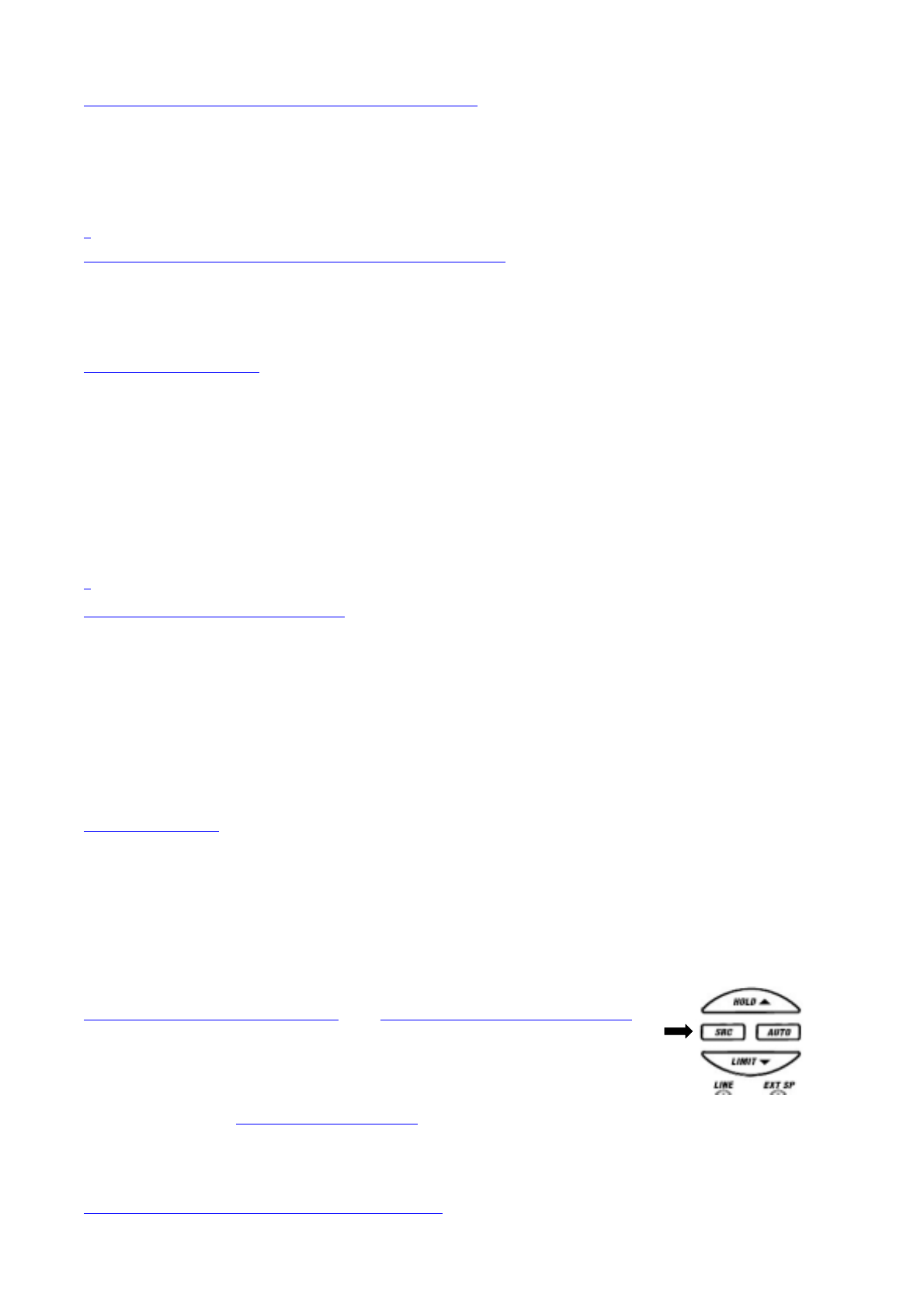
Reviewing Locked Out Talk Group IDs
You can confirm which talk group IDs are locked out in the scanner.
To review locked out talk group IDs, hold down L/O for about 2
seconds. The locked-out talk group IDs appear.
Restoring All Locked Out Talk Group IDs
To restore all locked out talk group IDs, press HOLD U then hold
down L/O for about 2 seconds.
EDACS Blockout
This is a powerful form of lockout that is only available for EDACS
systems. EDACS Blockout lets you lock out entire agencies or
fleets, not just individual talk groups.
To use blockout, while scanning an EDACS system, press HOLD U
then hold down L/O for about 2 seconds to clear all the lockouts
from the system. Then enter the agency or the agency and fleet
and press . then press L/O.
Setting the Attenuator
If you are near a very strong signal source, the signal can overload
the scanner’s RF front end, causing poor audio quality or missed
reception.
Repeatedly press ATT until ATT appears (to turn the attenuator on)
or until ATT disappears (to turn the attenuator off).
Searching
Your BC898T includes powerful search features that let you
discover new active frequencies in your area. You can save up to
10 custom search ranges in your scanner. This section details how
to use custom search ranges and also details the various settings
that affect search operation.
To start a search, first program one or more search ranges (see
Setting a Single Search Range and Setting a Chain Search Range).
Then, press SRC. The scanner begins searching within the selected
search range. To change to a different search range, press the
number button associated with that range. By default, your scanner
only searches one range at a time. To search multiple ranges, turn on
chain search (see Setting Chain Search). When you turn on chain
search, each time you press a number button, the associated range is turned on or off.
Note that you must have at least one range turned on at all times.
Setting a Single Search Range
68/305 ページCONTENTS
2004/04/01file://¥¥Fileserv0¥OM¥UB322Z_BC898¥Software%20Help.htm

The BC898T can search a specific frequency range to find
frequencies if you don’t have a frequency guide available or if new
stations have been added since your guide was published.
1. Press MANUAL to stop scanning.
2. Use the keypad to enter the lower frequency of the search
range. For example, enter 155.000 MHz.
3. Press LIMIT V.
4. Use the keypad to enter the higher frequency of the search
range. For example, enter 157.000 MHz.
5. Press LIMIT V.
6. Press SRC.
You can press STEP to change the step increment during a search.
Repeatedly press STEP until you select the increment you want. If
you select the default step increment for the frequency band you
are searching, the indicator stops flashing.
Setting a Chain Search Range
The scanner allows you to search multiple ranges simultaneously.
You can search up to 10 different search bands and all ranges in a
chain of frequency bands.
1. Press MANUAL to stop scanning.
2. Press SRC.
3. Press HOLD U.
4. Use the rotary tuner to set the scanner to search hold mode.
5. Select the search range by pressing A-J. The selected range
and the low and high frequencies within the range flash.
6. Use the keypad to enter the lower frequency of the search
range. For example, enter 155.000 MHz.
7. Press E or LIMIT V.
8. Use the keypad to enter the higher frequency of the search
range. For example, enter 157.000 MHz.
9. Press E or LIMIT V.
10. Press SRC to start chain search.
69/305 ページCONTENTS
2004/04/01file://¥¥Fileserv0¥OM¥UB322Z_BC898¥Software%20Help.htm

The scanner searches only one range at a time.
Holding On An Active Frequency
To hold on the current frequency, press HOLD U.To resume
searching, press SRC.
Setting Chain Search
The scanner allows you to search multiple conventional frequency
ranges simultaneously. The scanner searches only one range at a
time.
Note: You cannot use chain search to search trunked frequencies.
You can search trunked frequencies using the scanner’s ID search
mode.
1. Press SRC.
2. Press HOLD U or rotate the rotary tuner to go to search hold
mode.
3. Press the bank keys where you want to search for
frequencies. The selected range and the lower and upper limit
frequencies for the range you selected appear.
4. Use the keypad to enter the lower and upper frequency limits,
then press E.
5. Press SRC to start chain search.
Setting Data Skip
The scanner normally stops on any frequency with activity, and
remains there until either the activity stops or you press SRC to
resume scanning. However, some signals are identifiable by the
scanner as data signals, and you can set the scanner to
automatically skip these channels.
Note: Even with this option turned on, the scanner might pause for
a couple of seconds on data transmissions before resuming.
Skipping Frequencies
If a particular frequency continues to interrupt search scanning, you
can set the scanner so it skips the frequency.
To skip over a frequency, press L/O when the scanner is stopped
on a frequency you want to skip.
Notes:
70/305 ページCONTENTS
2004/04/01file://¥¥Fileserv0¥OM¥UB322Z_BC898¥Software%20Help.htm

zYou can program up to 200 skip frequencies. The 201st skip
frequency entered causes the first skipped frequency to
unlock.
zIf all frequencies in the search range are set to skip, a beep
sounds and it moves to search hold mode. To resume
searching:
a. Unskip all skipped frequencies
—- OR —
b. Select a different search frequency range.
To unskip all skipped frequencies, hold down L/O for about 2
seconds in search hold mode.
Storing Found Frequencies
If you find a frequency you want to save into a channel, simply
press E or SEND when the scanner is stopped on that frequency.
Notes:
zIf you have already stored this frequency, the scanner
displays a warning and the channel where the frequency is
stored. To store the frequency anyway, press E again.
zAfter you store the frequency, the scanner resumes
searching.
zIf all channels are used, the scanner defaults to the last-used
channel prior to entering the search mode.
Automatically Storing Frequencies
During searching, you can have the scanner automatically store
active frequencies into a bank you choose.
Note: You must program a chain search range for auto store to
work.
1. Press AUTO.
2. Press the bank keys where you want to store the frequencies
the scanner finds. The bank letter you select stops blinking.
3. If the bank you selected has no empty channels, FULL
appears for about 3 seconds and the scanner sounds an error
tone.
4. Press SRC to start the auto-store operation.
71/305 ページCONTENTS
2004/04/01file://¥¥Fileserv0¥OM¥UB322Z_BC898¥Software%20Help.htm

5. Press MANUAL or HOLD U to stop auto store. The scanner
exits the auto store mode.
Note: To ensure that you catch most active frequencies for
the band, you should allow the auto store operation to
continue through at least a few complete sweeps of the
band. Depending on the types of services, some
occasionally active frequencies might not have activity for
minutes or hours at a time.
Setting Subaudible Tones for Searching
You can set the scanner to only stop on transmissions that either
have no subaudible tone or include a specified CTCSS or DCS tone
during searches. This setting affects all search ranges. For this
feature to work, you need to turn on the tone mode (see Setting the
Squelch).
1. Press PRI to turn off priority scan.
2. Hold down CTCSS/DCS for about 2 seconds. CTCSS and
DCS blink and the scanner searches for CTCSS or DCS
tones. When the scanner finds a CTCSS or DCS tone, the
frequency blinks.
Attenuating All Search Ranges
If you are near a strong RF source, you might need to attenuate the
input signal in order to search properly. Repeatedly press ATT until
A
T
T
appears (to turn on attenuation) or until ATT disappears (to
turn off attenuation).
Setting Delay For All Search Ranges
You can set the scanner to have a 2-second delay after the end of
a transmission before searching resumes. This slows searching,
but helps you prevent missing replies on a frequency. To turn on
this option for all search ranges, select the channel where you want
to add a delay then press DELAY.
Searching a Trunked Bank
Before you search a trunked bank with your scanner, consider the
following:
zYou can only trunk track one bank at a time.
zUse TRUNK to toggle between the conventional and the trunk
tracking modes.
zPress DATA while in the trunk tracking mode to review which
bank is currently in use. The appropriate bank icon will flash
72/305 ページCONTENTS
2004/04/01file://¥¥Fileserv0¥OM¥UB322Z_BC898¥Software%20Help.htm

at the top of the display for 5 seconds.
If you have programmed frequencies for a trunked system in one or
more of the 10 available banks and you are in conventional mode,
follow these steps to begin trunk searching:
1. Press TRUNK. The bank indicators begin to flash.
2. Press A-J to select the trunked bank you want. For example
press B.
Note: You will see the frequencies quickly displaying as your
scanner looks for the data channel, which controls the
system.
Once the data channel is acquired, the scanner begins trunk
tracking. Talk group
IDs, which represent different service groups, appear.
3. Press TRUNK again to return to conventional scanning mode.
While searching, you won’t know exactly to whom the IDs are
assigned until you listen awhile or until ID lists are available in
frequency guides or on internet sites. However, it usually only takes
a few minutes to figure out police, fire, and emergency medical
personnel. Other IDs might take some time, but determining who
each ID represents is half the fun of TrunkTracker™.
Trunk ID Hold Mode
During trunking search mode, you can hold on an ID without
entering it into memory.
1. Press HOLD U while in search mode.
2. Use the keypad to enter the ID you want.
3. Press HOLD U again. HOLD flashes.
4. Press SRC to return to search mode.
Note: The ID hold mode works in scan list mode, and the steps are
the same; however, SEARCH doesn’t appear in the display.
Using Weather Search and Weather Alert
(SAME)
Your scanner allows you to either search for a local NOAA weather
broadcast, or be set to alert when a SAME weather alert is
broadcast on a NOAA channel.
Weather Alert
73/305 ページCONTENTS
2004/04/01file://¥¥Fileserv0¥OM¥UB322Z_BC898¥Software%20Help.htm

In weather alert mode, your scanner functions as a severe weather
warning radio. This is especially useful when your area is expecting
severe weather conditions late at night. When you set the scanner
to weather alert mode, it emits a loud siren and displays information
about the weather alert whenever your local NOAA weather station
transmits a severe weather emergency tone.
To use weather alert:
1. Press WX to find your local weather station.
2. Press HOLD U.
3. Hold down ALERT for about 2 seconds. ALERT appears.
Your scanner’s volume is muted until the warning tone sounds.
Your scanner now functions as a weather alert radio, waiting to
receive a severe weather emergency tone. When your scanner
receives the emergency tone and a SAME event code from your
local NOAA weather station, it responds with a loud siren at
maximum volume (regardless of the volume control setting) and
displays information about the alert.
You might see any of the following information during a weather
alert:
L1 – Warning
L2 – Watch
L3 – Statement
TsT - Test
The siren will continue until the emergency tone stops transmitting.
To cancel the siren, press WX or turn the rotary tuner.
Searching for a Weather Broadcast
You can use the BC898T to search for your local NOAA weather
channel.
To use weather alert, press WX to find an active weather channel in
your area. WX appears.
You might receive more than one weather station in your area.
When you press WX, your scanner finds the first active
transmission. If a transmission seems weak or distant, press WX
again to find a clearer station.
Notes:
zWeather scan does not resume automatically. You must press
WX again to start the weather scan again. In some parts of the
country, you might not be able to monitor weather
transmissions, such as in low-lying areas. Normally a higher
location will improve the reception.
74/305 ページCONTENTS
2004/04/01file://¥¥Fileserv0¥OM¥UB322Z_BC898¥Software%20Help.htm

• NOAA broadcasts are continuous broadcasts. You will only
lose reception if you move out of a coverage area. If the
signal is lost, the scanner resumes searching for a weather
transmission.
Programming a FIPS Code
1. Hold down WX to turn on weather alert.
2. Hold down E.
If the scanner has not been set to alert for any FIPS code,
____ appears. If the scanner is set to alert for all FIPS
codes, ALLFIPS appears. If the scanner is set to alert only
for the area you programmed, F1 appears.
3. Turn the rotary tuner or repeatedly press HOLD U or LIMIT
V to enter a FIPS code (1 through 15). Then press E to
enter the FIPS code or . to clear it.
4. To set the scanner so it sounds an alert tone when it
receives any FIPS code, turn the rotary tuner or repeatedly
press HOLD U or LIMIT V to move ALLFIPS to F1. To set
the scanner so it sounds an alert tone when it receives only
the FIPS code you programmed, turn the rotary tuner or
repeatedly press HOLD U or LIMIT V to move F1 to F15.
Then press E.
5. Press ALERT to exit this mode.
Search Hold
1. Press HOLD U at any time to stop the search.
2. Press HOLD U to move to the next higher frequency
— or —
3. Press LIMIT V to move down to the previous frequency.
Note: You can also use the rotary tuner to move to other
frequencies. Simply make sure the FREQ LED is lit before
turning the dial.
4. Press SRC to resume searching.
Searching for CTCSS/DCS Tones
You can use the CTCSS/DCS tone search mode to determine if the
frequencies in your area are transmitted with associated tones. If
75/305 ページCONTENTS
2004/04/01file://¥¥Fileserv0¥OM¥UB322Z_BC898¥Software%20Help.htm

the scanner finds a CTCSS or DCS tone, the type of tone and the
frequency flash on the display. Then, if you store that frequency into
a channel, the tone is also stored in the channel.
Notes:
zYou can search for CTCSS/DCS tones in scan mode, manual
mode, or chain search mode. You cannot search for
CTCSS/DCS tones while the scanner is scanning a priority
channel.
zYou might find frequencies that do not have a tone associated
with them. This might be because CTCSS or DCS tones are
not being transmitted.
1. If necessary, press PRI to turn off priority scan.
2. Hold down CTCSS/DCS until you hear two short beeps.
CTCSS and DCS appear and begin to flash, and the scanner
starts searching for an associated CTCSS or DCS tone. All
tones are checked if the transmission is long enough. If there
is a break before a tone is identified, then your scanner starts
searching where it left off when the transmission begins
again. If a CTCSS or DCS tone is found, the type of tone
(CTCSS or DCS) and the frequency flash.
3. If you programmed the tone in scan mode or manual mode,
press E. To exit tone search, press CTCSS/DCS.
76/305 ページCONTENTS
2004/04/01file://¥¥Fileserv0¥OM¥UB322Z_BC898¥Software%20Help.htm

Programming
The BC898T has 500 memory channels, each of which can be
programmed to store one frequency. The channels are divided into
ten 50-channel banks, useful for storing similar frequencies in order
to maintain faster scanning cycles.
Each time you store a frequency, the scanner automatically sorts
the list of scanning frequencies in the bank by frequency number.
This unique Auto Sort feature enables faster scanning. When you
manually step through a bank, frequencies are sorted according to
channel number.
Select one of the following ways to program your scanner:
zUse the keypad to manually select a channel and frequency
zUse the rotary tuner to select a channel and frequency
zUse the AutoStore feature to automatically program the
channels
zTransfer a programmed frequency from another channel
Programming Using Manual Entry
1. Select frequencies from your starter guide or from the
Internet.
2. Press MANUAL to stop scanning.
3. Select a channel.
a. Enter the channel number.
b. Then press MANUAL.
4. Enter the frequency.
a. Enter the frequency number.
b. Then press E.
Note: To clear a mistake while entering the frequency, press .
(decimal) twice then repeat Steps 1-4.
If you enter a frequency outside the scanner’s frequency bands, the
scanner sounds a distinctive beep.
The display flashes for a moment then resets itself, or you can
press . and go back to the previous step.
Programming Using the Rotary Tuner
77/305 ページCONTENTS
2004/04/01file://¥¥Fileserv0¥OM¥UB322Z_BC898¥Software%20Help.htm

1. Press MANUAL to stop scanning.
2. If the green LOCK LED is on, press LOCK to unlock the rotary
tuner.
3. Hold down FREQ/CHAN until the CHAN LED lights.
4. Use the rotary tuner to select the channel you want to
program.
5. Press FREQ/CHAN until the FREQ LED lights.
6. Use the rotary tuner to select the frequency you want to
program
Note: You can also enter the frequency on the keypad.
7. Press E to program the frequency into the channel you
selected.
Programming Using AutoStore
To use this feature, you must set up a search range. Once the
search begins, AutoStore will automatically program active
frequencies into the available channels of the bank(s) you select.
For more information about your scanner’s search feature, see
Searching.
1. Press MANUAL to stop scanning.
2. Use the keypad to enter the lower frequency of the search
range. For example, enter 155.000 MHz.
3. Press LIMIT V.
4. Use the keypad to enter the higher frequency of the search
range. For example, enter 157.000 MHz.
5. Press LIMIT V.
6. Press AUTO. All the banks begin flashing and AUTO appears.
7. Select the bank(s) you want to program during AutoStore.
The selected bank indicators stop flashing.
If you select a bank with no available channels, FULL
appears for about two seconds before your scanner resets.
You must either delete frequencies in the bank or select a
different bank.
8. Press SRC to start AutoStore.
78/305 ページCONTENTS
2004/04/01file://¥¥Fileserv0¥OM¥UB322Z_BC898¥Software%20Help.htm

You can press STEP to change the step increment during
AutoStore.
Press STEP until you select the increment you want. If you
select the default step increment for the frequency band you
are searching, the indicator stops flashing.
AutoStore stops automatically when all available channels in
the selected bank(s) have been programmed.
9. Press MANUAL to exit AutoStore and return to the manual
mode.
Note: To exit AutoStore before all the available channels are
programmed, press MANUAL twice.
Transferring a Programmed Frequency
Except for frequencies stored in priority channels, you can send any
frequency to another channel by following these steps.
You cannot transfer a frequency that is stored in a priority channel.
Error flashes for two seconds then your scanner automatically
resets. If you want to transfer the frequency stored in a priority
channel, you must designate another channel in the bank as the
priority channel.
To transfer a programmed frequency, select the channel with a
frequency you want to assign to a different channel. Then press
SEND.
All the bank indicators start flashing. If you have programmed
CTCSS tones, they also appear when you press SEND.
Transferring a Frequency to the First Available
Channel In Another Bank
1. Select the bank where you want to send the frequency. For
example, press D.
The bank’s lowest available channel begins flashing, waiting
to be programmed.
2. Press E to transfer the frequency to the new channel.
The old channel is now empty.
3. To cancel the transfer before it is complete, press either SEND
or MANUAL.
Transferring a Frequency to a Specific Channel
1. Use the keypad to enter the channel where you want to send
79/305 ページCONTENTS
2004/04/01file://¥¥Fileserv0¥OM¥UB322Z_BC898¥Software%20Help.htm

the frequency. For example, press 9 and 4 on the keypad.
2. Press HOLD U.
The display alternates between the frequency you are
transferring and the frequency in the new channel. If the
channel you select is not programmed, only the new channel
number will flash.
3. Press E to complete the transfer.
The frequency is now stored in the new channel, and the old
channel is empty.
4. To cancel the transfer before it is complete, press either SEND
or MANUAL.
Duplicate Frequency Alert
If you enter a frequency already stored in another channel, the
scanner beeps and the other channel appears.
Press . to start again
- or -
Press E again to store the frequency in both channels.
Deleting a Stored Frequency
To delete a stored frequency, press 0 then press E.
Channels with no frequencies are automatically locked out.
Programming a Channel With a CTCSS/DCS
Tone
1. Press MANUAL.
2. Press CTCSS/DCS.
3. Select the channel you want to program then press E. If you
have already programmed a CTCSS or DCS tone, the
frequency for the tone blinks. Otherwise, 000.0 Hz blinks.
4. Enter a CTCSS tone.
a. Use the keypad, rotary tuner, or HOLD U or LIMIT V to
select the tone.
b. Then press E.
80/305 ページCONTENTS
2004/04/01file://¥¥Fileserv0¥OM¥UB322Z_BC898¥Software%20Help.htm

Notes:
o If you make a mistake while entering a tone with the
keypad, press . twice and enter the tone again. If you
are using the rotary tuner, make sure the FREQ LED
is lit.
o Make sure FREQ is lit before turning the rotary tuner
to select a frequency.
5. Press CTCSS/DCS or MANUAL to cancel CTCSS mode. The
CTCSS indicator and displayed tones are turned off but not
deleted.
Fleet Map Programming
If you have programmed a trunk tracking bank and press SRC, user
IDs appear. Since your scanner defaults to monitor Type II
systems, most if not all IDs appear as even numbers. However, if
you notice an even mix of odd and even user IDs, for example
6477, 2560, 6481, 6144, 1167, etc., then you are probably
monitoring either a Type I or Hybrid system.
You might also notice that you are missing responses when you
hold on an active ID. Unlike Type II systems, Type I/IIi systems
require a fleet map that sets specific fleet-subfleet parameters. It’s
easy to select a fleet map for your scanner; what isn’t always easy
is selecting or programming a map that matches your particular
area.
There are 16 preset fleet maps listed in the appendix that you can
choose, and these are usually a good place to start when setting up
a Type I/IIi trunk tracking bank. If you choose a preset map and still
have difficulty following complete conversations, then you’ll have to
program your own fleet map.
Selecting a Trunking Programming Mode
To change the system type that your scanner monitors, you must
be in the trunking programming mode. Follow these steps to select
this mode:
If you are in conventional scan mode:
1. Hold down TRUNK. The scanner beeps twice and BANK and
TRUNK flash.
2. Select the trunking bank you want to program.
If you are in trunking scan mode:
1. Press TRUNK to return to conventional mode if you have been
monitoring a trunking bank.
81/305 ページCONTENTS
2004/04/01file://¥¥Fileserv0¥OM¥UB322Z_BC898¥Software%20Help.htm

2. Hold down TRUNK. The scanner beeps twice and BANK and
TRUNK flash.
3. Select the trunking bank you want to program.
82/305 ページCONTENTS
2004/04/01file://¥¥Fileserv0¥OM¥UB322Z_BC898¥Software%20Help.htm

Selecting a Preset Fleet Map
1. Select the trunking programming mode and bank you want to
change.
2. Press DATA.
3. Repeatedly press HOLD U or LIMIT V to select E1.
4. Press DATA.
5. Repeatedly press HOLD U or LIMIT V to select the fleet map
you want. For example, E1P2.
6. Press E.
The scanner exits the trunking programming mode, acquires the
data channel, and begins searching using the preset fleet map you
chose.
Note: You will now begin to see Type I Fleet-Subfleet IDs. For
example, 100-12,100-9, 000-12,400-8, etc. See User Defined Fleet
Maps in the Appendix for more information about Type I IDs.
How do you know if the preset map is correct? You’ll have to listen
to see if you are following complete conversations. If not, try
another preset fleet map.
Programming a Fleet Map
You might want to read User Defined Fleet Maps in the Appendix
before programming a fleet map. It contains a detailed explanation
of scanner fleet map programming, as well as a table listing the
fleet map size codes.
1. Select the trunking programming mode and the bank you
want to change.
2. Press DATA.
3. Repeatedly press HOLD U or LIMIT V to select E1.
4. Press DATA.
5. Repeatedly press HOLD U or LIMIT V to select USr.
6. Press DATA.
7. Repeatedly press HOLD U or LIMIT V to select the size code
for the first block.
8. Press E. The next available block appears.
83/305 ページCONTENTS
2004/04/01file://¥¥Fileserv0¥OM¥UB322Z_BC898¥Software%20Help.htm

9. Repeat Steps 7 and 8 until you have selected a size code for
each block.
For specifics about each size code, see Size Code
Restrictions in the Appendix.
10. Press SRC.
The scanner exits the trunking programming mode, acquires the
data channel, and begins searching using the map you’ve
programmed.
Restoring Default Tracking
Your scanner is set to monitor Type II systems as its default.
However, if you select a preset fleet map or program your own fleet
map, then you’ll change the default setting.
Follow these steps to reset the Type II default for a trunking bank:
1. Select the trunking programming mode and the bank you
want to change.
2. Press DATA.
3. Repeatedly press HOLD U or LIMIT V to select E2.
4. Press E.
The scanner exits the trunking programming mode, acquires the
data channel, and begins searching.
Note: Your scanner saves the setting for the preset map you
selected or the Type I fleet map you programmed. If you decide to
select E1 for the bank again, the last settings used appear.
Programming a Hybrid System
A hybrid system is simply a Type I system with some blocks
designated as Type II blocks. To program a Hybrid system, follow
the steps listed in Programming a Fleet Map in the previous
section. However, if you want a block to be Type II, select Size
Code S-0.
When you begin searching a trunking bank with a hybrid fleet map,
you will see both types of system IDs. That is, Type II IDs usually
appear as an even number without a dash; Type I IDs appear as a
three or four digit number, followed by a hyphen, followed by a one
or two digit number.
Programming Tips
zSince weather transmissions are continuous, do not program
84/305 ページCONTENTS
2004/04/01file://¥¥Fileserv0¥OM¥UB322Z_BC898¥Software%20Help.htm

a weather frequency into any of the scanner’s channels. To
listen to a weather transmission, press WX to select the
weather information band instead.
zGroup similar frequencies into adjacent channels. For
example, program police frequencies in channels 1 through
10 and fire/emergency into channels 11 through 20, and so
on.
zPut the frequency you listen to the most or the most important
frequency into a Priority channel.
zTo quickly program a series of channels, start with the lowest
number channel. For example, when you are programming
five new frequencies into Channels 4 through 8, start with
Channel 4. After you finish programming a channel, press m
or h to go to the next higher channel.
zRecord channels and frequencies in some convenient place in
case the scanner’s memory is lost.
Setting the Delay Mode
A delay can be set for each programmed channel so that when
Scan or Search stops on a channel there is a brief pause before the
scanning cycle resumes. Delay must be set for each programmed
channel, and it can be set when your scanner pauses during a scan
or when manual mode is selected.
Setting Delay in Scan or Search Mode
1. Press SCAN or set a search range then press SRC.
2. When your scanner stops on a channel, press DELAY.
DELAY appears. Scanning resumes two seconds after the
transmission ends.
Setting Delay in Manual Mode
1. Press MANUAL.
2. Use the keypad or rotary tuner to select a channel.
3. Press DELAY.
DELAY appears. The scanner pauses on the channel when a
transmission is received.
Recording Transmissions
You can set any channel for recording while scanning. Then, if your
scanner stops on a channel you have designated for recording, the
85/305 ページCONTENTS
2004/04/01file://¥¥Fileserv0¥OM¥UB322Z_BC898¥Software%20Help.htm

transmission and its time, as well as the channel number and
frequency, are all recorded.
However, before you can use this feature, you must connect a tape
recorder to your scanner. For information about attaching a
recorder to your scanner, see Using an Optional Tape Recorder.
To program a channel for tape recording:
1. Use the keypad or rotary tuner to select the channel you want
to record.
2. Press AUX. LINE appears indicating that the channel will be
recorded if you connected a tape recorder to your scanner.
Repeat these steps to select other channels for recording.
To record a channel, press SCAN. When your scanner stops on a
channel and LINE appears, the channel is recorded.
To turn the record feature off for a channel:
1. Use the keypad or rotary tuner to select the channel you do
not want to record anymore.
2. Press AUX. LINE turns off and the channel is not recorded.
Data Skip
A scanner will normally stop on any transmission it receives. This
means the BC898T will stop on data signals and unmodulated
transmissions. You can automatically skip many of these types of
transmissions during searches. Repeatedly press DATA until DATA
appears (to activate the data skip feature) or until DATA disappears
(to deactivate the data skip feature).
When data skip is active, your scanner might pause momentarily on
an unwanted signal but will resume searching in 2 or 3 seconds.
Channel Skip
If a particular channel continues to interrupt search scanning, it is
possible to set your scanner to skip the frequency. To skip a
frequency, press L/O.
Note: You can program up to 20 skip frequencies. If you try to
program more than 20 skip frequencies, additional frequencies you
program cause the first skipped frequency to unlock.
Storing Search Frequencies
You can quickly store any frequencies you find during a search.
86/305 ページCONTENTS
2004/04/01file://¥¥Fileserv0¥OM¥UB322Z_BC898¥Software%20Help.htm

1. Press MANUAL.
2. Use the keypad to enter the lowest frequency within your
search range. For example, if you want to search 155.000
MHz through 157.000 MHz, enter 155.000 MHz.
3. Press LIMIT V.
4. Use the keypad to enter the highest frequency within your
search range. For example, if you want to search 155.000
MHz through 157.000 MHz, enter 157.000 MHz.
5. Press LIMIT V.
6. Press SRC.
7. Press HOLD U when the scanner stops at the frequency you
want.
Notes:
o You can press HOLD U to step up a frequency or
press LIMIT V to step down a frequency. Hold down
either key to rapidly step through the frequencies.
o You can also use the rotary tuner to skip through
frequencies. Make sure FREQ is lit before turning the
dial.
8. Press E to store the frequency in the channel flashing on the
display.
— or —
. Send the frequency to another channel.
For information about sending a frequency to another
channel, see Transferring a Programmed Frequency.
9. Press MANUAL or SCAN to cancel a search.
10. Repeat Steps 6 through 8 for each search frequency you want
to store.
87/305 ページCONTENTS
2004/04/01file://¥¥Fileserv0¥OM¥UB322Z_BC898¥Software%20Help.htm

Programming Conventional Channels
Each bank can hold a mix of conventional channels plus one
trunking system. This section describes how to store known
frequencies into conventional channels.
The first few sections are intended to be performed in the order
indicated if you are entering information the first time. If you are
editing existing information, manually select the channel then follow
the steps in the appropriate section to access the information you
want to change.
Note: To quickly store only a frequency in a channel, manually
select the channel, enter the frequency, then press E. Do not use
this method for trunking systems, however, as these systems
require additional information to scan correctly.
1. Select a Channel to Program
To select a channel, repeatedly press FREQ/CHAN until CHAN
lights to select channel mode, then turn the rotary tuner to select
the channel. Or, simply use the keypad to enter the channel
number.
2. Enter the Frequency
Use the keypad to enter a frequency.
Notes:
zIf the channel already had a frequency programmed, it
appears above the prompt.
zIf you select a frequency that is not valid, ERROR appears.
Press . then enter a correct frequency to continue.
zIf you enter a frequency that has already been stored in the
scanner, the scanner sounds an error tone and the channel
where the frequency has already been stored flashes.
To save the frequency in both channels, press E. Otherwise, press .
to cancel and enter a different frequency.
.
Changing the Frequency Step
The channel frequency step option controls the frequency step size
used when you manually tune up or down from the frequency
stored in the channel. Your BC898T is preprogrammed with the
most common step sizes for each band, so you seldom need to
change this setting.
To change the frequency step, press MANUAL then repeatedly
press STEP until the frequency step you want flashes.
88/305 ページCONTENTS
2004/04/01file://¥¥Fileserv0¥OM¥UB322Z_BC898¥Software%20Help.htm

Setting the Modulation Mode
Radio transmissions are modulated in several different ways.
The BC898T is able to demodulate the most common transmission
types. Your scanner has the most common modulation mode preset
for each band, so you seldom have to change this option. However
there are occasional services that use a modulation mode that is
not standard for that band.
To change the modulation mode, press MANUAL then repeatedly
press MODE until the modulation mode you want flashes.
Setting Priority Channels
You can set one conventional channel in each bank as a priority
channel. When you turn on the priority scan option (see Priority
Scanning), the scanner automatically checks these channels every
2 seconds to see if there is activity. If there is, the scanner
immediately switches to the priority channel.
Notes:
zThe scanner does not check priority channels in locked-out
banks.
zThe scanner does not check priority channels if the channel is
locked out.
By default, the first channel of each bank is set as priority. To
change the priority channel:
1. Manually select the channel you want to set as the priority
channel.
2. Hold down PRI for about 2 seconds. The scanner beeps and
the new priority assignment is made.
89/305 ページCONTENTS
2004/04/01file://¥¥Fileserv0¥OM¥UB322Z_BC898¥Software%20Help.htm

Programming Trunked Systems
Before you start programming your scanner to track a trunked
system, consider the following:
zYou can only program one trunking system in each bank of
your scanner.
zTrunking frequencies must be entered while in the Trunking Programming mode.
zIf you are in the Trunking Programming mode, you cannot select channels in other
banks.
For example, if you are programming Bank D, you can only select
channels 91-120 with the rotary tuner or using the HOLD U or
LIMIT V keys.
Note: To clear a mistake while entering a frequency, press . twice, and start over.
Channel Activity Indicators
The BC898T has 30 channel activity indicators to visually display a
trunked system’s activity when you select delay, hold, scan, etc.
You’ll always know which frequencies are in use and how much
communication traffic is occurring.
Each frequency you program in a trunking bank corresponds to an
activity indicator on your scanner’s display. The way the activity
indicators appear provide you with information about the system
you are tracking.
zThe indicator which remains on, even when there is no traffic,
represents the frequency being used as the data channel.
zIf an indicator turns on and you don’t hear a conversation,
then the channel is probably being used for a telephone
interconnect call or a private call. These calls are not
monitored by your scanner.
zThe indicator which flashes when an ID appears represents
the frequency being used by the talk group.
zIf you are holding on an ID that is not active, the activity
indicators will turn on and off as other groups use the system.
Programming Motorola Systems
1. Hold down TRUNK for about 2 seconds. The scanner beeps and TRUNK, BANK, and
the bank letters A-J blink.
2. Press a bank key to select the bank where you want to store the frequencies.
90/305 ページCONTENTS
2004/04/01file://¥¥Fileserv0¥OM¥UB322Z_BC898¥Software%20Help.htm

3. Select Motorola scanning by turning the rotary tuner or
repeatedly pressing HOLD U or LIMIT V to select one of the
following Motorola scanning choices:
zE2-800 (Motorola Type 2 800 MHz)
zE2-900 (Motorola Type 2 900 MHz)
zE2-Hi (Motorola Type 2 VHF)
zE2-UHF (Motorola Type 2 UHF)
zE1 (Motorola Type 1)
Then press E.
4. Use the keypad to enter the first frequency, then press E.
Note: To clear a mistake while entering a frequency, press . (decimal) on the keypad
twice, then repeat Step 4.
5. Repeat Step 4 for each additional frequency. When you enter a frequency, select the
next channel by turning the rotary tuner or repeatedly pressing HOLD U or LIMIT V
to select the next channel in the bank. Then press E
6. If the system type is a Motorola Type 1 or hybrid Type I/Type II, select a fleet map.
Otherwise, skip to Step 7.
a. Turn the rotary tuner or repeatedly press HOLD U or LIMIT Vuntil E1 appears.
Then press E.
b. Select the fleet map list by turning the rotary tuner or
repeatedly pressing HOLD U or LIMIT Vuntil FLEEt
appears. Then press E.
c. Select a preset fleet map from the list by turning the
rotary tuner or repeatedly pressing HOLD U or
LIMIT Vuntil the fleet map you want appears (P1 to
P12). Then press E.
7. If the system type is a Motorola Type II VHF or Motorola Type
II UHF, enter the band plan (base frequency, spacing
frequency, and offset channel) for the system you want to
scan. Otherwise, stop here.
a. Turn the rotary tuner or repeatedly press HOLD U or LIMIT Vuntil bASE
appears. Then press E.
b. Select the band plan by pressing A, B, or C.
c. Use the keypad to enter the base frequency, step frequency, and channel offset.
Then press E.
d. If the system uses more than one band plan, repeat Steps a-c.
8. Enter the talk group ID for each group you entered:
91/305 ページCONTENTS
2004/04/01file://¥¥Fileserv0¥OM¥UB322Z_BC898¥Software%20Help.htm

a. Repeatedly press HOLD U or LIMIT Vuntil Prog id appears. Then press E.
b. To enter a Type 2 ID, use the keypad to enter it. Then
press E. Otherwise, to enter a Type 1 ID, use the keypad
to enter the fleet map information you entered or selected
in Step 6. Then press E.
Programming EDACS Systems
1. Hold down TRUNK for about 2 seconds. The scanner beeps and TRUNK, BANK, and
the bank letters A-J blink.
2. Select the bank by entering the letter for the bank. This bank is where the frequencies
you enter will be stored.
3. Select EDACS scanning by turning the rotary tuner or
repeatedly pressing HOLD U or LIMIT V to select one of the
following EDACS scanning options:
zEd-Hi (Wideband, 9600 bps)
zEd-Lo (Narrowband, 4800 bps)
zEd-SCt (SCAT)
Then press E.
4. Enter the talk group ID (agency, fleet, and subfleet) for the system you want to scan,
then press E.
If the system uses multiple talk group IDs, repeat Step 4.
5. Use the keypad to enter the frequency for LCN1, then press E.
Note: To clear a mistake while entering a frequency, press . (decimal) on the keypad
twice, then repeat Step 5.
6. Repeat Step 5 for each frequency. When you enter a
frequency, select the next channel by turning the rotary tuner
or repeatedly pressing HOLD U or LIMIT V to select the next
channel in the bank. Then press E
Programming LTR Systems
1. Hold down TRUNK for about 2 seconds. The scanner beeps and TRUNK, BANK, and
the bank letters A-J blink.
2. Select the bank by entering the letter for the bank.
3. Select LTR scanning by turning the rotary tuner or repeatedly pressing HOLD U or
LIMIT V to select Lt. Then press E.
92/305 ページCONTENTS
2004/04/01file://¥¥Fileserv0¥OM¥UB322Z_BC898¥Software%20Help.htm

4. Enter the talk group ID (area code, home repeater, and user ID) for the system you
want to scan, then press E.
5. If the system uses multiple talk group IDs, repeat Step 4.
6. Use the keypad to enter the first frequency, then press E.
Note: To clear a mistake while entering a frequency, press . (decimal) on the keypad
twice, then repeat Step 4.
Repeat Step 4 for each frequency you entered on the worksheet
next to Frequency. When you enter a frequency, select the next
channel by turning the rotary tuner or repeatedly pressing HOLD U
or LIMIT V to select the next channel in the bank. Then press E
ID Lockout
Like conventional scanning, it’s possible to lock out unwanted
traffic. This is particularly important in trunked systems because in
many areas water meters, door alarms, traffic signals, and other
mechanical devices are assigned IDs just like other users. Also
some departments scramble or encrypt their communications, and
you might want to lock out these unintelligible transmissions.
To lock out an ID, press LOCK when the ID appears. The ID is
locked out, and the next active ID appears. You can lock out up to
200 IDs.
Note: If you lock out an ID in search mode, it is also locked out in
scan list mode. Conversely, if you lock out an ID while in scan list
mode, it is locked out in search mode.
Restoring a Single ID
Follow these steps to unlock a single ID.
1. Hold down LOCK until you hear two short beeps.
2. Use either the rotary tuner or HOLD U or LIMIT V to select the ID you want to unlock.
3. Press LOCK. The ID is unlocked and the next locked ID appears.
4. Press SRC to return to the Search mode.
Restoring All IDs
Follow these steps to unlock all locked out IDs at once:
1. Hold down LOCK until you hear two short beeps.
2. Press E to unlock all the IDs at once.
Note: If you unlock all the IDs, the scan list memory mode
93/305 ページCONTENTS
2004/04/01file://¥¥Fileserv0¥OM¥UB322Z_BC898¥Software%20Help.htm

appears. Press SCAN to scan the IDs stored in your scan
Lists or press SRC to return to the search mode.
3. Press SRC to return to the search mode.
Searching Tips
ID Hold Mode
Use the DELAY key to select the delay mode if it’s not active. This
mode holds an ID for 2 seconds while you wait for a reply. In a
trunked system, you can set a delay for each bank. Other groups
might use the system, but your scanner will only look for the ID in
the display.
Note: If you consistently miss responses while in ID Delay mode,
you might need to change the default system type or change the
fleet map you are using.
Hold Mode
Press HOLD U to hold on a particular ID in the display. This is
where the trunk tracking effect is really noticeable. You can hold a
specific talk group, such as fire department on-scene operations, no
matter which frequency the group uses.
ID Monitor Mode
If you hold down SRC until you hear two short beeps, you will select the ID monitor
mode. SEARCH flashes and all active talk group IDs appear in
succession. You won’t hear conversations in this mode, but this is
an excellent way to determine which talk groups are the most
active.
Note: Locked out IDs appear during ID monitor mode with the L/O
icon turned on.
Scan Lists
Each of your scanner’s banks can be a trunk tracking or
conventional scanning bank. When you designate a bank as a trunk
tracking bank, your scanner sets up 5 scan lists (A –E), which are
simply lists used to store your favorite IDs. Each list can contain up
to 10 IDs, so you can store a total of 50 IDs for each trunk tracking
bank (500 if you use all banks as trunking banks!).
Scan lists help you organize the trunking system users into
categories. For example, you might use List A for police IDs, List B
for fire department IDs, List C for emergency medical service IDs,
etc. Once IDs are stored in lists, you can scan them like you scan
conventional frequencies. You can program your scan lists either
manually or during trunking search mode.
You can use the rotary tuner to scroll through the IDs in your scan
94/305 ページCONTENTS
2004/04/01file://¥¥Fileserv0¥OM¥UB322Z_BC898¥Software%20Help.htm

lists.
Programming Scan Lists Manually
1. Select the trunking bank you want.
2. After the scanner begins trunk tracking, press MANUAL.
3. Use either the rotary tuner or repeatedly press HOLD U or
LIMIT V to select the scan list location you want to program.
For example, select the second memory location in the first
scan list.
4. Enter the Type II ID you want to store, and press E.
—or—
To enter a Type I ID:
a. Enter the fleet number.
b. Press ..
c. Enter the subfleet number, and press E.
Note: If the trunking bank is set to monitor Type II systems,
you cannot enter Type I IDs. To clear a mistake while
entering an ID, press . twice, and start over.
5. Press MANUAL or HOLD U to select the next scan list location.
6. Press SCAN to begin scanning the lists you have programmed.
If you haven’t programmed any IDs, SCAN appears but your scanner cannot stop on
an active conversation.
7. To remove a scan list from active scanning, press the number
of the scan list on the keypad. The scan list indicator turns off,
and the IDs in that list are not scanned.
Note: One scan list must always be active. If you try and
deactivate all the scan lists, scan list A will automatically be
active.
8. To restore a scan list to active scanning, press its number again.
9. Press SRC to return to trunk tracking search mode.
95/305 ページCONTENTS
2004/04/01file://¥¥Fileserv0¥OM¥UB322Z_BC898¥Software%20Help.htm

Programming Scan Lists During Search
To select a scan list location and store an ID during search mode, follow these steps:
1. When your scanner stops on an ID you want to store, press PRI.
2. Use either the rotary tuner or repeatedly press HOLD U or
LIMIT V to select the scan list memory location you want,
then press E.
3. Press SRC to return to trunk tracking search mode.
To let your scanner automatically store an ID in an available scan list location, follow these
steps:
1. Press E when your scanner stops on an ID you want to store.
2. Press SRC to return to trunk tracking search mode.
Deleting a Stored ID
To delete a stored ID:
a. Press 0.
b. Then press E.
96/305 ページCONTENTS
2004/04/01file://¥¥Fileserv0¥OM¥UB322Z_BC898¥Software%20Help.htm

Care and Maintenance
General Use
zTurn the scanner off before disconnecting the power.
zAlways write down the programmed frequencies in the event of memory loss.
zIf memory is lost, simply reprogram each channel. The display
shows 000.000 in all channels when there has been a
memory loss.
zAlways press each button firmly until you hear the entry tone for that key entry.
Location
zDo not use the scanner in high-moisture environments such as the kitchen or
bathroom.
zAvoid placing the unit in direct sunlight or near heating elements or vents.
zIf the scanner receives strong interference or electrical noise,
move it or its antenna away from the source of the noise. If
possible, a higher elevation might provide better reception.
zAlso try changing the height or angle of the antenna.
Cleaning
zDisconnect the power to the unit before cleaning.
zClean the outside of the scanner with a mild detergent.
zTo prevent scratches, do not use abrasive cleaners or solvents. Be careful not to rub
the LCD window.
zDo not use excessive amounts of water.
Repairs
Do not attempt any repair. The scanner contains no user
serviceable parts. Contact the Uniden Customer Service Center or
take it to a qualified repair technician.
Birdies
All radios can receive “birdies” (undesired signals). If your scanner
stops during Scan mode and no sound is heard, it might be
receiving a birdie. Birdies are internally generated signals inherent
in the electronics of the receiver.
Press LOCK to lock out the channel, then press SCAN to resume scanning.
97/305 ページCONTENTS
2004/04/01file://¥¥Fileserv0¥OM¥UB322Z_BC898¥Software%20Help.htm
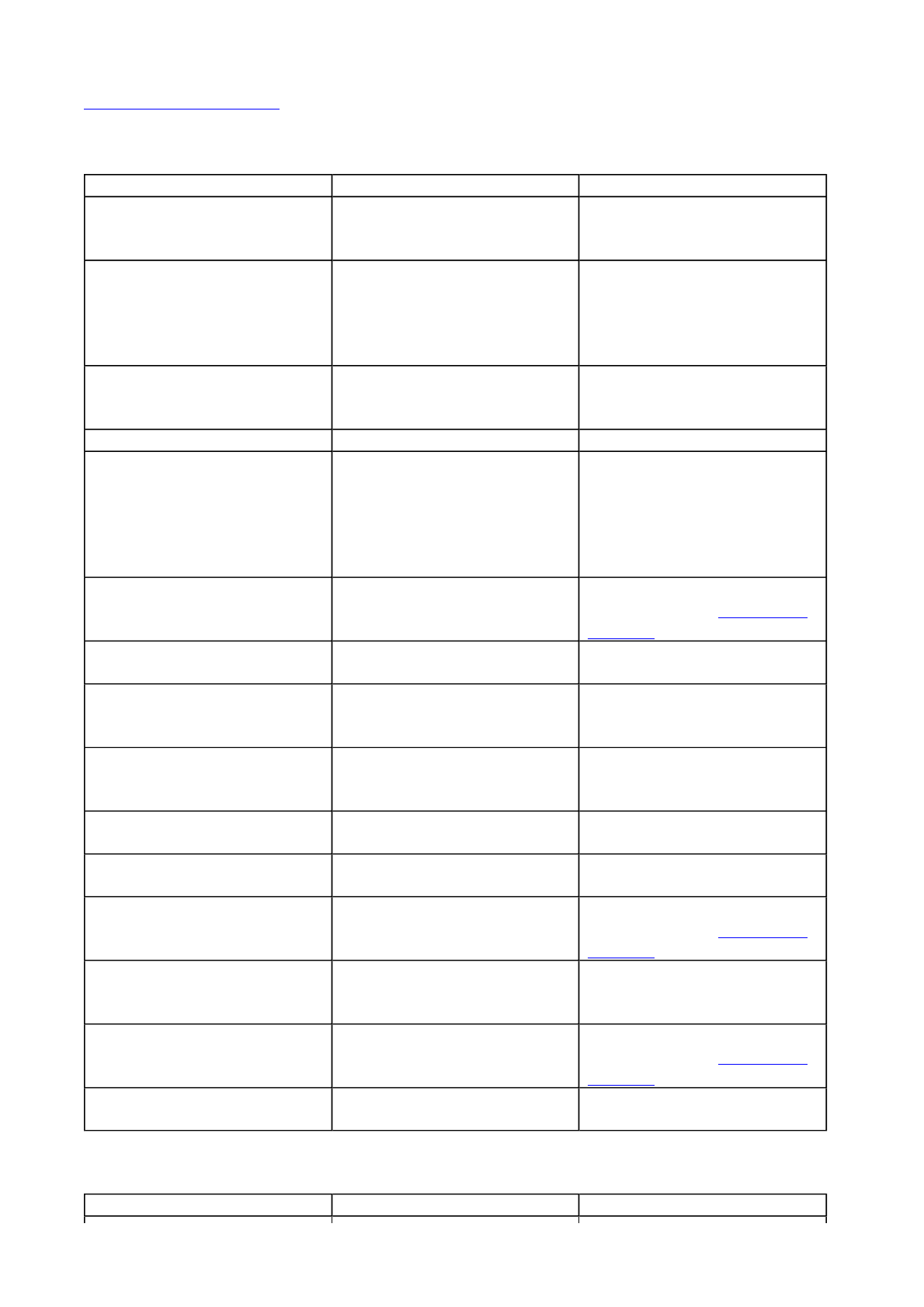
Troubleshooting
If your BC898T is not performing properly, try the following steps.
If you experience difficulty while in TrunkTracker™mode, try the following steps. .
Problem Possible Cause Suggestion
The scanner doesn’t work. The scanner might not be
receiving any power. Make sure the AC adapter
is connected to an AC
outlet and the scanner.
If there is a wall switch that
controls power to the AC
outlet where you connected
the AC adapter, make sure
it is on.
Improper reception. The scanner’s antenna
might need to be adjusted. Check the antenna
connection or move or
reposition the antenna.
Move the scanner.
You might be in a remote
area that could require an
optional multi-band
antenna. Check with your
dealer or local electronics
store.
Scan won’t stop. The squelch might need to
be adjusted. Adjust the squelch
threshold. See Setting the
Squelch.
The antenna might need to
be adjusted. Check the antenna
connection.
One or more channels
might be locked out. Make sure the channels
you want to scan are not
locked out.
. The channel’s frequency
might not be stored in
memory.
Make sure the channel’s
frequency is stored in the
scanner’s memory.
The channel might not be
active. Wait for a transmission on
the channel.
Scan won’t start. You must press SCAN to
scan. Press SCAN.
The squelch might need to
be adjusted. Adjust the squelch
threshold. See Setting the
Squelch.
One or more channels
might be locked out. Make sure the channels
you want to scan are not
locked out.
Weather scan doesn’t
work. The squelch might need to
be adjusted. Adjust the squelch
threshold. See Setting the
Squelch.
The antenna might need to
be adjusted. Check the antenna
connection.
Problem Possible Cause Suggestion
98/305 ページCONTENTS
2004/04/01file://¥¥Fileserv0¥OM¥UB322Z_BC898¥Software%20Help.htm

If you still cannot get satisfactory results while using your scanner
or if you want additional information, please call or write the Uniden
Parts and Service Division. The address and phone number are
listed in the Warranty at the end of this manual. If you would like
immediate assistance, please call Customer Service at (800) 297-
1023.
If you have internet access, you can visit http://www.uniden.com/ for additional information.
Specifications
Certified in accordance with FCC Rules and Regulations Part 15, Subpart C, as of date of
manufacture.
Channels: 500
Banks: 10 (50 channels each)
Scanner won’t track a
trunked system. The system might not be
one your scanner can scan. Scan another system.
The data frequency might
be missing. Enter the data frequency.
The scanner might need to
be changed to a Type 1
scanner setup.
Change to a Type 1
scanner setup. Review
Programming Motorola
Systems..
Scanner won’t stop
scanning during Scan List
mode.
No IDs have been
programmed. Program one more more
IDs.
The IDs you have stored
are not active. Wait for the IDs to become
active or scan another
system.
Scanner won’t acquire the
data channel. The squelch might need to
be adjusted. Adjust the squelch
threshold. See Setting the
Squelch.
The frequency used for the
data channel might be
missing.
Check your frequency list
for the data channel.
Missing replies to
conversations. The scanner might need to
be changed to a Type 1
scanner setup.
Change to a Type 1
scanner setup. Review
Programming Motorola
Systems..
. The fleet map might be
incorrect. Try another preset fleet
map or program your own
fleet map.
One or more of the
system’s frequencies might
not be entered.
Make sure all the system’s
frequencies have been
entered.
Channel activity indicators
are flashing but no sound is
heard.
The transmission you are
trying to scan might be a
private or telephone
interconnect call.
Your scanner blocks
private or telephone
interconnect calls.
The displayed ID might not
be active. Wait for the ID to become
active or scan another
system.
99/305 ページCONTENTS
2004/04/01file://¥¥Fileserv0¥OM¥UB322Z_BC898¥Software%20Help.htm

Service Bands: 17 – preprogrammed search bands (including the NOAA
Weather Service band)
Frequency Range:
25.0-27.995 MHz Citizens Band/Business Band
28.0–29.995 MHz 10 Meter Amateur Band
30–49.995 MHz VHF Low Band
50.0–54.0 MHz 6 Meter Amateur Band
137–143.995 MHz Military Land Mobile
144–147.995 MHz 2 Meter Amateur Band
148–174 MHz VHF High Band
Above bands in 5 kHz steps
108–136.9875 MHz Aircraft Band
216-224.9875 MHz VHF High Band
225–399.9875 MHz UHF Air Band
400–419.9875 MHz Federal Land Mobile
420–449.9875 MHz 70 cm Amateur Band
450–469.9875 MHz UHF Standard Band
470–512 MHz UHF “T” Band
806–823.9875 MHz “800” Band
850-868.9875 MHz “800” Band
895-956 MHz “800” Band
Above bands in 12.5 kHz steps
Operating Temperature: –20°C to +60°C
Scan Rate: 100 channels per second (conventional mode)
Search Rate: 300 steps per second
Scan Delay: 2 seconds
Audio Output: 1.8W nominal into 8W internal speaker
Power Requirements: 12 VDC 500mAh (internal battery or AD140U AC adapter)
Antenna: 50 ohms (Impedance)
External Jacks: Antenna Jack BNC Type
Ext. Speaker Jack 3.5mm
Line Out Jack 3.5mm
AUX Jack RCA Type
DC Power Jack 5.5mm
Remote Jack 5 Pins
Size: 101/2 in. (W) x 73/8 in. (D) x 31/2 in. (H)
Weight: 3.8 lbs
Features, Specifications, and Availability of optional accessories are all subject to change
without notice.
Optional Accessories
Contact your local Uniden Dealer or call the Uniden Parts Center at:
(800)554-3988, 8:00AM to 5:00PM EST, Monday through Friday,
for information about ordering these optional accessories.
DC Power Cord
Cigarette Lighter Power Cord ®
External Speaker Earphone Mobile Mounting Bracket with Hardware (MB001)
Betty Bearcat Frequency Directory/Local Directories
100/305 ページCONTENTS
2004/04/01file://¥¥Fileserv0¥OM¥UB322Z_BC898¥Software%20Help.htm

User Defined Fleet Maps
Type I Programming Information
When a Type I system is designed, the address information for all
the IDs is divided into 8 equal sized blocks, numbered 0–7. When
you program your scanner to track a Type I system, you must
select a size code for each of these blocks. When you have
assigned a size code to all 8 blocks, you’ll have defined the fleet
map for the system you are tracking. Each size code determines
the number of fleets, subfleets, and IDs each block will have. For
example, a size code of S-4 has one fleet, which is divided into 16
separate subfleets, and it has a total of 512 individual IDs.
When a block is assigned a size code, the fleet or fleets created
within the block are assigned a Type I ID. The way these IDs
display on your scanner depend on the block number and the
block’s size code. When a Type I ID appears, the leftmost digit
represents the block which contains the ID.
The next two digits identify which fleet is active, and the last digit(s) identifies the subfleet.
The details concerning how the size codes are selected by a Type I
System designer are highly dependent on the specific needs of the
system’s users. Some organizations might want many subfleets
with only a few radios each, while another organization might want
only a few subfleets with many radios each. Your task is to program
your fleet map with the same size code assignments as the trunked
system. If you do this accurately, you’ll track all the Fleet-Subfleet
combinations used by the system. In other words, you’ll hear
complete communications while monitoring a trunked system.
58
If you don’t already know the size codes used, you’ll have to
guess at them. But since you don’t have to figure out all the
blocks at once, this isn’t as hard as it seems. Select a size code
for a block, and then press S. Now listen to the communications.
If you decide you are receiving most of the replies to the
conversations with IDs assigned to the block you just
programmed, then you’ve probably selected the right size code
and can work on the next block of the map.
Finally, for most public safety systems there are some size codes
which are more common. S-3 and S-4 are probably the most
common, followed by S-10, S-11, and S-12.
Size Code Restrictions
If you select size code S-12, S-13, or S-14, there are some restrictions as to which blocks
can be
used for these codes.
S-12 can only be assigned to Blocks 0, 2, 4, or 6.
S-13 can only be assigned to Blocks 0 and 4.
S-14 can only be assigned to Block 0.
105/305 ページCONTENTS
2004/04/01file://¥¥Fileserv0¥OM¥UB322Z_BC898¥Software%20Help.htm

Since these size codes require multiple blocks, you will be
prompted for the next available block when
programming a fleet map. For example, if you assign Block 0 as an
S-12, you will be prompted for b2, the next block available, instead
of b1. And if you assign Block 0 as an S-14, you would not see
another prompt because it uses all available blocks.
One Year Limited Warranty
Important: Evidence of original purchase is required for warranty service.
WARRANTOR: UNIDEN AMERICA CORPORATION (“Uniden”)
ELEMENTS OF WARRANTY: Uniden warrants, for one year, to the
original retail owner, this Uniden Product to be free from defects in
materials and craftsmanship with only the limitations or exclusions
set out below.
WARRANTY DURATION: This warranty to the original user shall
terminate and be of no further effect 12 months after the date of
original retail sale. The warranty is invalid if the Product is (A)
damaged or not maintained as reasonable or necessary, (B)
modified, altered, or used as part of any conversion kits,
subassemblies, or any configurations not sold by Uniden, (C)
improperly installed, (D) serviced or repaired by someone other
than an authorized Uniden service center for a defect or
malfunction covered by this warranty, (E) used in any conjunction
with equipment or parts or as part of any system not manufactured
by Uniden, or (F) installed or programmed by anyone other than as
detailed by the Operating Guide for this product. STATEMENT OF
REMEDY: In the event that the product does not conform to this
warranty at any time while this warranty is in effect, warrantor will
repair the defect and return it to you without charge for parts,
service, or any other cost (except shipping and handling) incurred
by warrantor or its representatives in connection with the
performance of this warranty. THE LIMITED WARRANTY
SET FORTH ABOVE IS THE SOLE AND ENTIRE WARRANTY
PERTAINING TO THE PRODUCT AND IS IN LIEU OF AND
EXCLUDES ALL OTHER WARRANTIES OF ANY NATURE
WHATSOEVER, WHETHER EXPRESS, IMPLIED OR ARISING
BY OPERATION OF LAW, INCLUDING, BUT NOT LIMITED TO
ANY IMPLIED WARRANTIES OF MERCHANTABILITY OR
FITNESS FOR A PARTICULAR PURPOSE. THIS WARRANTY
DOES NOT COVER OR PROVIDE FOR THE REIMBURSEMENT
OR PAYMENT OF INCIDENTAL OR CONSEQUENTIAL
DAMAGES. Some states do not allow this exclusion or limitation of
incidental or consequential damages so the above limitation or
exclusion might not apply to you.
LEGAL REMEDIES: This warranty gives you specific legal rights,
and you might also have other rights which vary from state to state.
This warranty is void outside the United States of America.
PROCEDURE FOR OBTAINING PERFORMANCE OF
WARRANTY: If, after following the instructions in this Operating
Guide you are certain that the Product is defective, pack the
106/305 ページCONTENTS
2004/04/01file://¥¥Fileserv0¥OM¥UB322Z_BC898¥Software%20Help.htm

Product carefully (preferably in its original packaging). Include
evidence of original purchase and a note describing the defect that
has caused you to return it. The Product should be shipped freight
prepaid, by traceable means, or delivered, to warrantor at:
Uniden America Corporation
Parts and Service Division
4700 Amon Carter Boulevard
Fort Worth, TX 76155
(800) 297-1023, 8:00 a.m. to 5:00 p.m., Central, Monday through Friday
Covered under one or more of the following U.S. patents:
and other patents pending.
©2004 Uniden America Corporation. All rights reserved.
Printed in the Philippines
107/305 ページCONTENTS
2004/04/01file://¥¥Fileserv0¥OM¥UB322Z_BC898¥Software%20Help.htm

Quick Start to Programming Your Scanner
This help contains information you’ll need to quickly program
conventional and trunking frequencies into your scanner. You can
use it to help you find information about conventional and trunking
frequencies in your area, compile the information into an easy-to-
use format, then use the information to program your scanner.
Note: This help does not include all of the programming information
for your scanner. Consult your Owners Manual for complete
information about how to program your scanner.
Getting Started
You can use the scanner to scan agencies such as:
z800 MHz trunked public safety systems
zPolice and fire departments (including rescue and paramedics)
zNOAA weather transmissions
zBusiness and industrial radio
zUtilities
zMarine bands
zAmateur (ham) radio bands
zAircraft
Your scanner can monitor any of the following types of systems.
• Conventional (not trunked) systems
• Motorola trunking systems
• LTR trunking systems
• EDACS trunking systems
Getting your scanner programmed and scanning takes a few steps.
This help guides you through these steps that will make it easier for
you to start scanning.
1. Collect information about the system(s) you want to monitor.
Do you want to listen to your local police and fire
departments? How about the highway patrol, ambulance
service, and aircraft? You might even want to listen to your
local utility company as they track down a break in electrical
service in your area.
Make a list of the agencies you want to listen to, then look up
the frequencies and systems used by those agencies. The
Internet is a great source for current frequencies and
information about scanning. Here are a few useful sites:
o http://www.radioreference.com - the Internet’s premier
source for user-supported radio system information.
108/305 ページCONTENTS
2004/04/01file://¥¥Fileserv0¥OM¥UB322Z_BC898¥Software%20Help.htm

o http://www.scannermaster.com - frequency resources
and home of Police Call.
o http://www.bearcat1.com - frequency information from
National Communications.
o svartifoss2.fcc.gov/reports/index.cfm – conventional
frequency information on file with the US Government
Tips:
• Scanners are designed to monitor complex radio
systems. That means that programming your scanner
might seem like a daunting task at first. Be patient if you
don’t get it right the first time. You can also seek out help
locally for the systems you want to scan by visiting the
forums section of http://www.radioreference.com/.
• Before you start to program your scanner, decide how
you want to organize the frequencies you want to scan.
For example, some areas are best organized by
geographic location (east, north, south, west, central,
etc), while others are best organized by agency (police,
sheriff, ambulance, fire, etc.). You might even find it
easier to organize a mixture of frequencies (north,
southeast, and west for police but fire all in one group for
example).
2. Organize the system information using these system
worksheets included in this help.
• Use the conventional scanning worksheet to organize
information about conventional frequencies.
• Use the Motorola trunking worksheet to organize
information about Motorola frequencies.
• Use the LTR trunking worksheet to organize
information about LTR frequencies.
• Use the EDACS trunking worksheet to organize
information about EDACS frequencies.
3. Follow the instructions in Filling Out the Conventional
Scanning Worksheet, Filling Out the Motorola Worksheet,
Filling Out the LTR Worksheet, and Filling Out the EDACS
Worksheet to program your scanner.
4. Press SCAN!
Tips:
• Before you start, print as many copies of the worksheets as
109/305 ページCONTENTS
2004/04/01file://¥¥Fileserv0¥OM¥UB322Z_BC898¥Software%20Help.htm

you think you’ll need. You can also go to the download section
of www.uniden.com/productsupport.cfm and download the
worksheets there.
• All worksheet instructions assume that you have completed
the critical Step 1 (collecting the system information). Don’t
skip this step.
• Use a pencil to fill out the worksheets. This lets you change
information if necessary.
110/305 ページCONTENTS
2004/04/01file://¥¥Fileserv0¥OM¥UB322Z_BC898¥Software%20Help.htm

Conventional Scanning Worksheet
Instructions
Important: The conventional scanning worksheet is for conventional
frequencies only. To program LTR trunking frequencies, use the
LTR trunking worksheet. To program Motorola trunking frequencies,
use the Motorola trunking worksheet. To program EDACS trunking
frequencies, use the EDACS trunking worksheet.
111/305 ページCONTENTS
2004/04/01file://¥¥Fileserv0¥OM¥UB322Z_BC898¥Software%20Help.htm

Filling Out The Conventional Scanning
Worksheet
zBank
Your scanner has 10 banks. Fill in the letter of the bank (A-
J) you want to use to store all the frequencies on this page.
You can use more than one page for the same bank.
zCategory
Fill in the general type of frequencies to be stored in this
bank. For example, if you want to store all police frequencies
in this bank, enter “Police.” If you want to store more than
one type of frequency in the bank, you can enter “Mixed.”
zChannel
Your scanner has 500 channels. Fill in the channel number
(1-500) where you want to store each frequency.
Tips:
• Try to enter frequencies you write on the worksheet
into consecutively numbered channels. This makes it
easier to keep track of how many channels you have
used.
• Leave this field blank until you gather all information
about the frequencies you want to store. Then go
back and fill in a channel number for each frequency
you entered, beginning with the first open channel in
the bank if possible.
zFrequency
Fill in the frequency you want to store in this channel.
zLocation/Radio Service
Fill in information that identifies the frequency. For example,
if the motorcycle police on your city’s north side use the
frequency, you can enter “City Motorcycle Police North
Side.”
zPriority
The scanner lets you designate one channel in each bank as
a priority channel. Check this field if you want to designate
the frequency as a priority channel.
113/305 ページCONTENTS
2004/04/01file://¥¥Fileserv0¥OM¥UB322Z_BC898¥Software%20Help.htm

zCTCSS/DCS
If the agency transmits a CTCSS or DCS tone on the
frequency, fill in the frequency. For example, if the agency
transmits a CTCSS tone on 173.8 Hz, enter “173.8.”
Note: See What is CTCSS/DCS? in your Owners Manual for
more information about CTCSS and DCS.
zComments
Fill in any general comments about the agency. For
example, if the agency is active only during auto races, enter
that information in this field.
Using The Conventional Scanning Worksheet
to Program Your Scanner
1. If necessary, press MANUAL to stop scanning.
2. Select the bank by entering the letter for the bank you entered
on the worksheet next to Bank. This bank is where the
frequencies you enter will be stored.
3. Use the keypad to enter the first channel number on the
worksheet (next to Channel), then press MANUAL.
4. Use the keypad to enter the first frequency on the worksheet
(next to Frequency), then press E.
Note: To clear a mistake while entering the frequency,
press . (decimal) on the keypad twice, then repeat Step 4.
5. If you checked Priority for the frequency you are entering,
press PRI to set that channel as the priority channel. You can
designate one channel per bank as the priority channel.
6. If you entered a CTCSS/DCS frequency next to CTCSS/DCS
for the frequency you are entering, see Programming a
Channel With a CTCSS/DCS Tone in your Owners Manual for
more information about entering a CTCSS/DCS frequency.
7. Repeat Steps 3 through 6 for each subsequent
channel/frequency listed on the worksheet.
114/305 ページCONTENTS
2004/04/01file://¥¥Fileserv0¥OM¥UB322Z_BC898¥Software%20Help.htm

Motorola Trunking Worksheet
Instructions
Important: The Motorola trunking worksheet is for Motorola
frequencies only. To program conventional scanning frequencies,
use the conventional scanning worksheet. To program LTR trunking
frequencies, use the LTR trunking worksheet. To program EDACS
trunking frequencies, use the EDACS trunking worksheet.
115/305 ページCONTENTS
2004/04/01file://¥¥Fileserv0¥OM¥UB322Z_BC898¥Software%20Help.htm

Filling Out The Motorola Worksheet
zSystem Name
Fill in the general type of frequencies to be stored in this
bank. For example, if you want to store all police frequencies
in this bank, enter “Police.” If you want to store more than
one type of frequency in the bank, you can enter “Mixed.”
zSystem Type
Fill in the type of Motorola system you are scanning.
{Type 1. A fleet map is supplied for this type of system.
{Type 2 800 MHz. The supplied frequencies are between
800 MHz and 899 MHz. No fleet map is supplied for this
type of system.
{Type 2 900 MHz. The supplied frequencies are
between 900 MHz and 999 MHz. No fleet map is
supplied for this type of system.
{Type 2 UHF. The supplied frequencies are between 400
MHz and 500 MHz. No fleet map is supplied for this type
of system.
{Type 2 VHF. The supplied frequencies are between 100
MHz and 200 MHz. No fleet map is supplied for this type
of system.
zBank
Your scanner has 10 banks. Fill in the letter of the bank (A-
J) you want to use to store all the frequencies on this page.
You can use more than one page for the same bank.
zFrequency/Name
For each channel, fill in each frequency and name used by
the agency.
zTalk Group ID/Name
Identifies the agency. The talk group ID is sent by the
agency on the radio system’s control channel, and appears
on your scanner’s display when the talk group is active. You
can group the talk group IDs you want to hear into their own
groups, then write that ID and a name identifying its agency
here.
Fill in the talk group ID and a name for each agency.
174/305 ページCONTENTS
2004/04/01file://¥¥Fileserv0¥OM¥UB322Z_BC898¥Software%20Help.htm

Tip: Leave this field blank until you gather all remaining
information about the agency. Then go back and fill in the
talk group ID and name when you see them on the scanner’s
display.
zFleet Map (Type I or Type I/Type II Hybrid Only)
Fill in the fleet map used by this agency.
zBand Plan (VHF or UHF Only)
A band plan is required so the scanner can correctly
determine the voice channel frequency. Fill in the band plan
used by this agency, consisting of:
{Base frequency
{Step frequency
{Channel offset
You can enter up to three band plans.
Using The Motorola Worksheet to Program
Y
our Scanner
1. Hold down TRUNK for about 2 seconds. The scanner beeps
and TRUNK, BANK, and the bank letters A-J blink.
2. Select the bank by entering the letter for the bank you entered
on the worksheet next to Bank. This bank is where the
frequencies you enter will be stored.
3. Select Motorola scanning by turning the rotary tuner or
repeatedly pressing HOLD U or LIMIT V to select the
Motorola scanning choice you entered next to System Type:
zE2-800 (Motorola Type 2 800 MHz)
zE2-900 (Motorola Type 2 900 MHz)
zE2-Hi (Motorola Type 2 VHF)
zE2-UHF (Motorola Type 2 UHF)
zE1 (Motorola Type 1)
Then press E.
4. Use the keypad to enter the first frequency you entered on the
worksheet next to Frequency, then press E.
Note: To clear a mistake while entering a frequency, press .
(decimal) on the keypad twice, then repeat Step 4.
5. Repeat Step 4 for each frequency you entered on the
worksheet next to Frequency. When you enter a frequency,
select the next channel by turning the rotary tuner or
repeatedly pressing HOLD U or LIMIT V to select the next
175/305 ページCONTENTS
2004/04/01file://¥¥Fileserv0¥OM¥UB322Z_BC898¥Software%20Help.htm

channel in the bank. Then press E
6. If you entered Motorola Type 1 or a hybrid Type I/Type II next
to System Type, you must select a fleet map. If you entered
anything else next to System Type, skip to Step 7.
d. Turn the rotary tuner or repeatedly press HOLD U or
LIMIT Vuntil E1 appears. Then press E.
e. Select the fleet map list by turning the rotary tuner or
repeatedly pressing HOLD U or LIMIT Vuntil FLEEt
appears. Then press E.
f. Select a preset fleet map from the list by turning the
rotary tuner or repeatedly pressing HOLD U or LIMIT
Vuntil the fleet map you want appears (P1 to P12). Then
press E.
Note: You can also program and use your own fleet map in
this step. Consult your Owners Manual for more information.
7. If you entered Motorola Type II VHF or Motorola Type II UHF
next to System Type, you must enter the band plan (base
frequency, spacing frequency, and offset channel) for the
system you want to scan. If you entered anything else next to
System Type, stop here.
e. Turn the rotary tuner or repeatedly press HOLD U or
LIMIT Vuntil bASE appears. Then press E.
f. Select the band plan by pressing A, B, or C.
g. Use the keypad to enter the base frequency, step
frequency (within a range of 5-100 kHz), and channel
offset (within a range of 380-759) you entered in Band
Plan. Then press E.
h. If the system uses more than one band plan, repeat
Steps a-c.
8. Enter the talk group ID for each group you entered on the
worksheet next to Talk Group ID:
c. Repeatedly press HOLD U or LIMIT Vuntil Prog id
appears. Then press E.
d. To enter a Type 2 ID, use the keypad to enter it. Then
press E. Otherwise, to enter a Type 1 ID, use the keypad
to enter the fleet map information you entered next to
Fleet Map or selected in Step 6. Then press E.
176/305 ページCONTENTS
2004/04/01file://¥¥Fileserv0¥OM¥UB322Z_BC898¥Software%20Help.htm

LTR Trunking Worksheet Instructions
Important: The LTR trunking worksheet is for LTR frequencies
only. To program conventional scanning frequencies, use the
conventional scanning worksheet. To program Motorola trunking
frequencies, use the Motorola trunking worksheet. To program
EDACS trunking frequencies, use the EDACS trunking worksheet.
177/305 ページCONTENTS
2004/04/01file://¥¥Fileserv0¥OM¥UB322Z_BC898¥Software%20Help.htm

Filling Out The LTR Worksheet
zSystem Name
Fill in the general type of frequencies to be stored in this
bank. For example, if you want to store all police frequencies
in this bank, enter “Police.” If you want to store more than
one type of frequency in the bank, you can enter “Mixed.”
zBank
Your scanner has 10 banks. Fill in the letter of the bank (A-
J) you want to use to store all the frequencies on this page.
You can use more than one page for the same bank.
zSystem Frequencies
For each channel, fill in the frequency and alpha tag used by
the agency.
zTalk Group ID/Name
Identifies the agency. The talk group ID is sent by the
agency on the radio system’s control channel, and appears
on your scanner’s display when the talk group is active. You
can group the talk group IDs you want to hear into their own
groups, then write that ID and a name identifying its agency
here.
Fill in the talk group ID and a name for each agency.
Tip: Leave this field blank until you gather all remaining
information about the agency. Then go back and fill in the
talk group ID and name when you see them on the scanner’s
display.
Using The LTR Worksheet to Program Your
Scanner
1. Hold down TRUNK for about 2 seconds. The scanner beeps
and TRUNK, BANK, and the bank letters A-J blink.
2. Select the bank by entering the letter for the bank you entered
on the worksheet next to Bank. This bank is where the
frequencies you enter will be stored.
3. Select LTR scanning by turning the rotary tuner or repeatedly
pressing HOLD U or LIMIT V to select Lt. Then press E.
4. Enter the talk group ID (area code, home repeater, and user
234/305 ページCONTENTS
2004/04/01file://¥¥Fileserv0¥OM¥UB322Z_BC898¥Software%20Help.htm

ID) for the system you want to scan, then press E.
5. If the system uses multiple talk group IDs, repeat Step 4.
6. Use the keypad to enter the first frequency you entered on the
worksheet next to Frequency, then press E.
Note: To clear a mistake while entering a frequency, press .
(decimal) on the keypad twice, then repeat Step 4.
7. Repeat Step 6 for each frequency you entered on the
worksheet next to Frequency. When you enter a frequency,
select the next channel by turning the rotary tuner or
repeatedly pressing HOLD U or LIMIT V to select the next
channel in the bank. Then press E
235/305 ページCONTENTS
2004/04/01file://¥¥Fileserv0¥OM¥UB322Z_BC898¥Software%20Help.htm

EDACS Trunking Worksheet Instructions
Important: The EDACS trunking worksheet is for EDACS
frequencies only. To program conventional scanning frequencies,
use the conventional scanning worksheet. To program Motorola
trunking frequencies, use the Motorola trunking worksheet. To
program LTR trunking frequencies, use the LTR trunking
worksheet.
236/305 ページCONTENTS
2004/04/01file://¥¥Fileserv0¥OM¥UB322Z_BC898¥Software%20Help.htm

Filling Out The EDACS Worksheet
zSystem Name
Fill in the general type of frequencies to be stored in this
bank. For example, if you want to store all police frequencies
in this bank, enter “Police.” If you want to store more than
one type of frequency in the bank, you can enter “Mixed.”
zBank
Your scanner has 10 banks. Fill in the letter of the bank (A-
J) you want to use to store all the frequencies on this page.
You can use more than one page for the same bank.
zSystem Frequencies
For each channel, fill in the frequency and name.
zTalk Group ID/Name
Identifies the agency. The talk group ID is sent by the
agency on the radio system’s control channel, and appears
on your scanner’s display when the talk group is active. You
can group the talk group IDs you want to hear into their own
groups, then write that ID and a name identifying its agency
here.
EDACS talk group IDs are in the form AFS, where:
• A is the agency (00 through 15)
• F is the fleet (00 through 15)
• S is the subfleet (0 through 7)
Note: You can also set the scanner so it displays EDACS
talk group IDs in decimal form. Consult your Owners Manual
for more information.
You can enter a full or partial talk group ID. For example, if
you enter the agency and the fleet but do not enter a
subfleet, the scanner scans all subfleets within the fleet you
entered.
Fill in the talk group ID and a name for each agency.
Using The EDACS Worksheet to Program Your
Scanner
1. Hold down TRUNK for about 2 seconds. The scanner beeps
and TRUN
K
, BAN
K
, and the bank letters A-J blink.
293/305 ページCONTENTS
2004/04/01file://¥¥Fileserv0¥OM¥UB322Z_BC898¥Software%20Help.htm

2. Select the bank by entering the letter for the bank you entered
on the worksheet next to Bank. This bank is where the
frequencies you enter will be stored.
3. Select EDACS scanning by turning the rotary tuner or
repeatedly pressing HOLD U or LIMIT V to select the EDACS
scanning choice you entered next to Scan Type:
zEd-Hi (Wideband, 9600 bps)
zEd-Lo (Narrowband, 4800 bps)
zEd-SCt (SCAT)
Then press E.
4. Enter the talk group ID (agency, fleet, and subfleet) for the
system you want to scan, then press E.
If the system uses multiple talk group IDs, repeat Step 4.
5. Use the keypad to enter the frequency you entered on the
worksheet under Frequency for LCN1, then press E.
Note: To clear a mistake while entering a frequency, press .
(decimal) on the keypad twice, then repeat Step 5.
6. Repeat Step 5 for each frequency you entered on the
worksheet under Frequency. When you enter a frequency,
select the next channel by turning the rotary tuner or
repeatedly pressing HOLD U or LIMIT V to select the next
channel in the bank. Then press E.
294/305 ページCONTENTS
2004/04/01file://¥¥Fileserv0¥OM¥UB322Z_BC898¥Software%20Help.htm